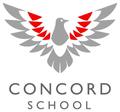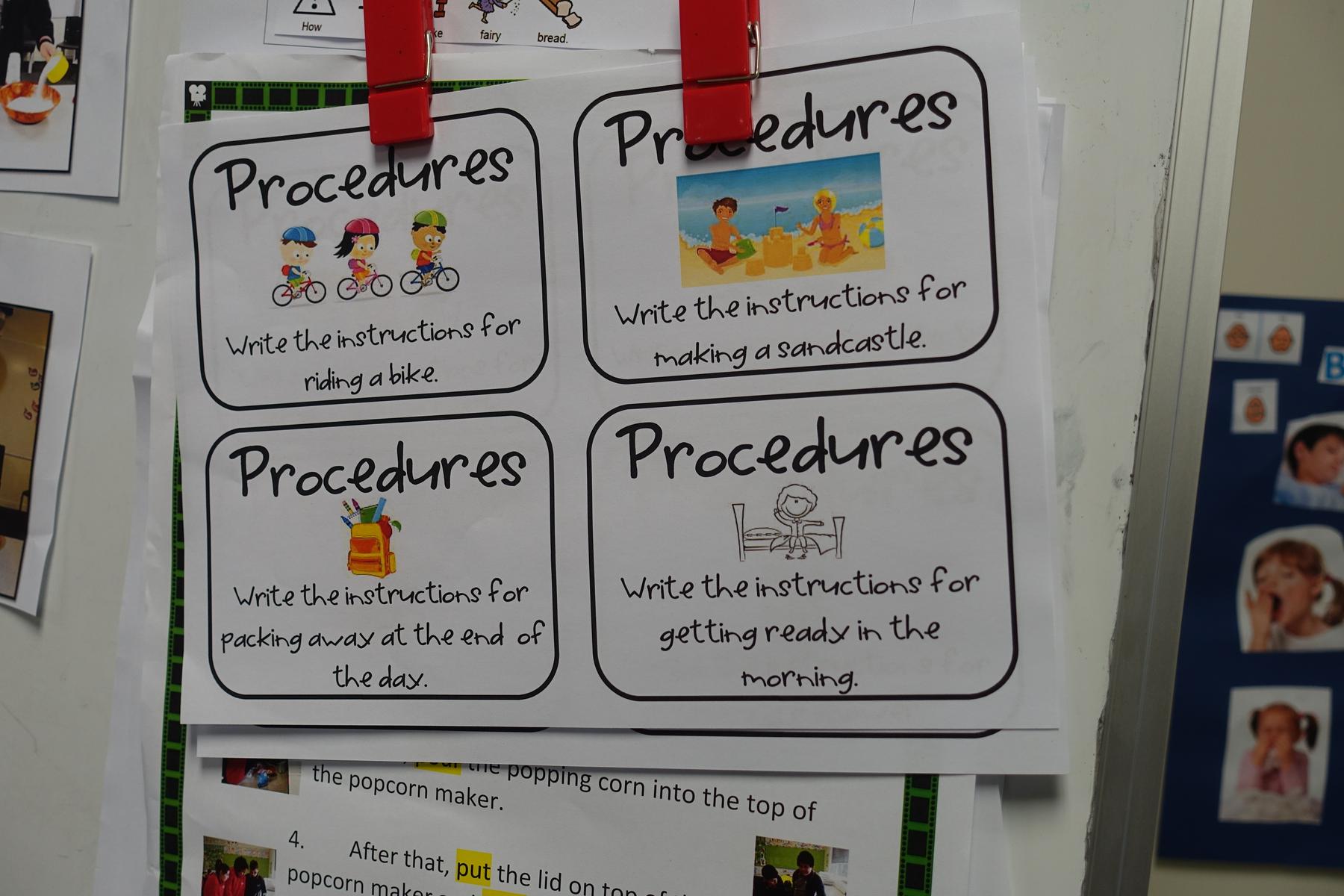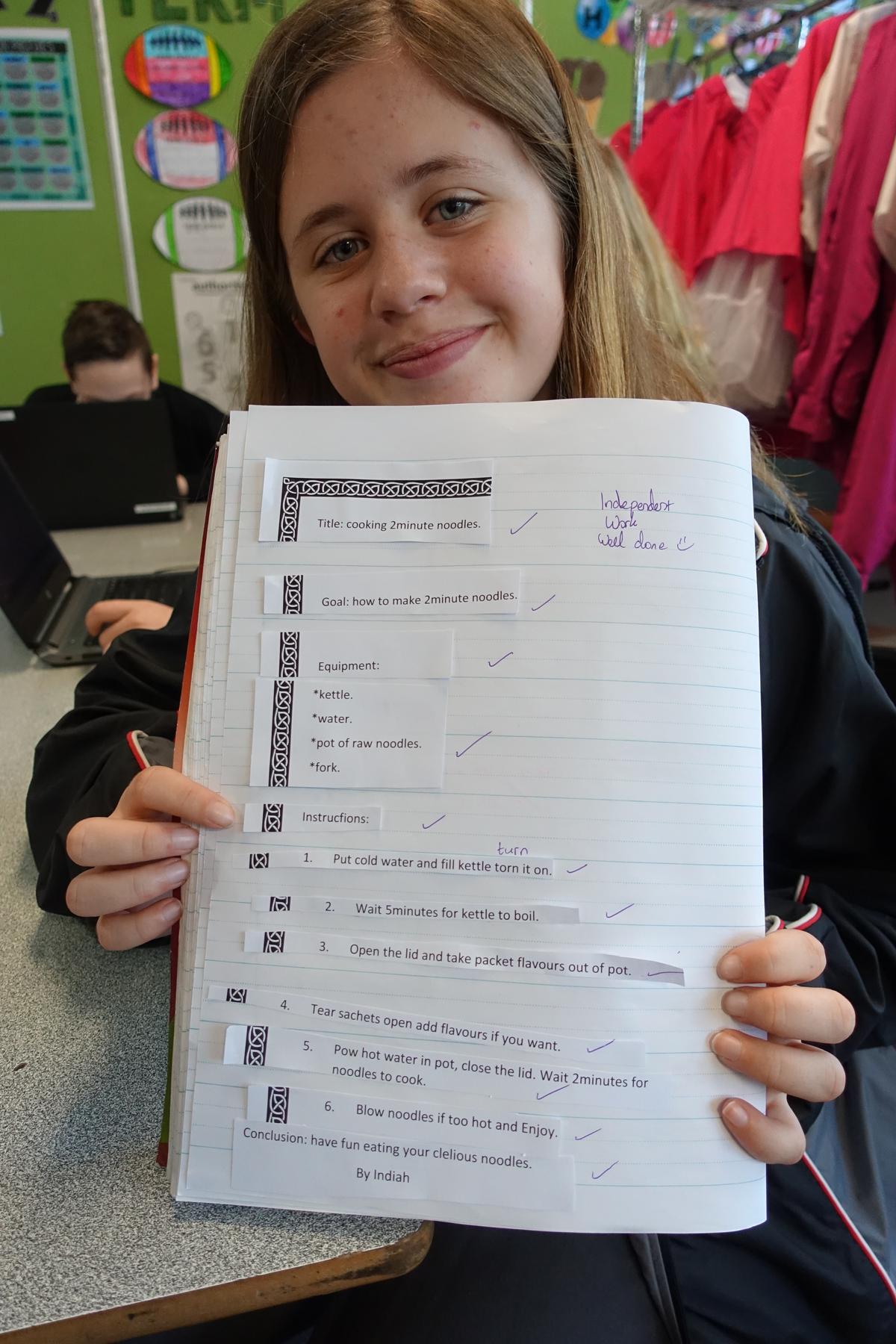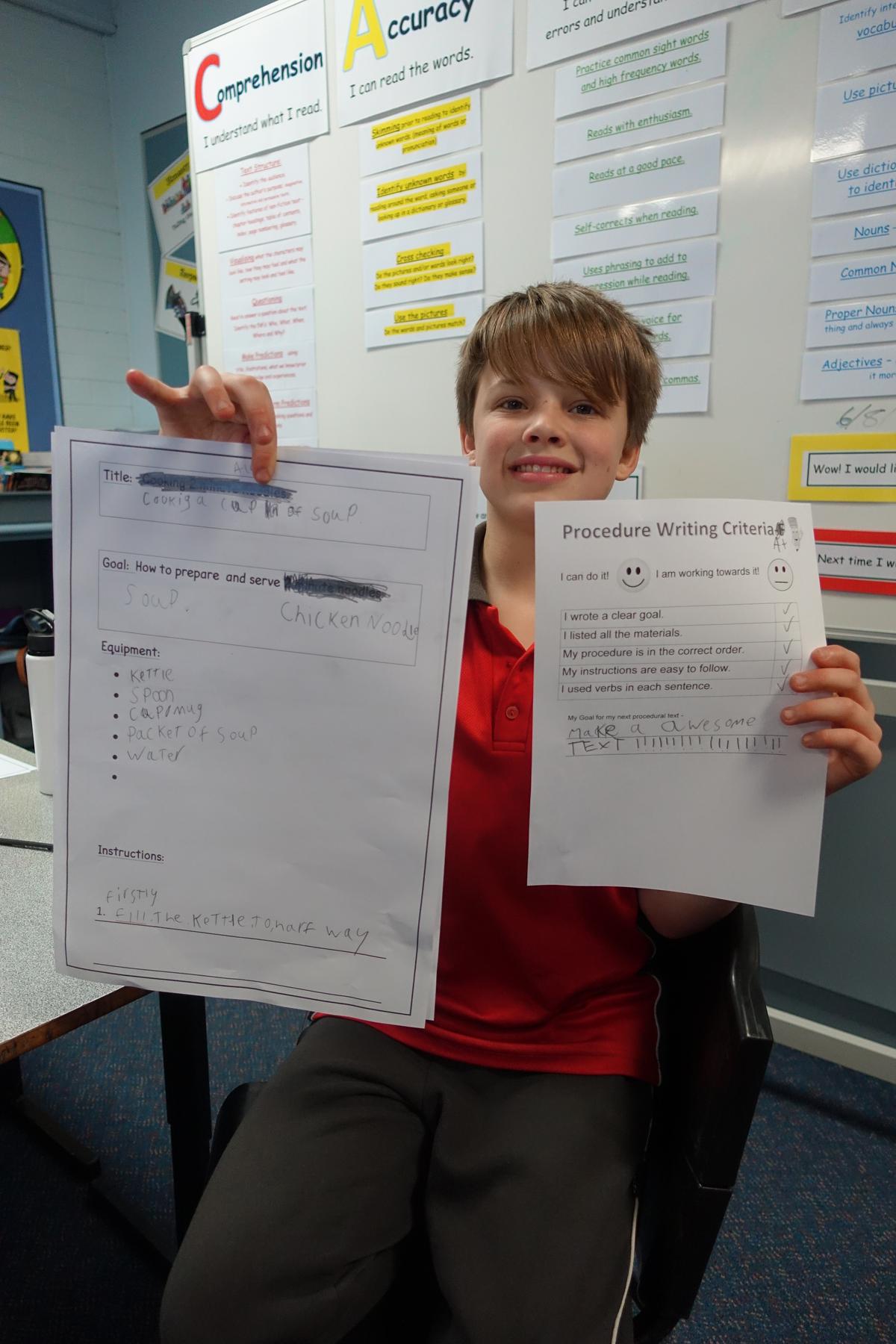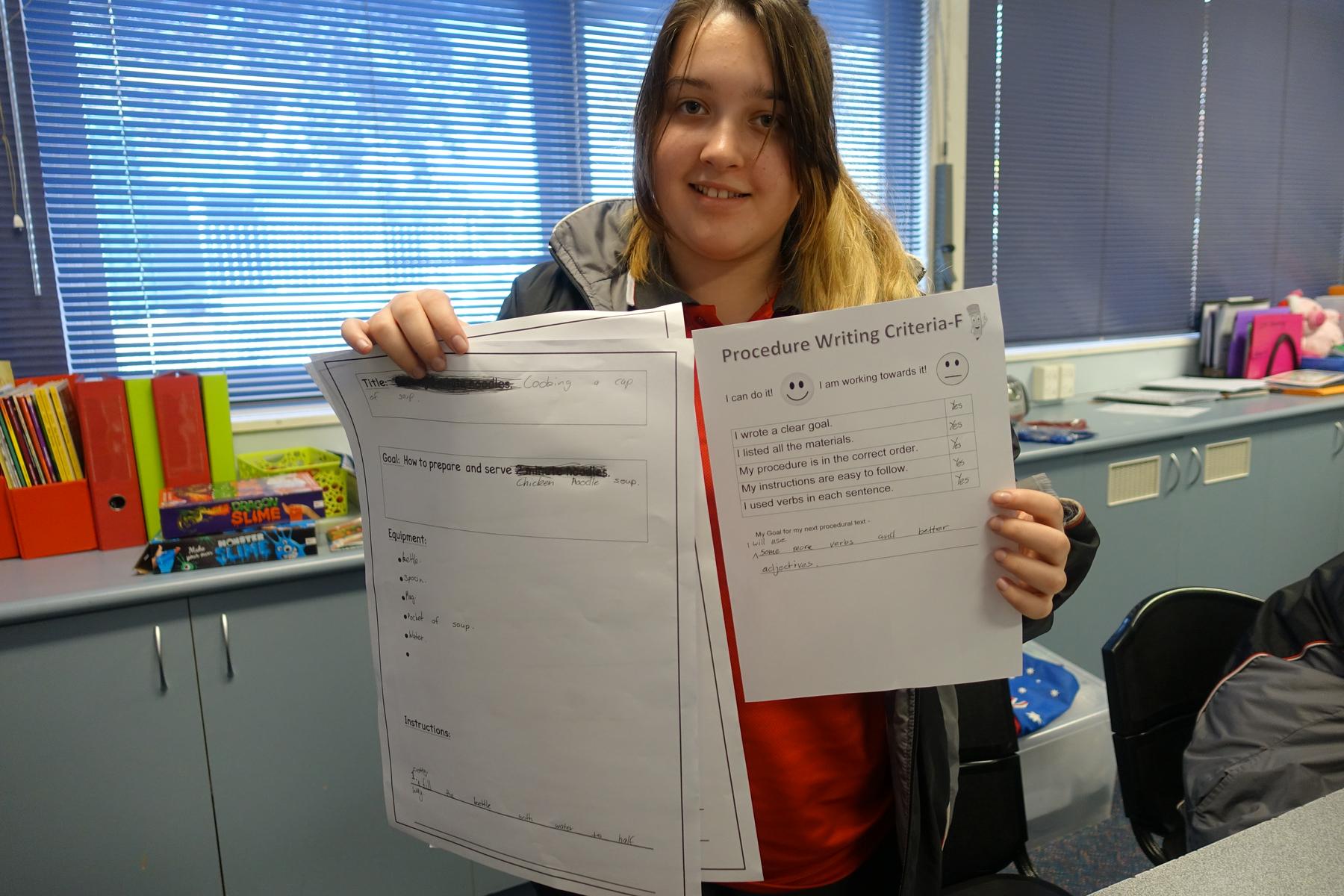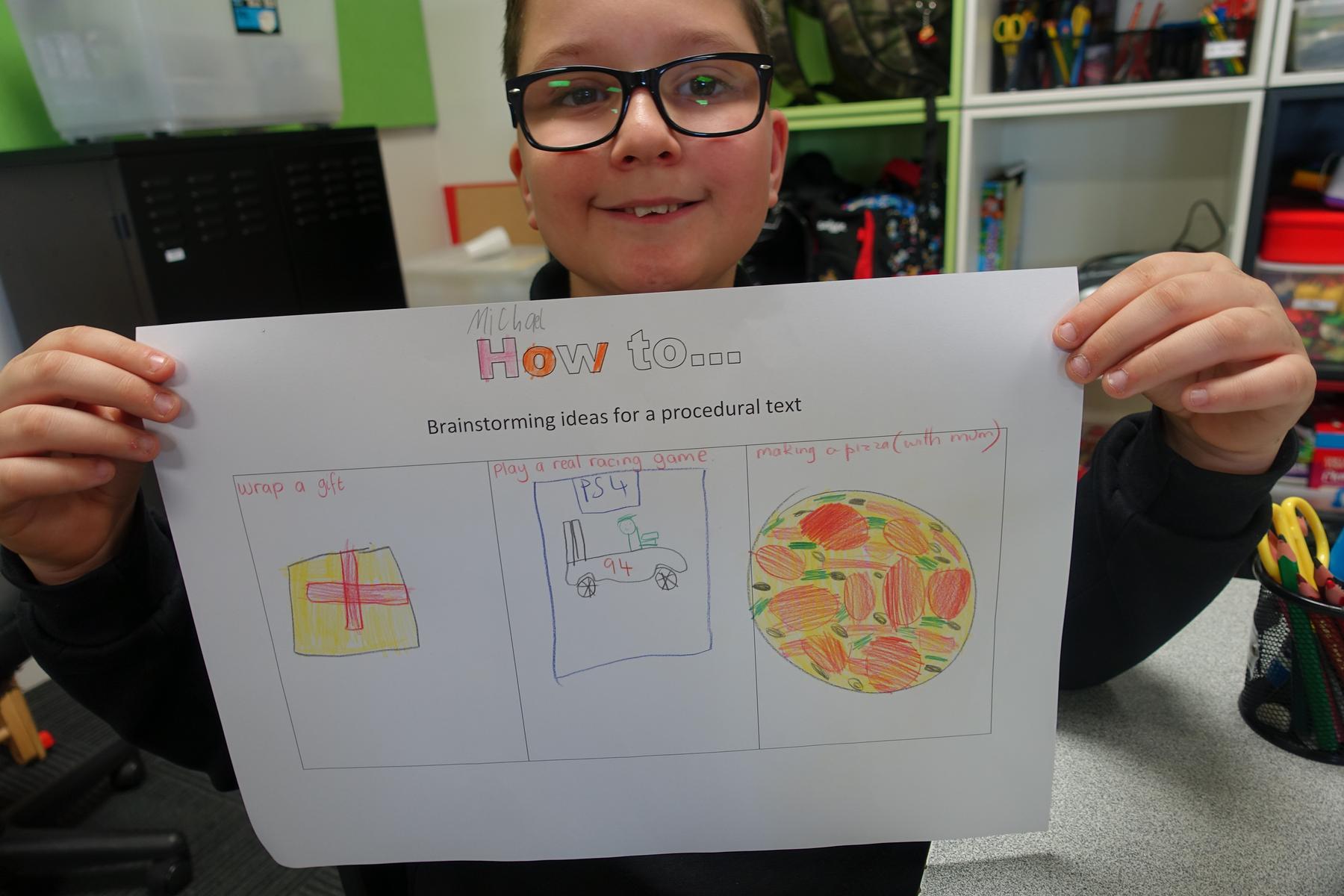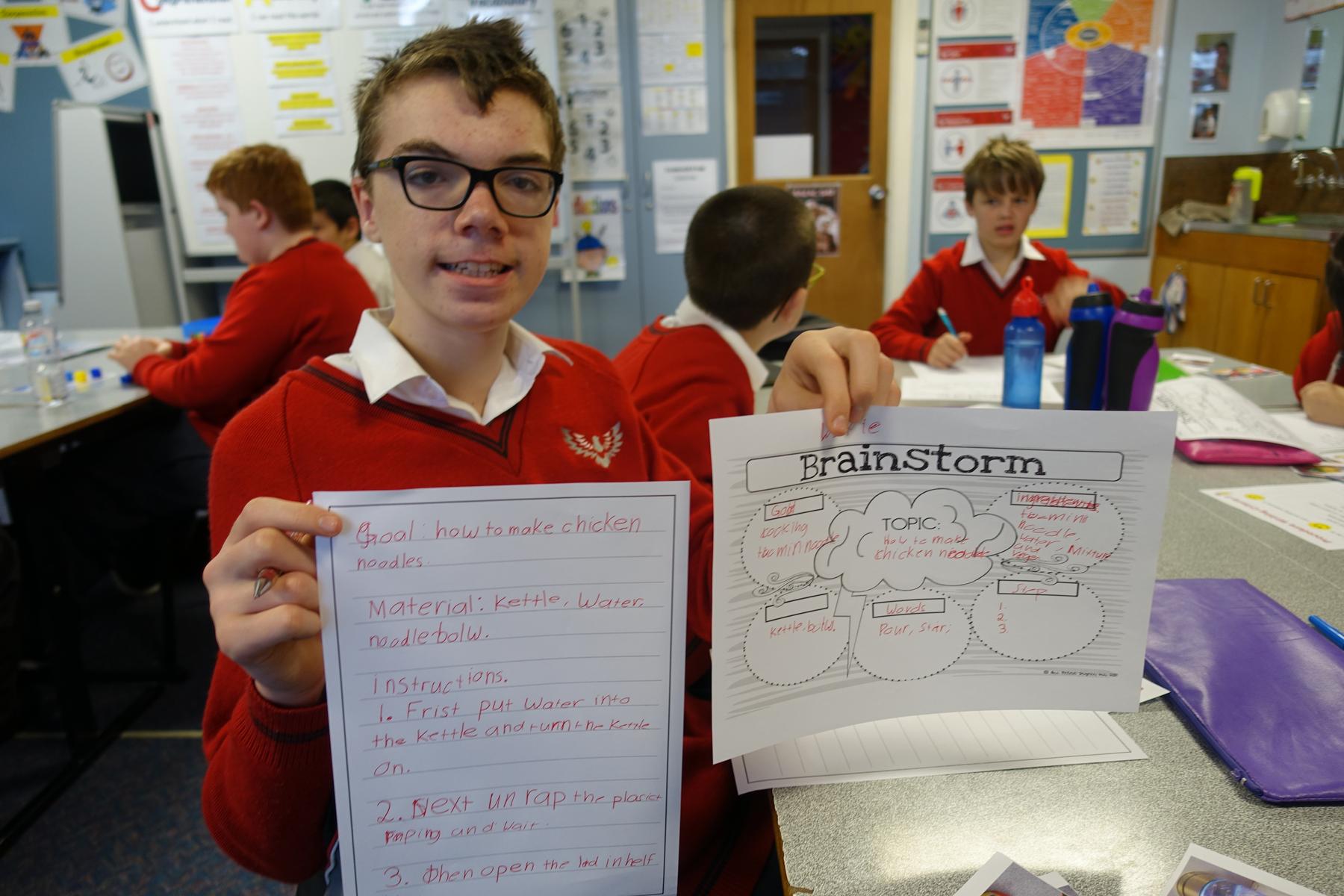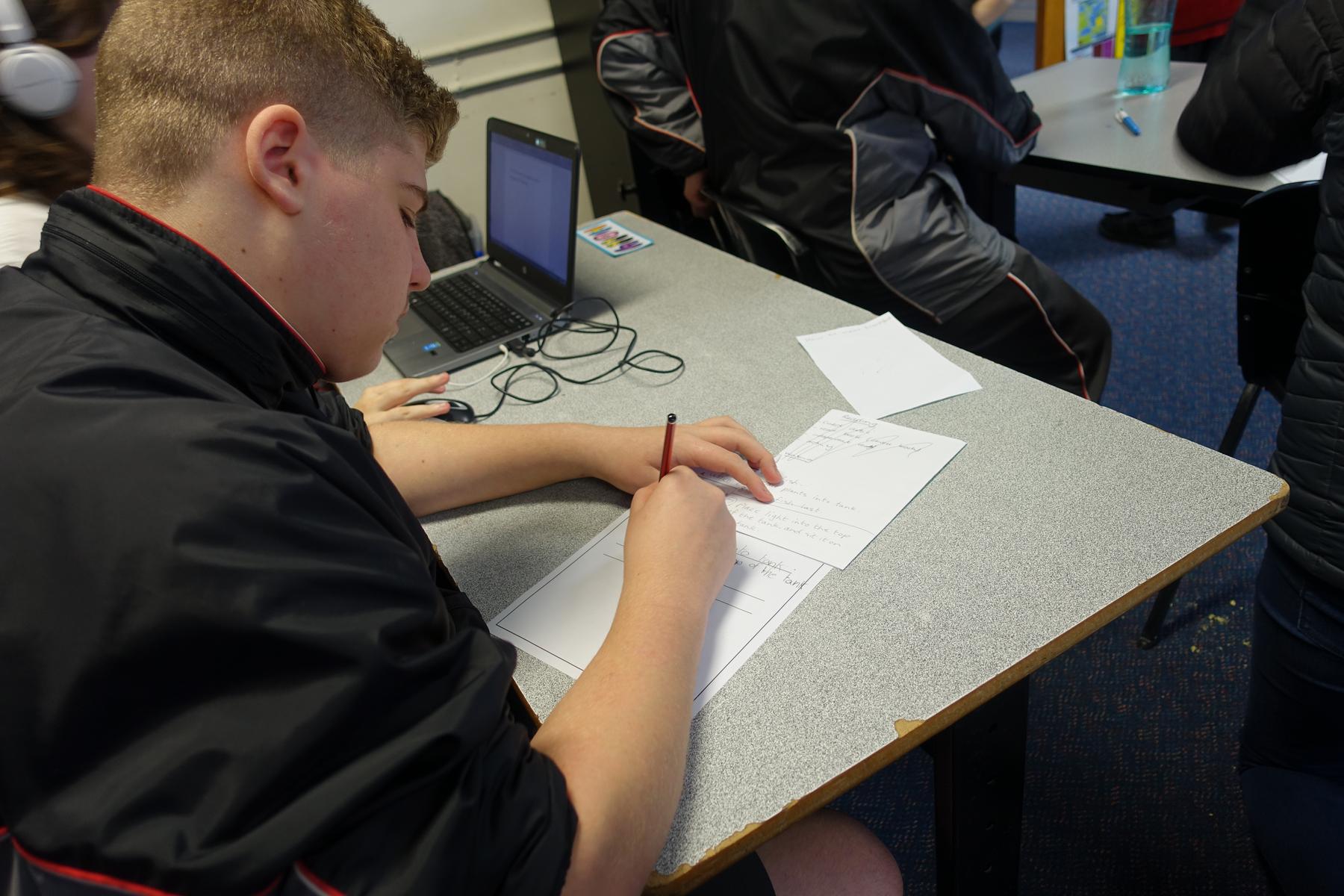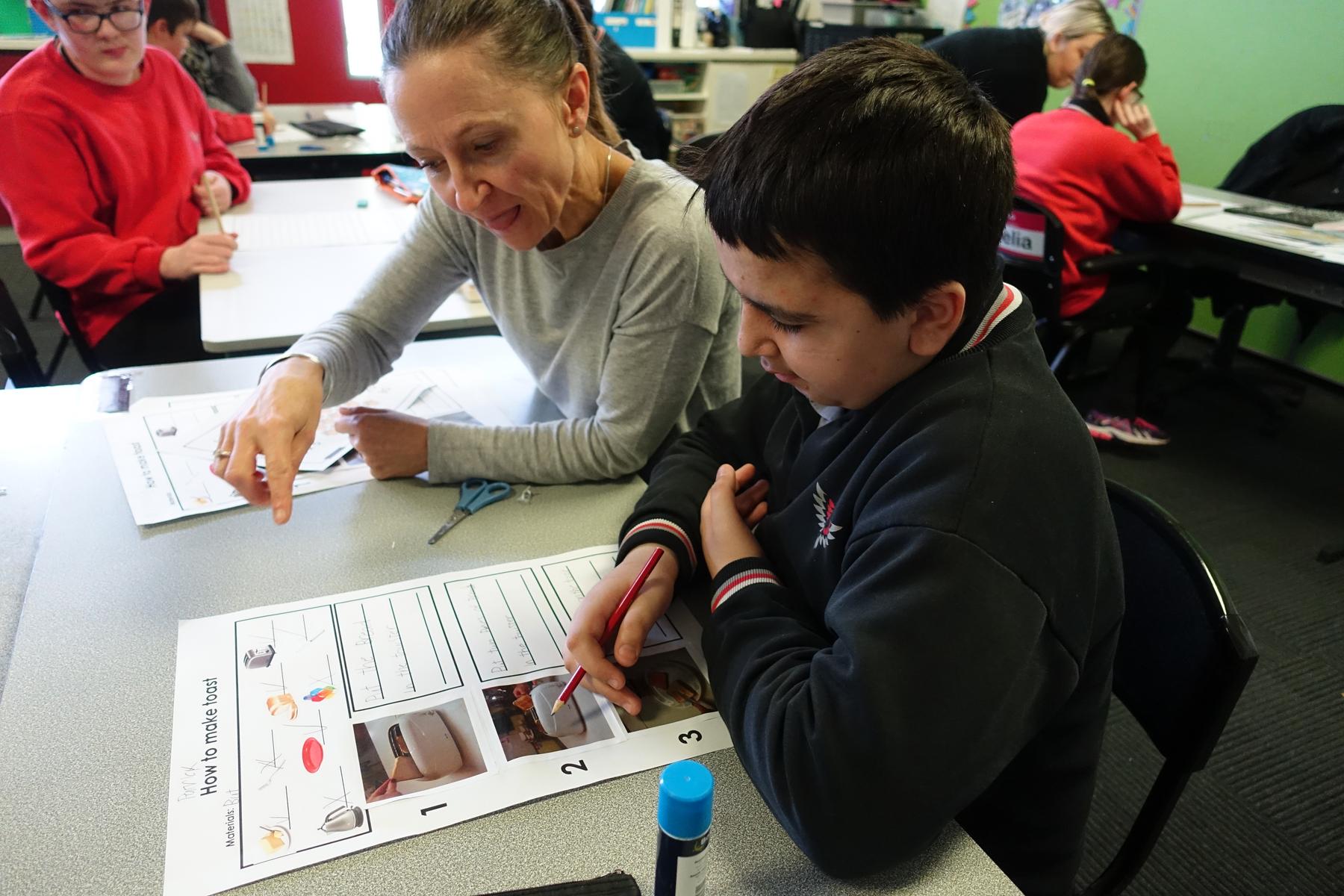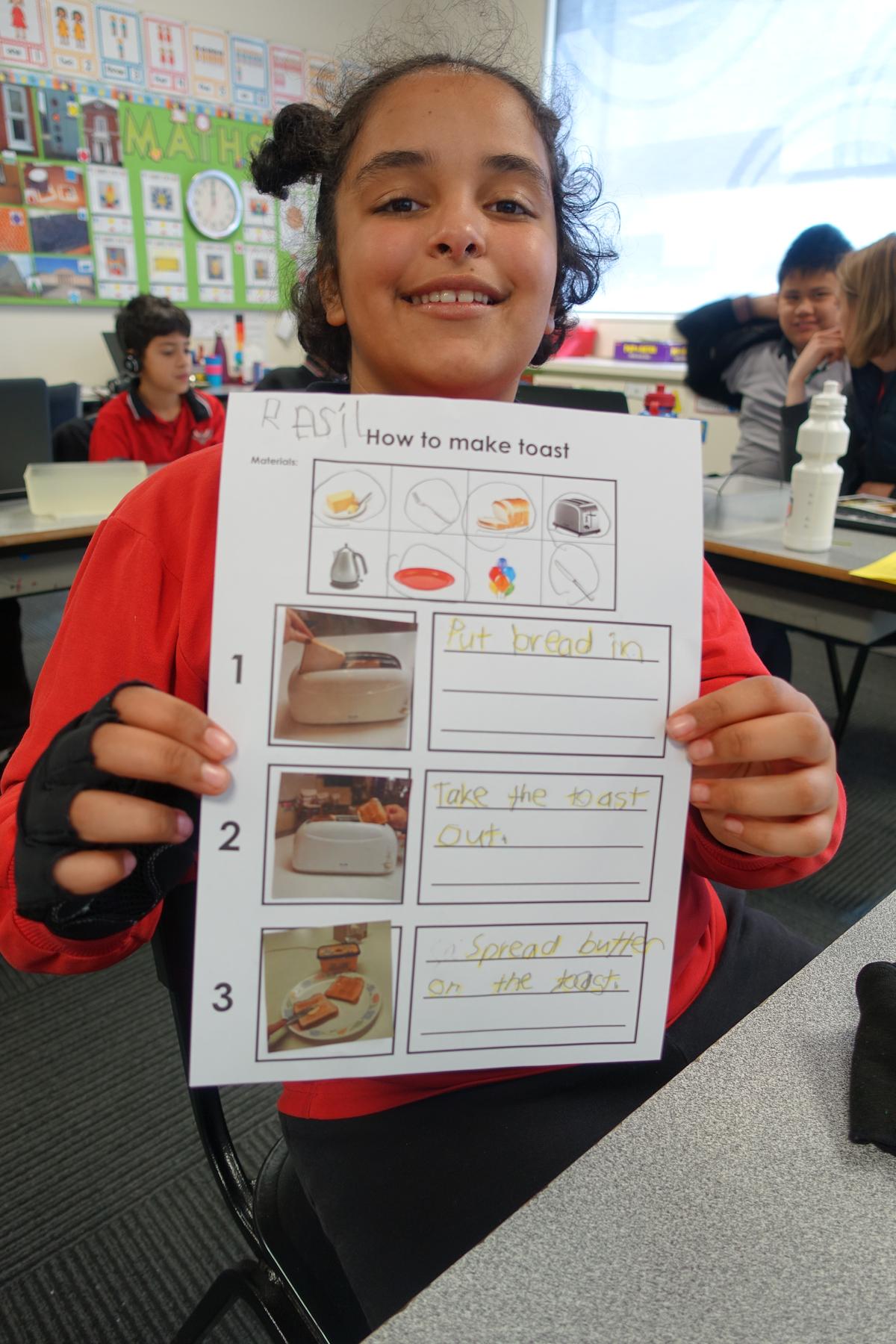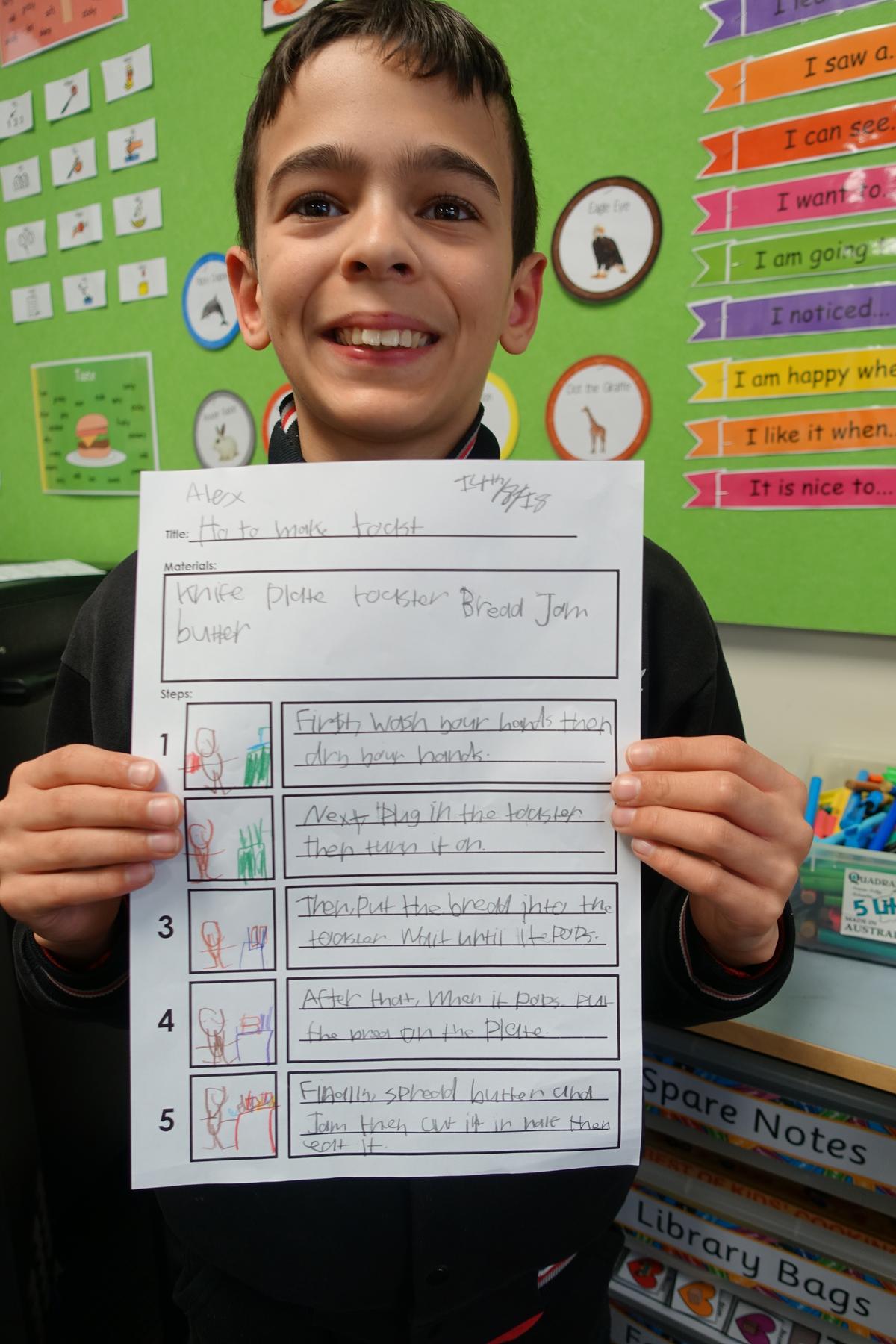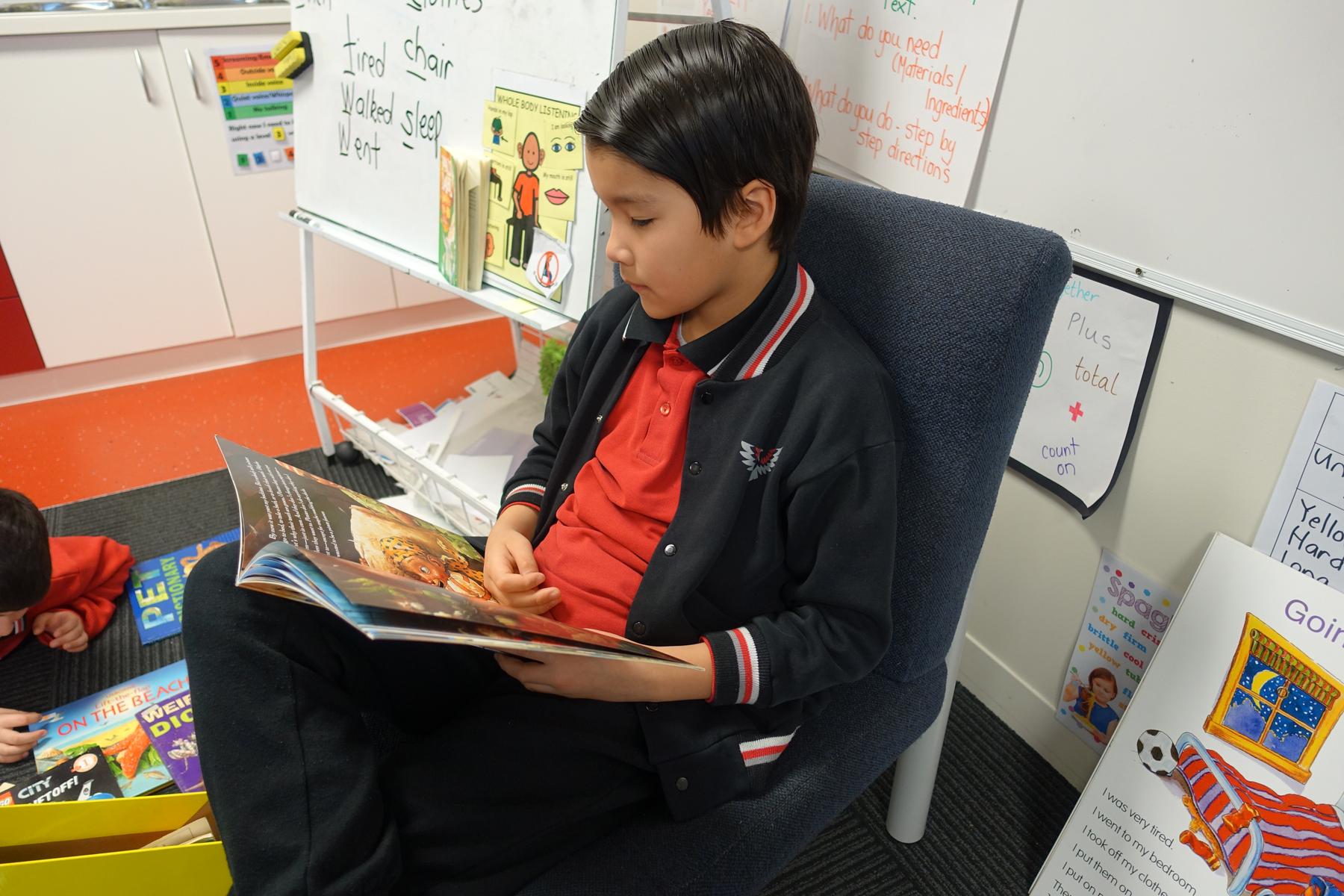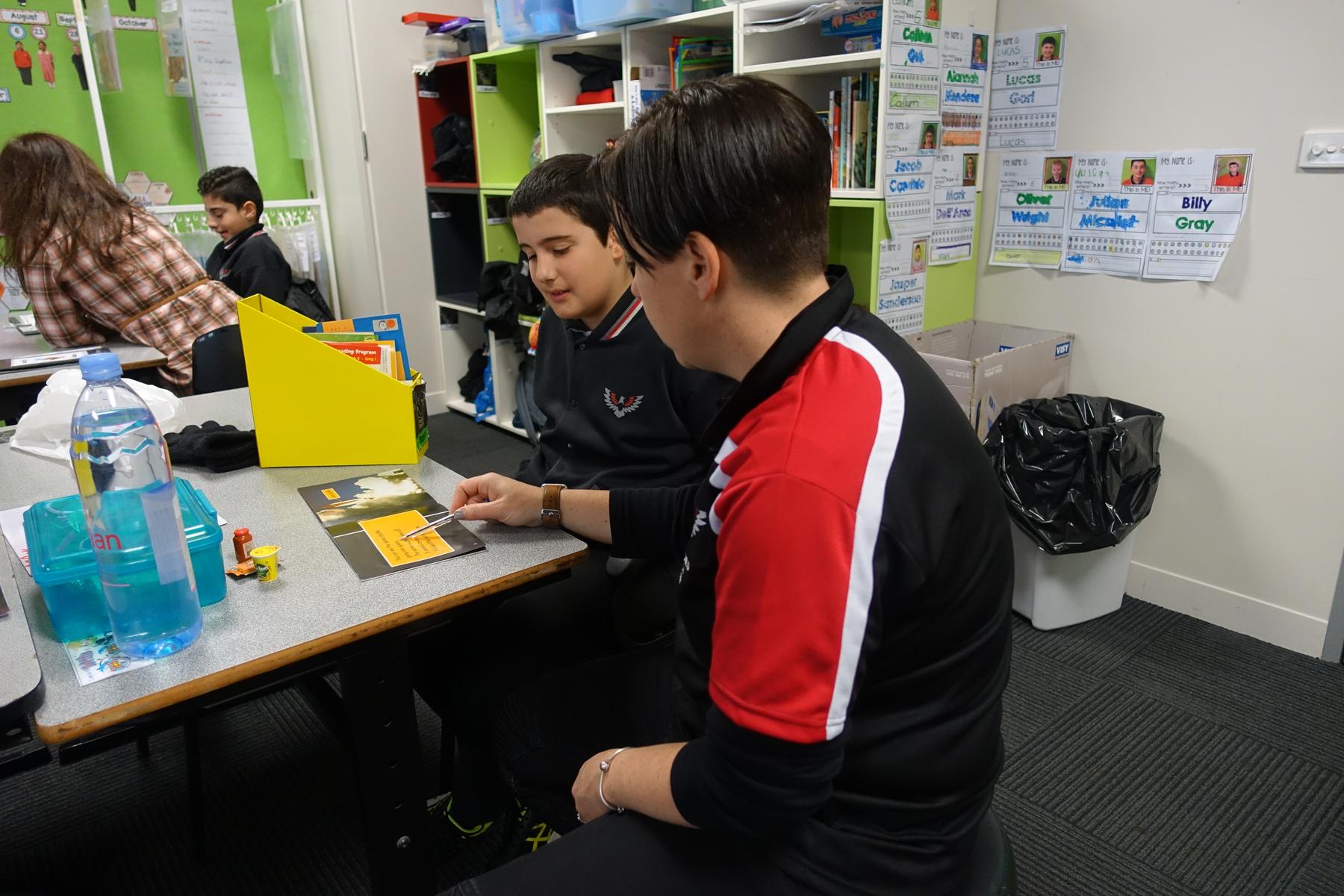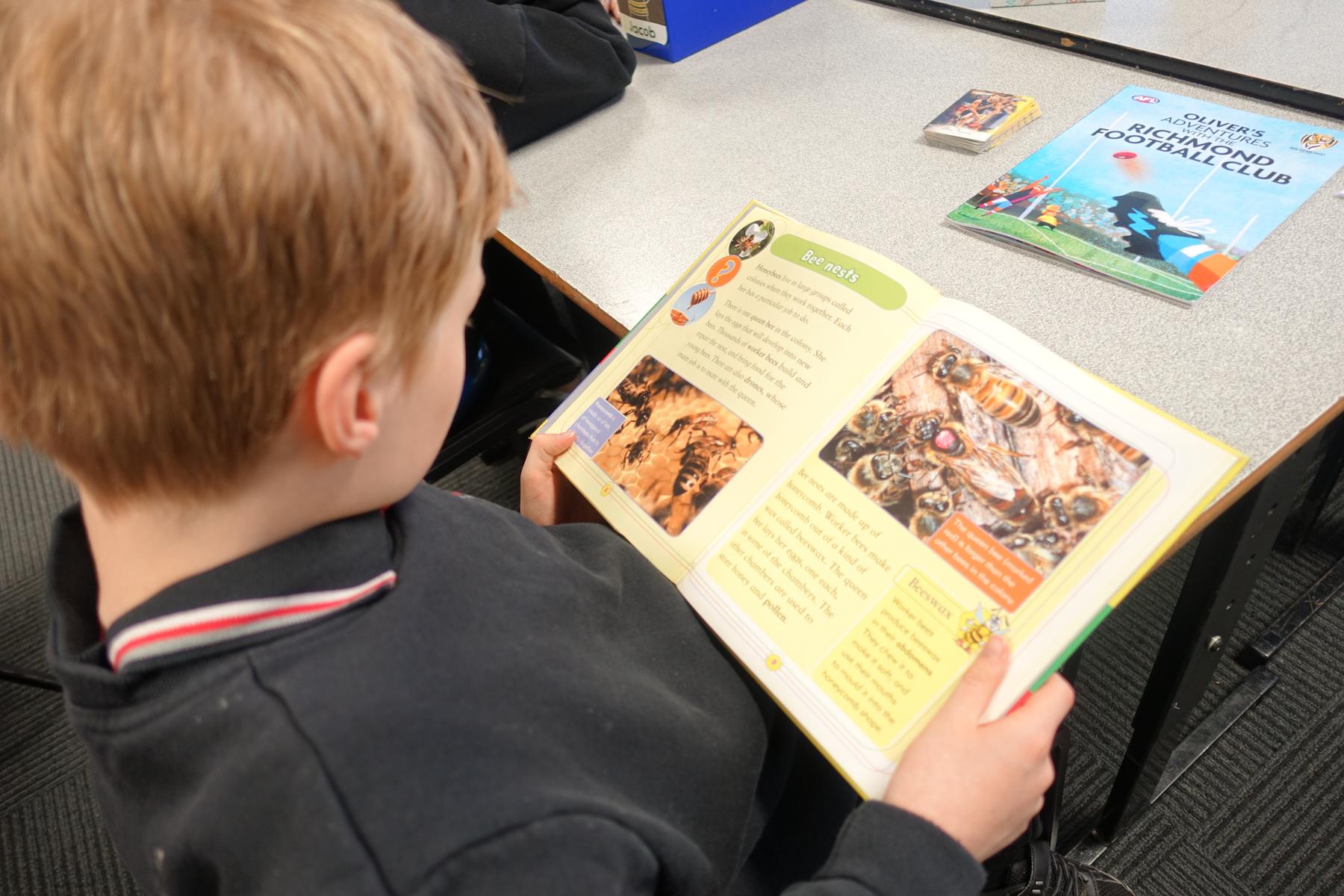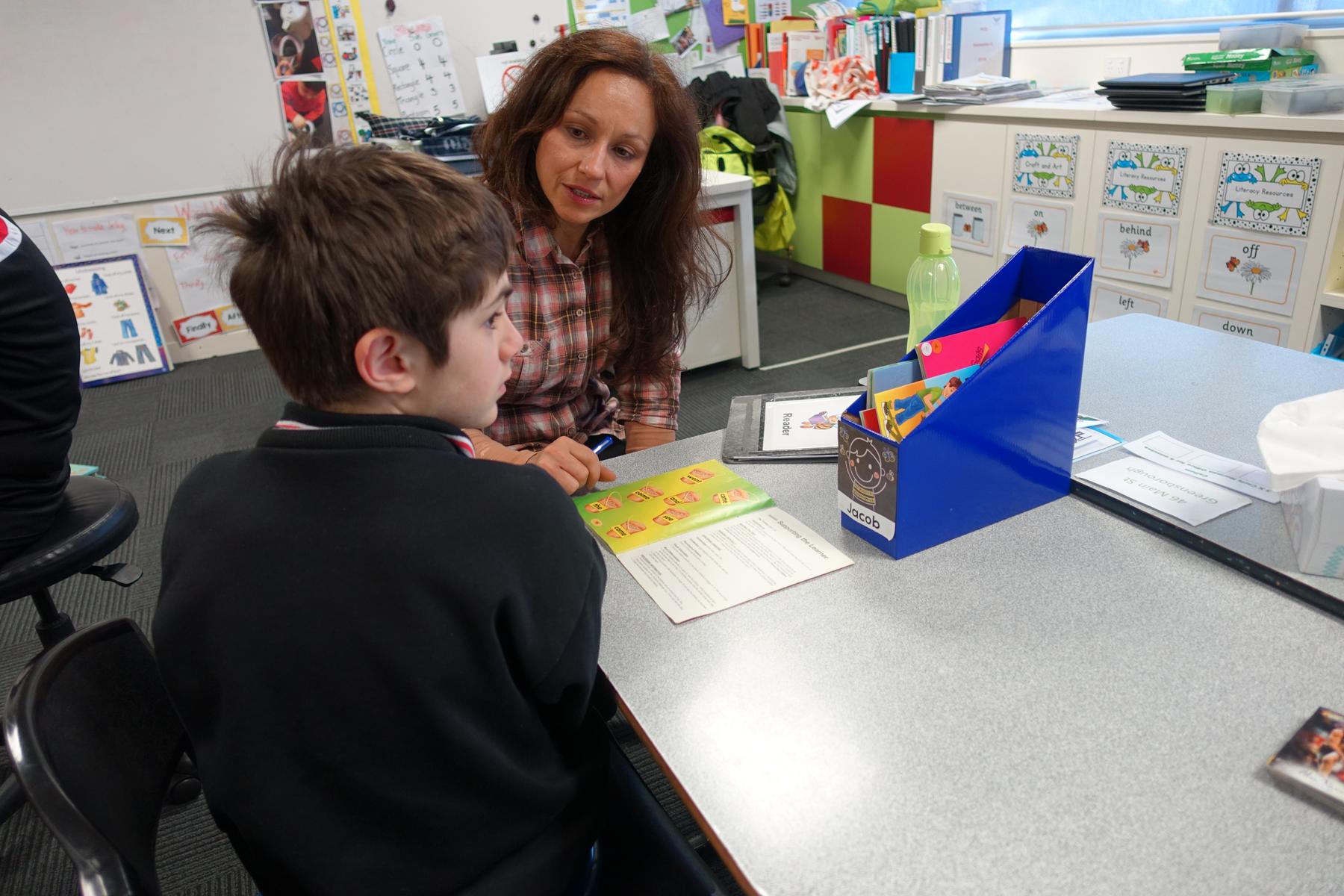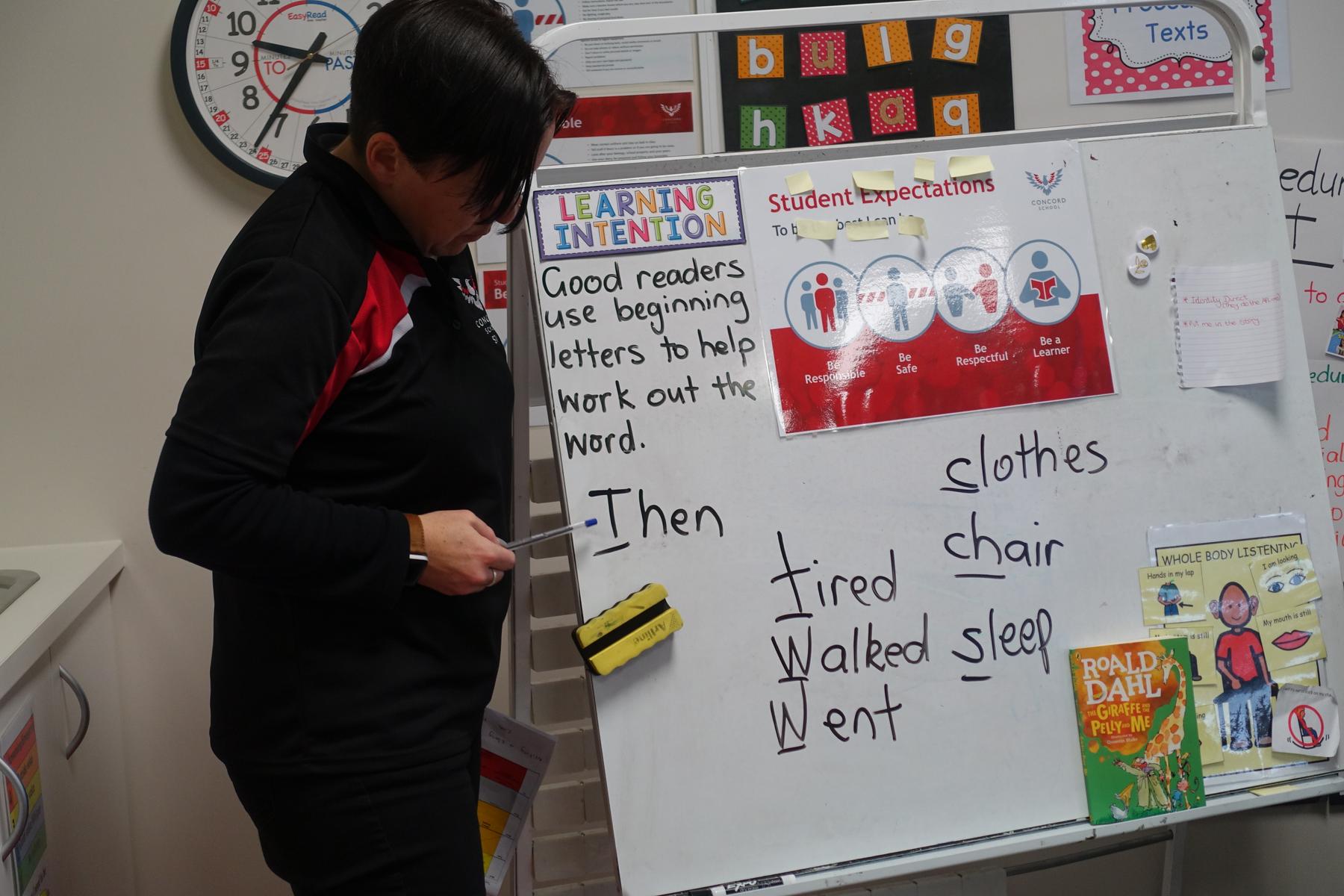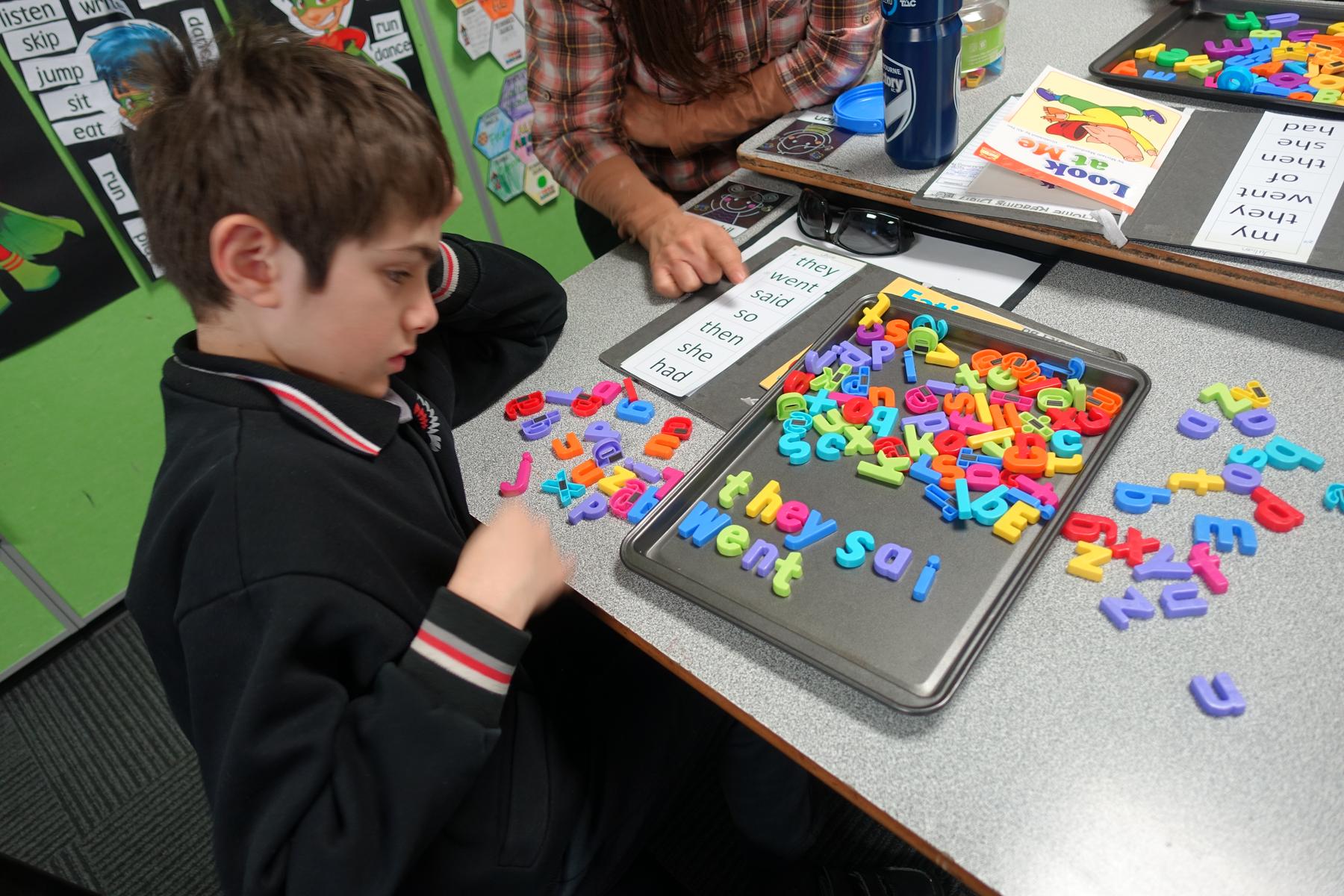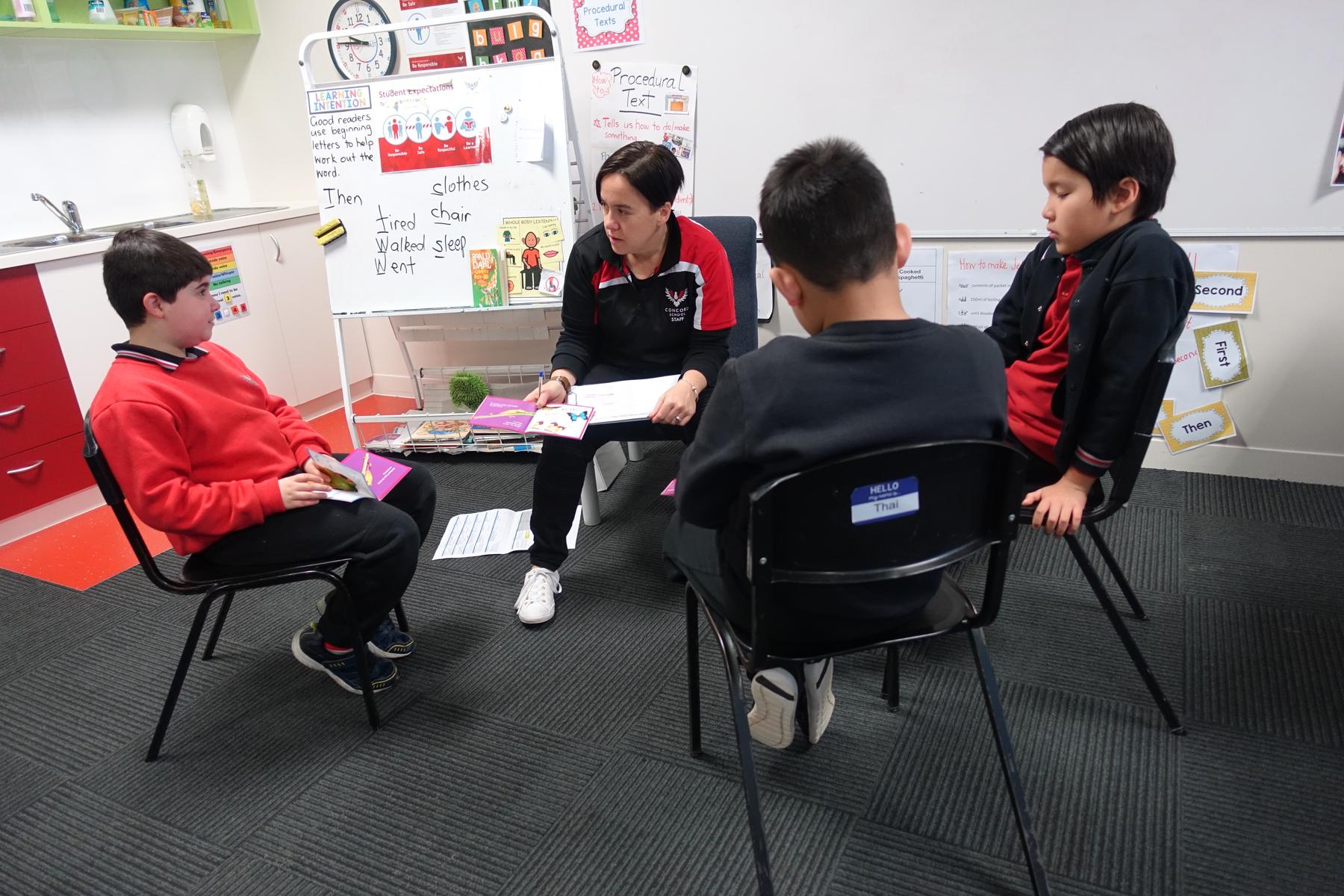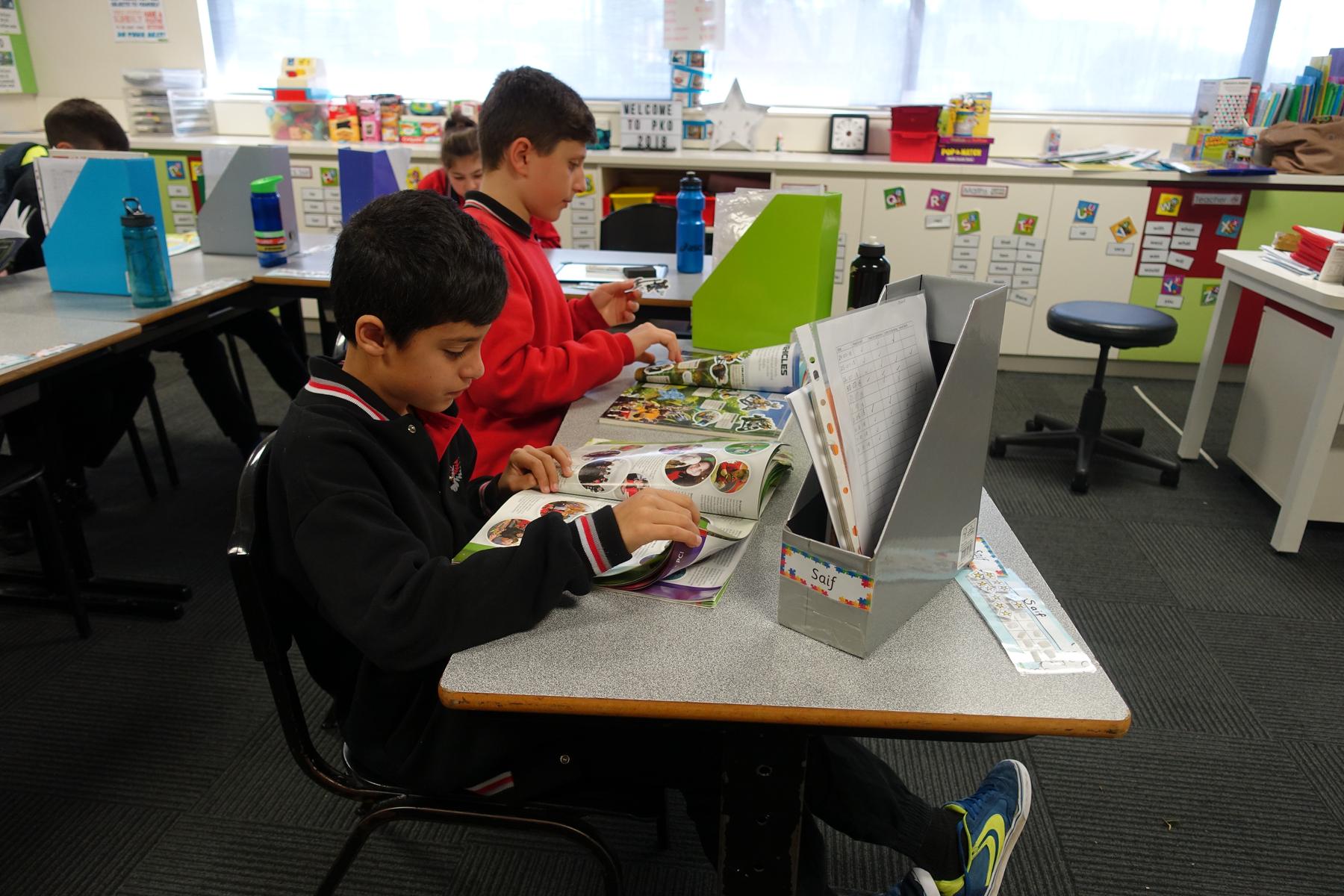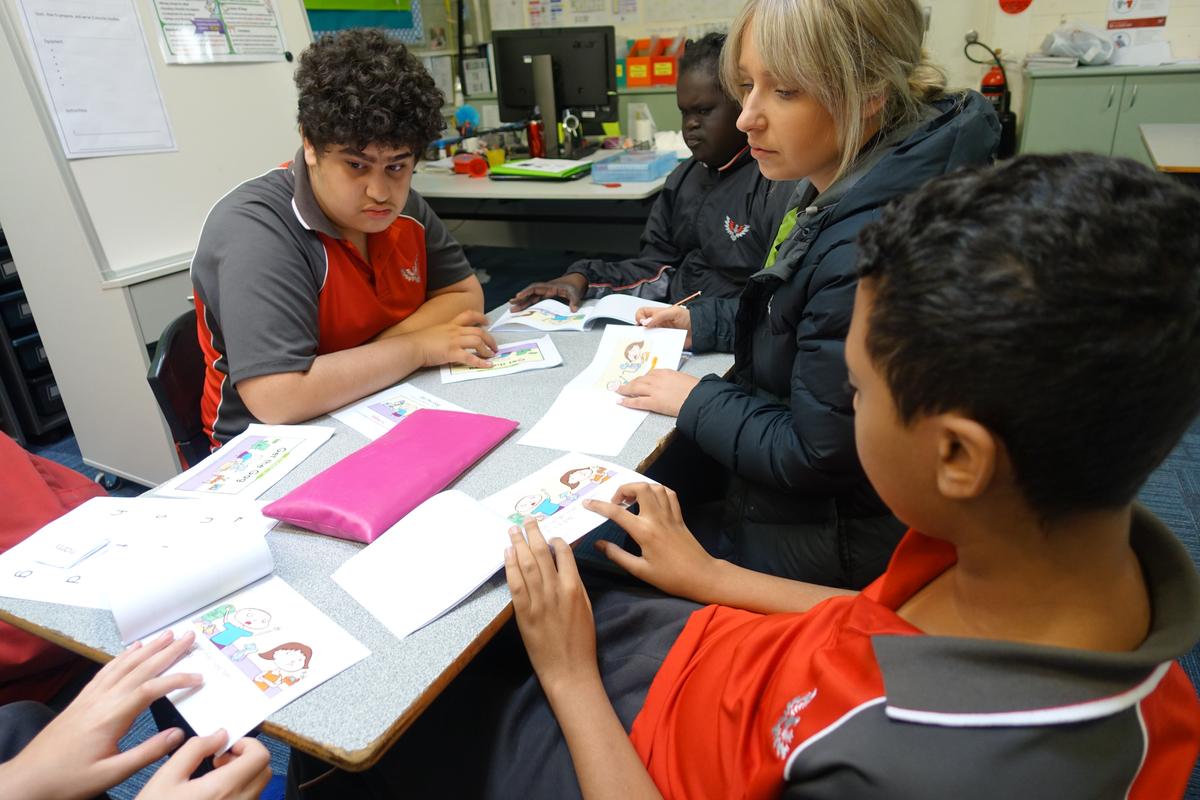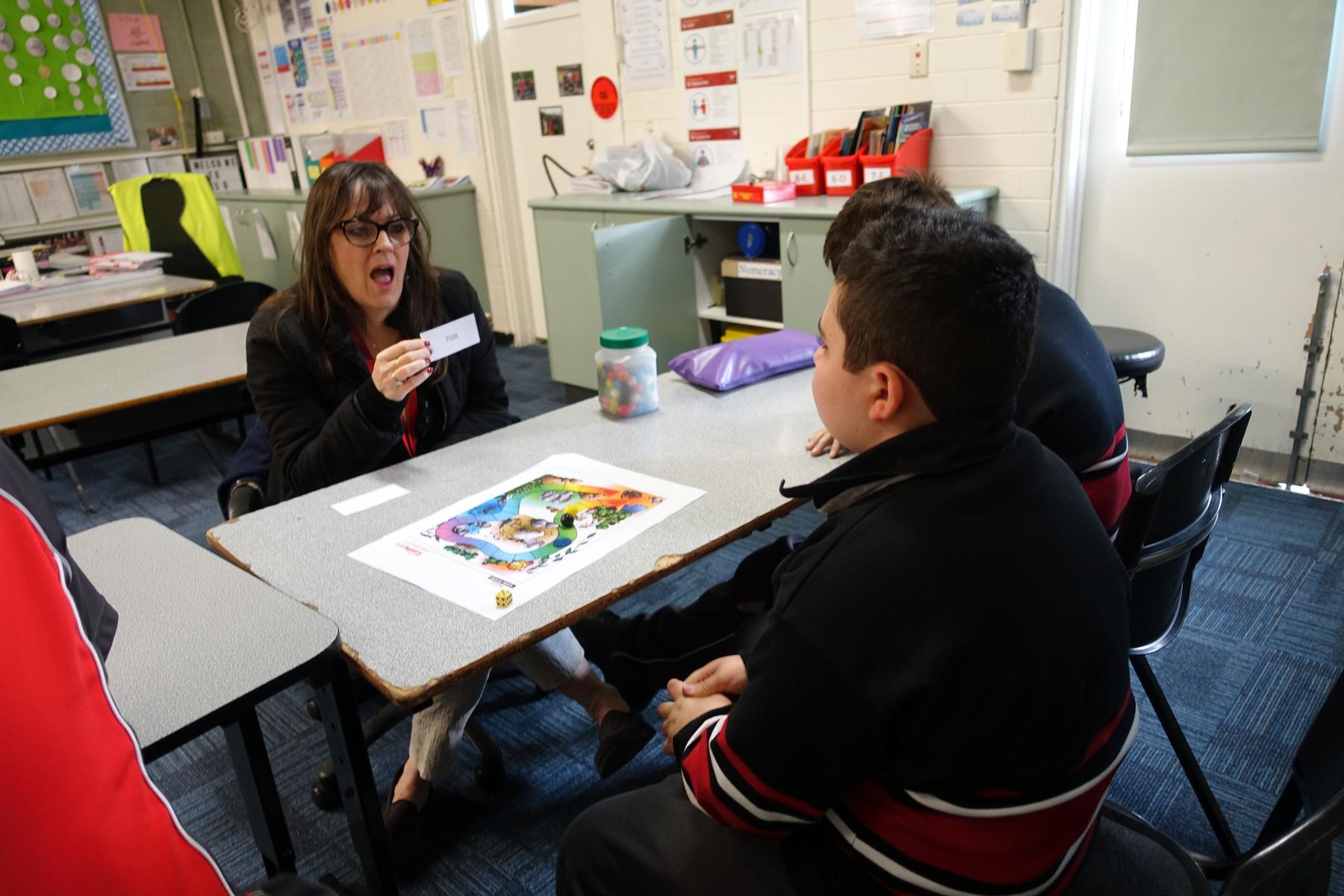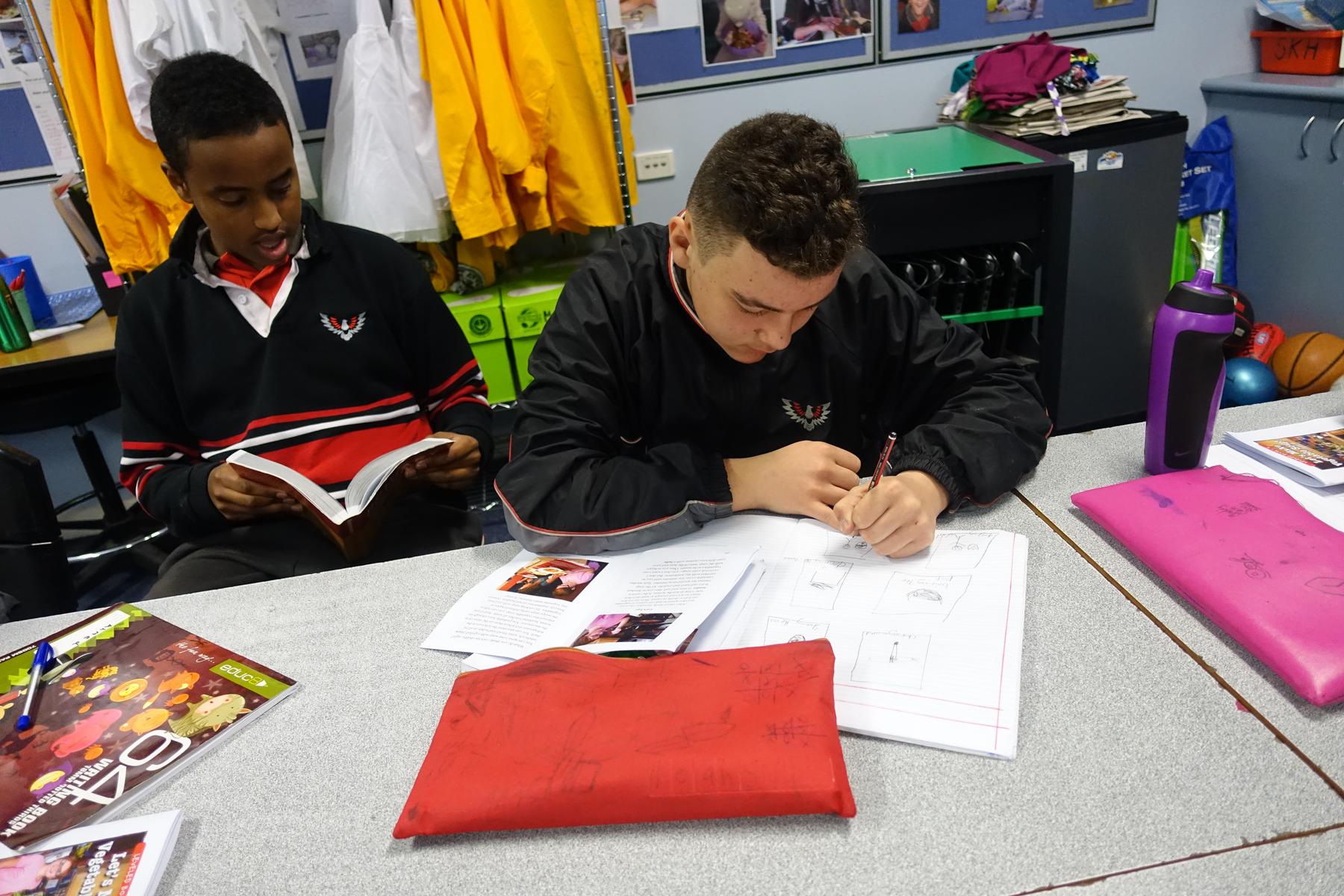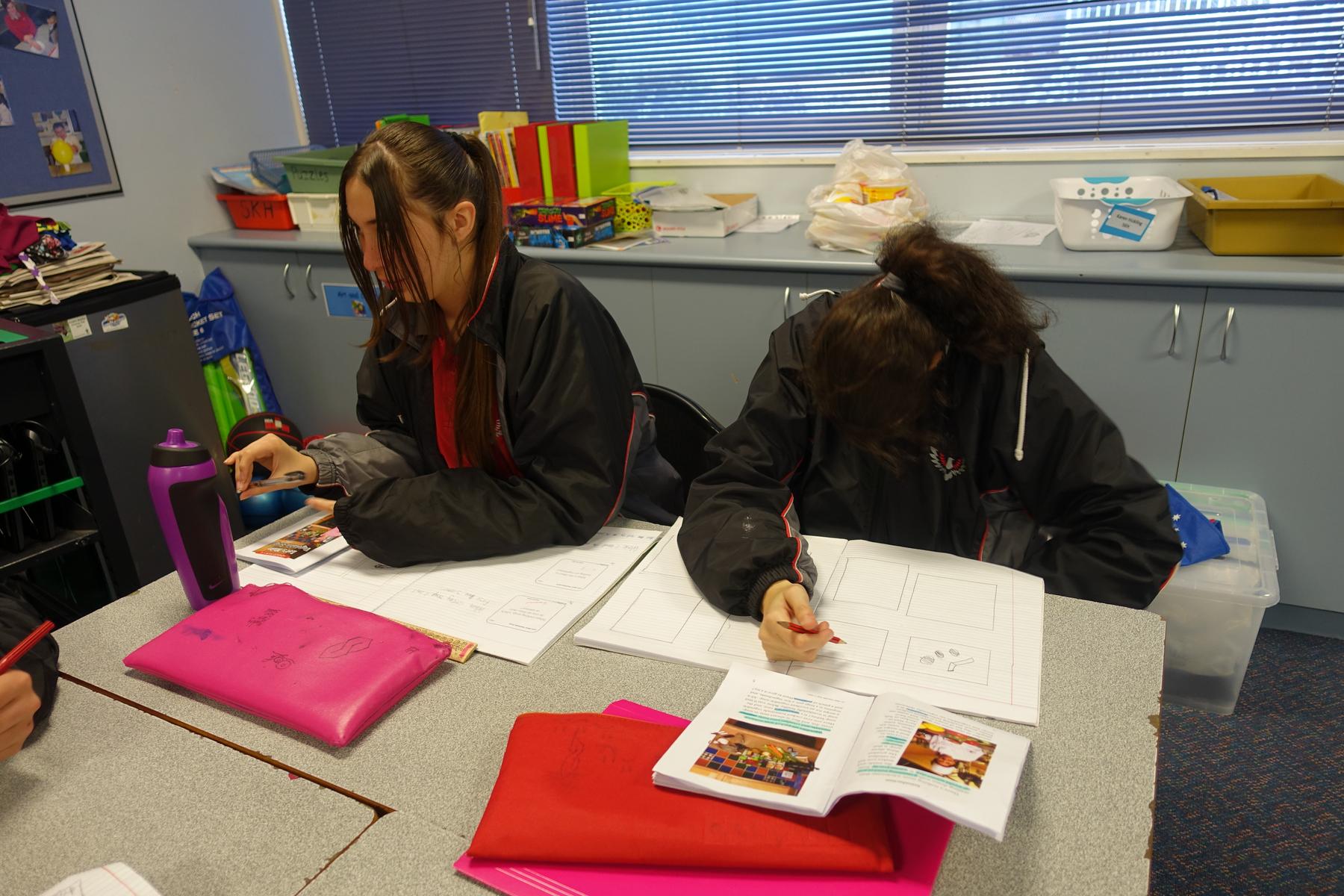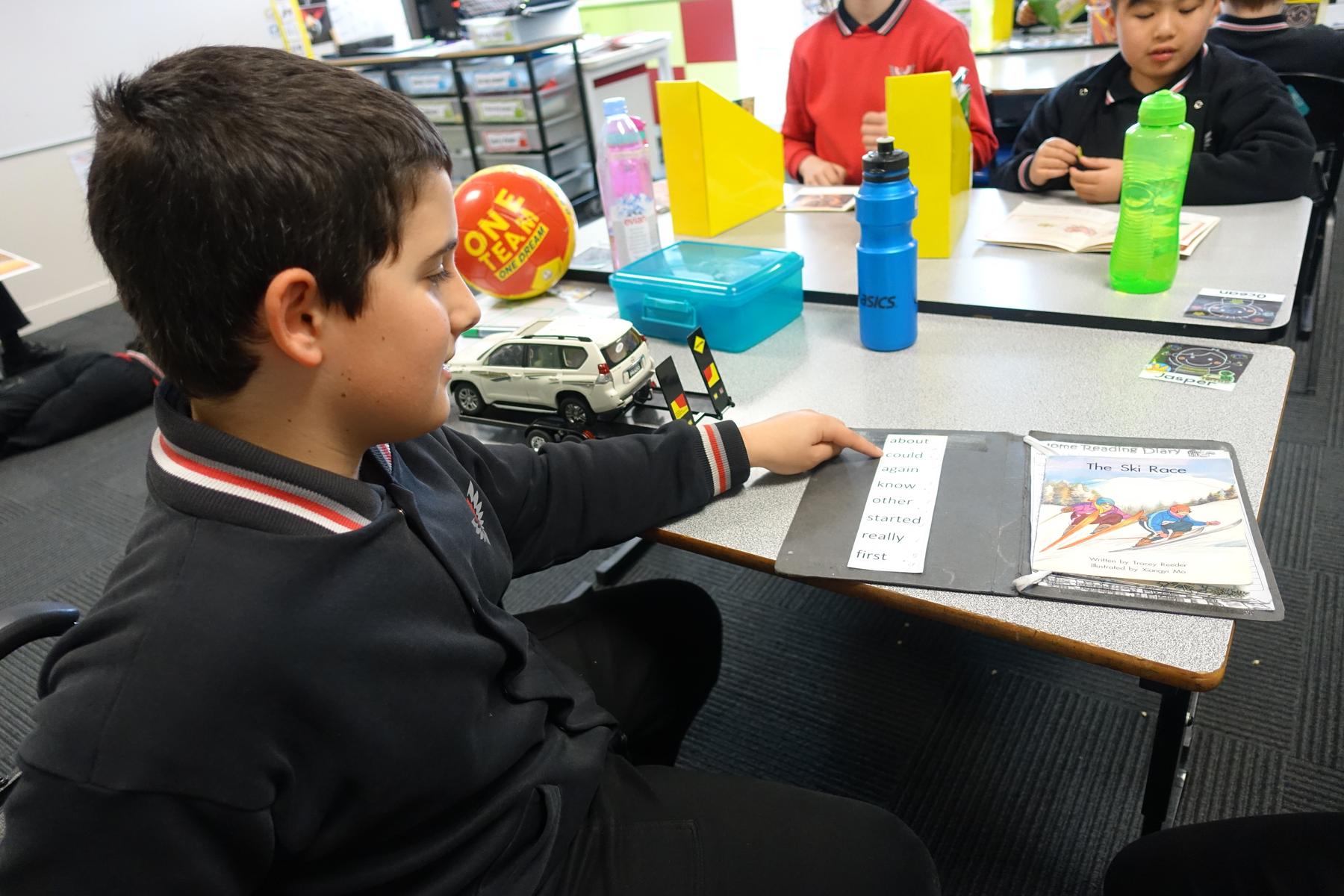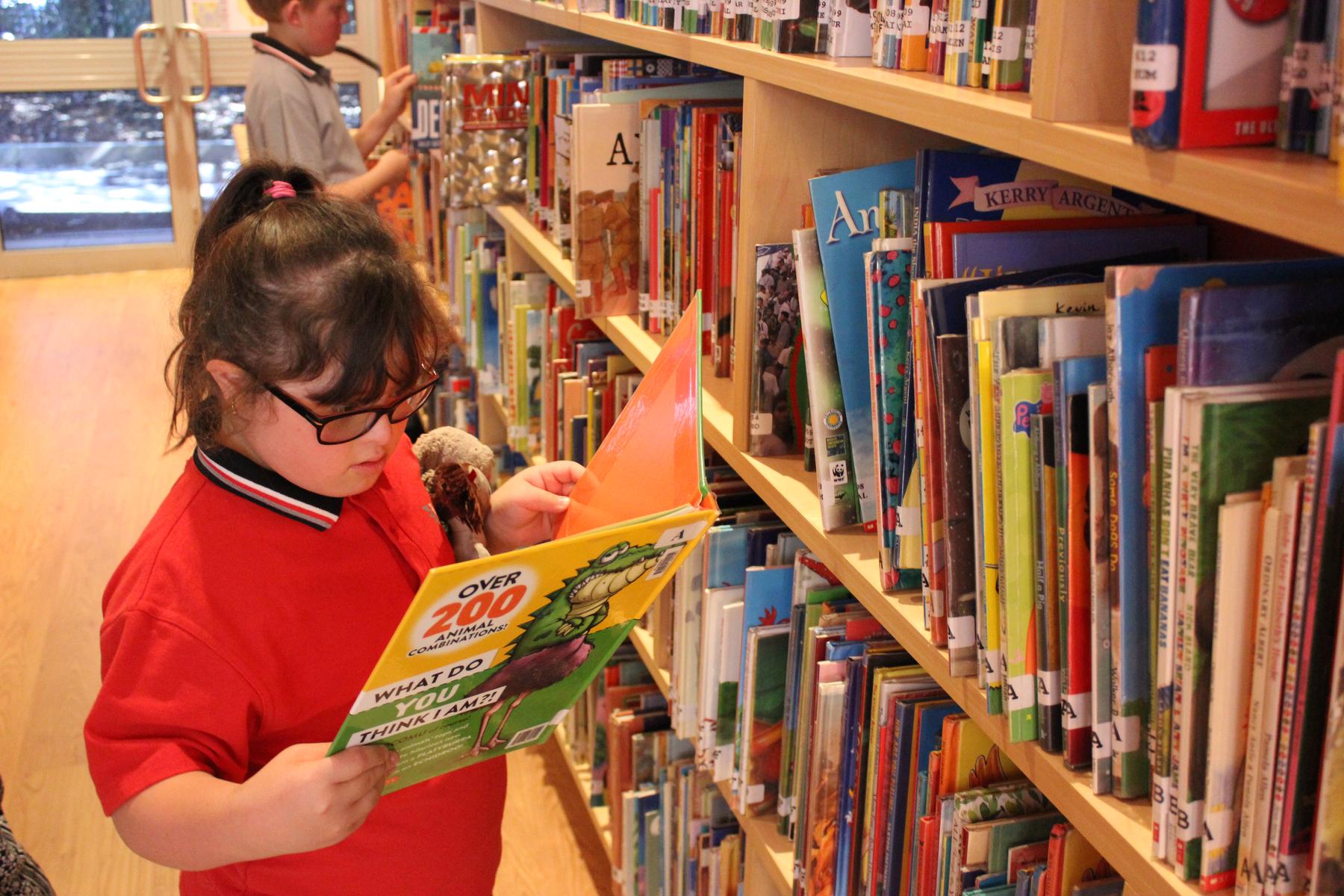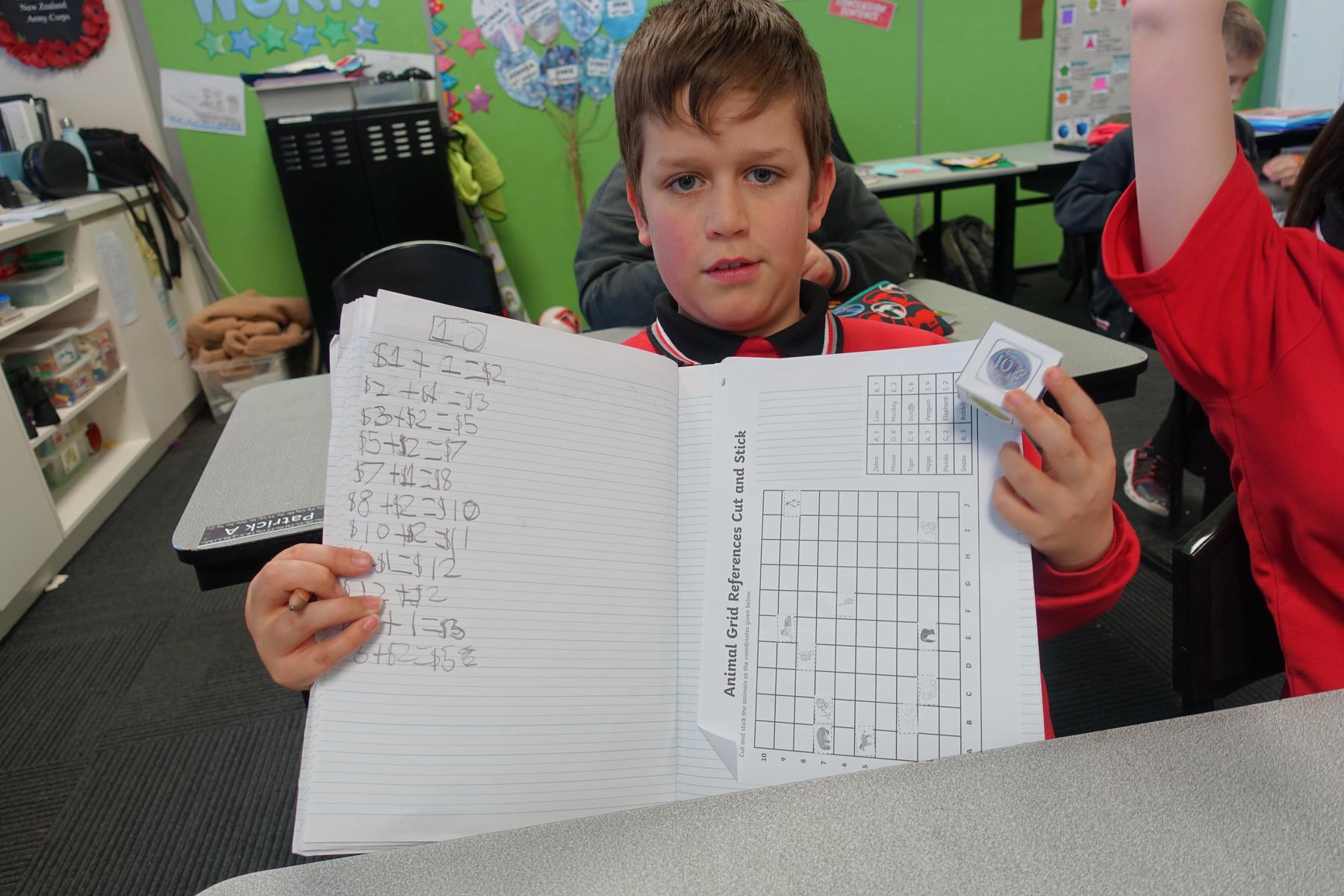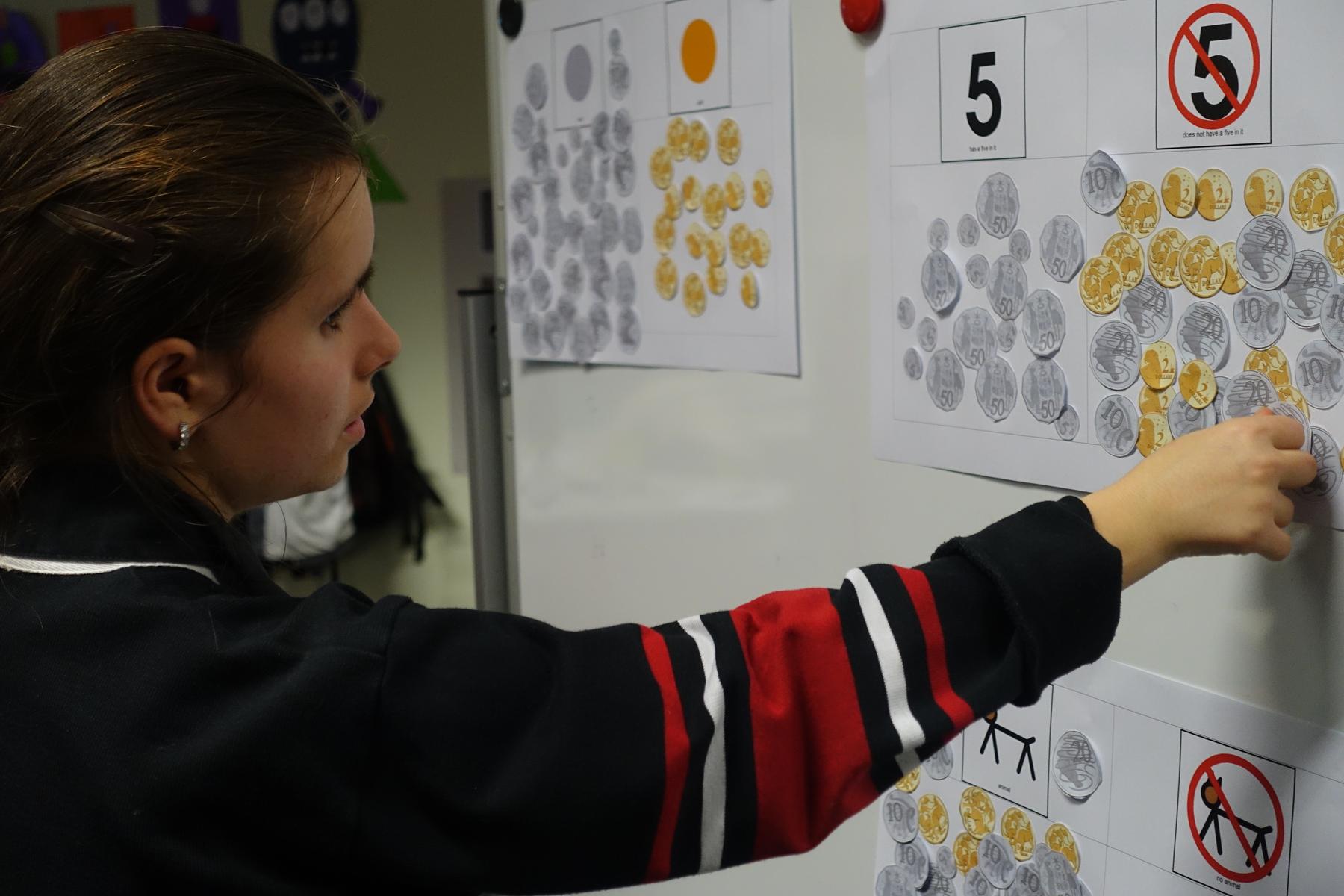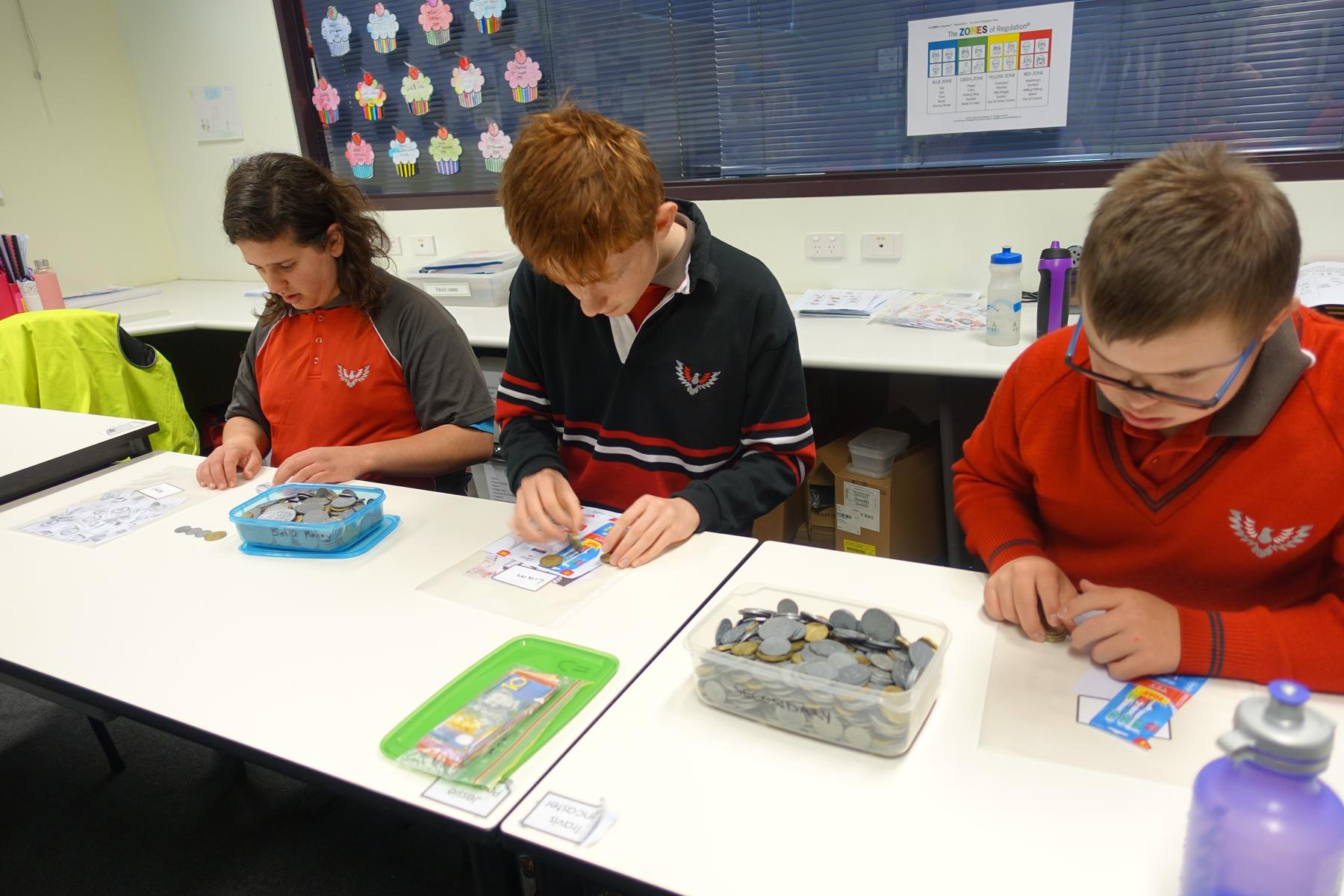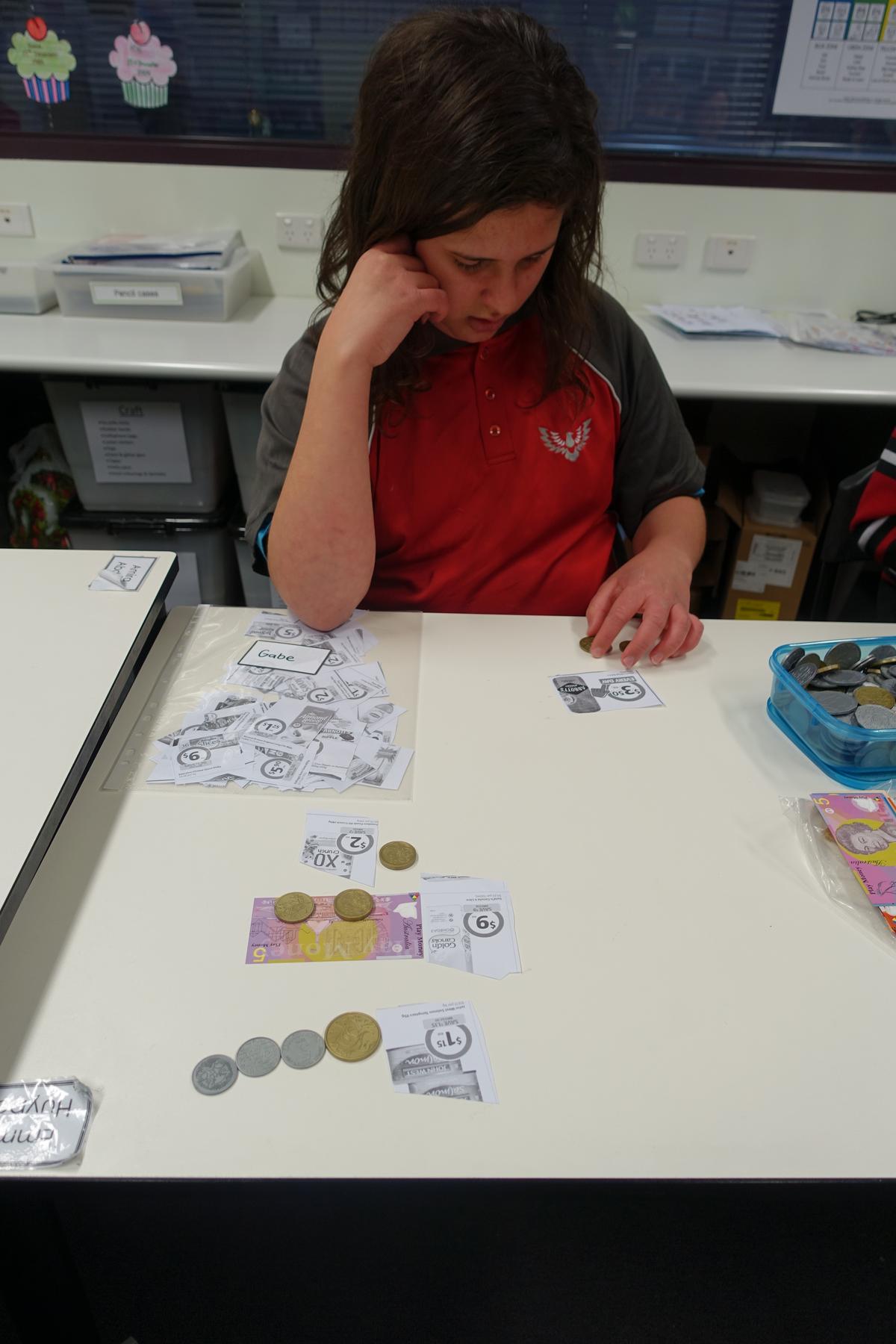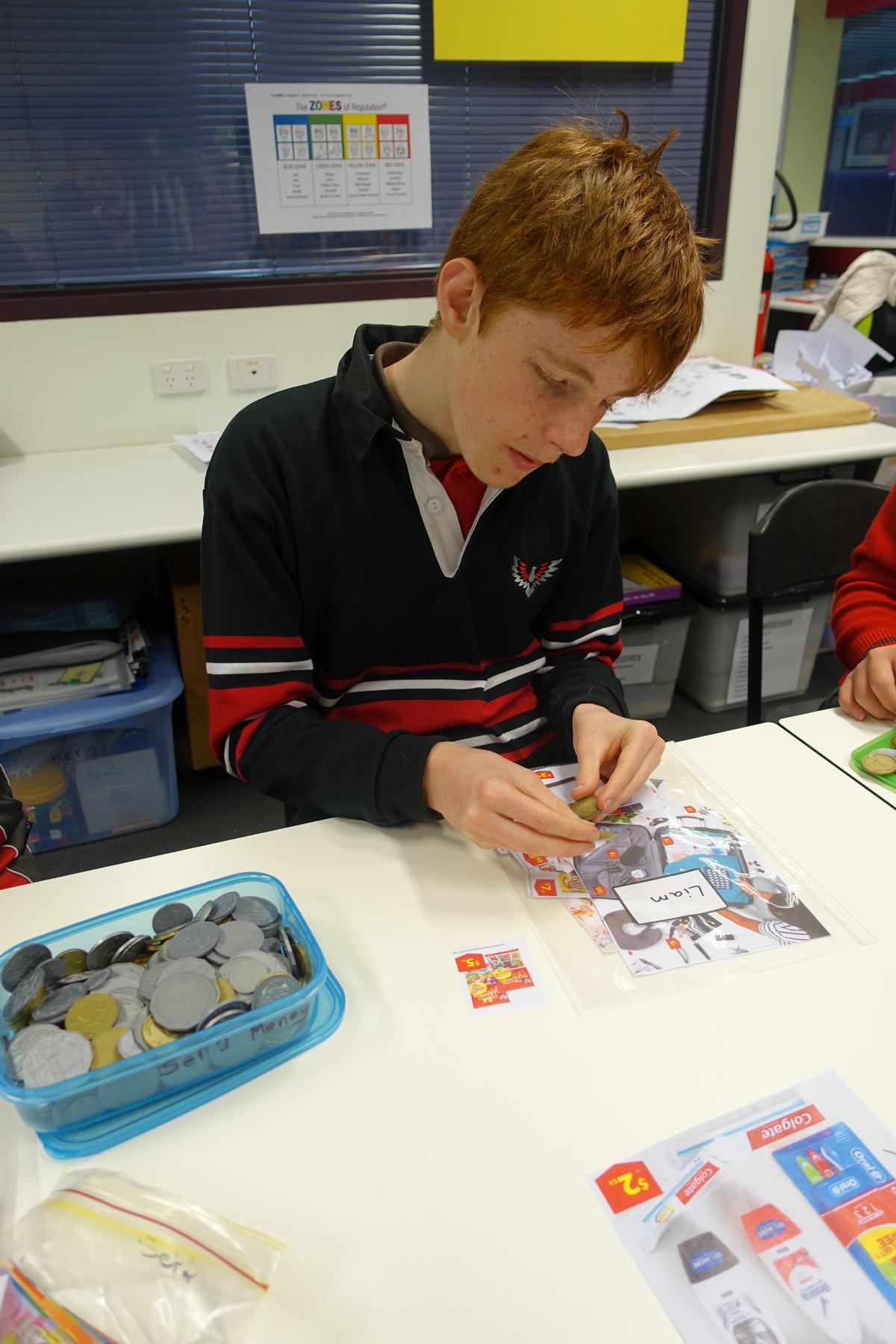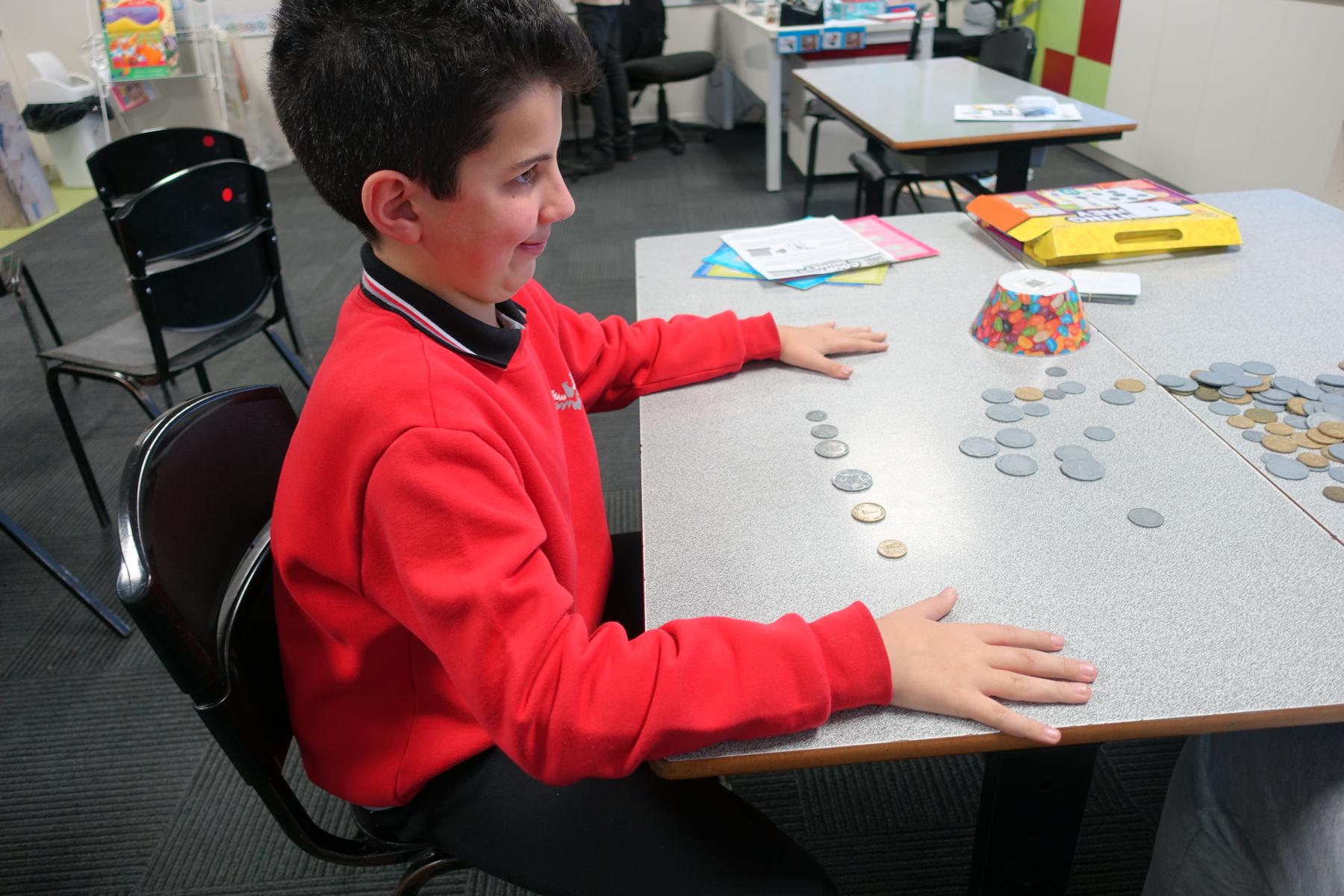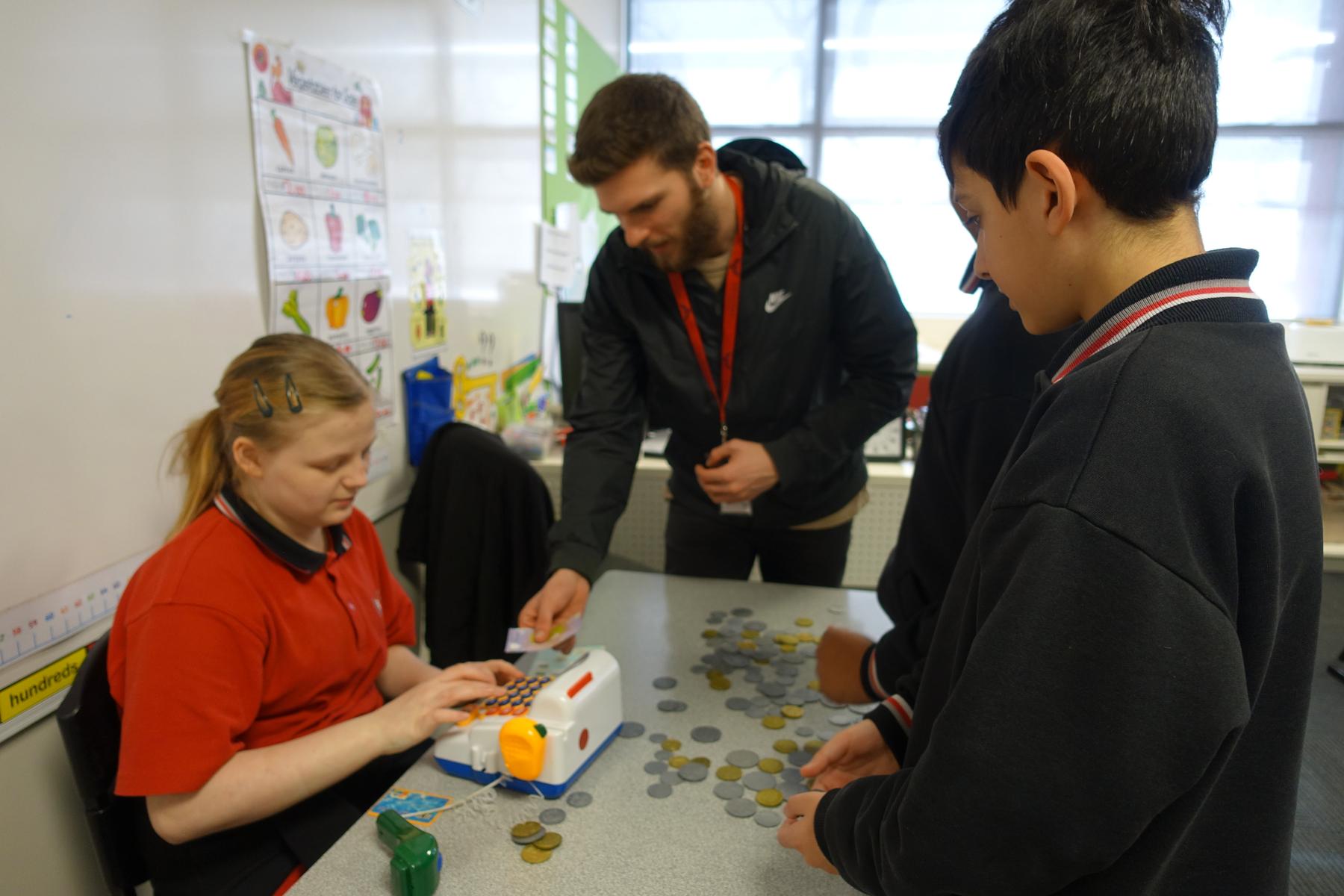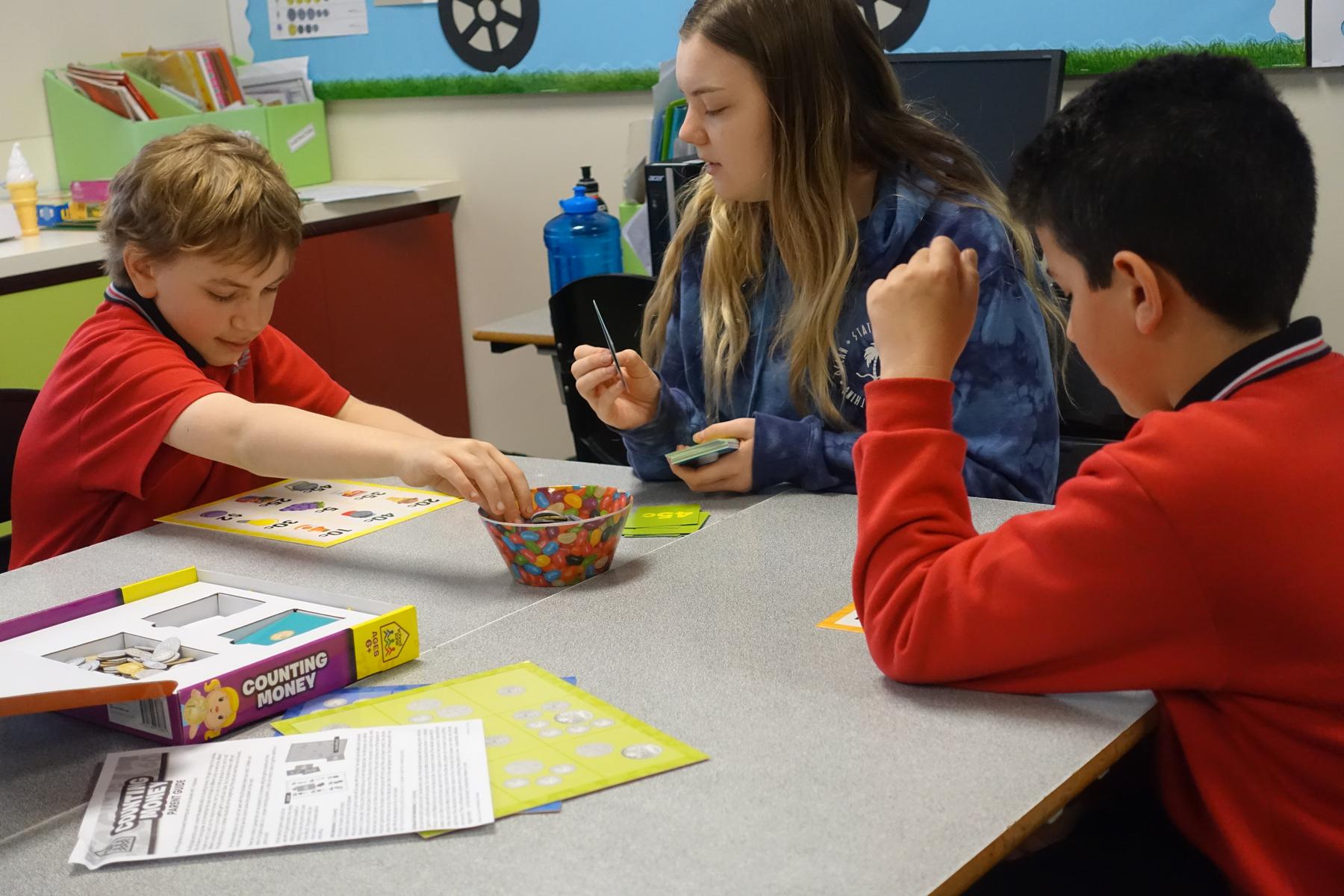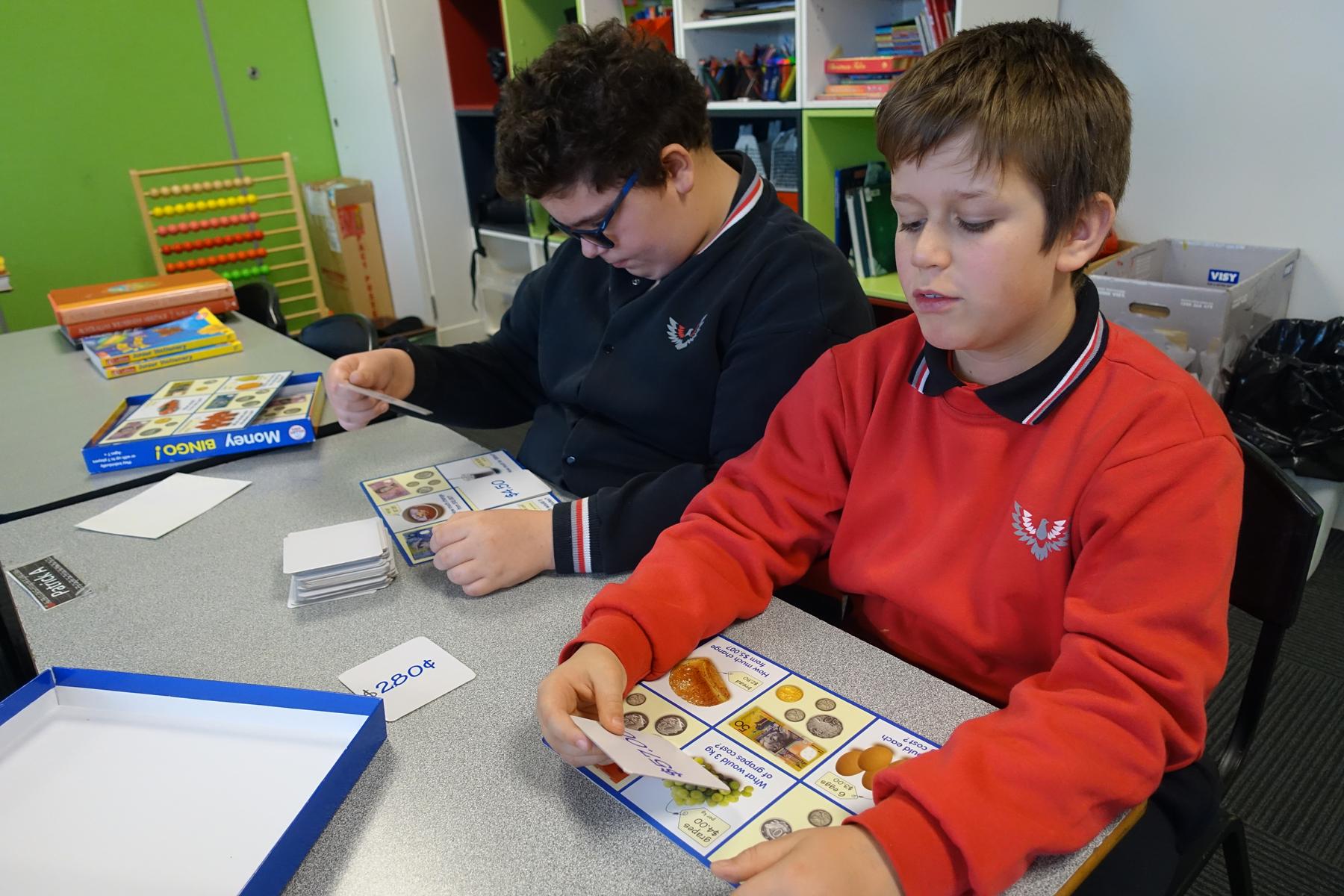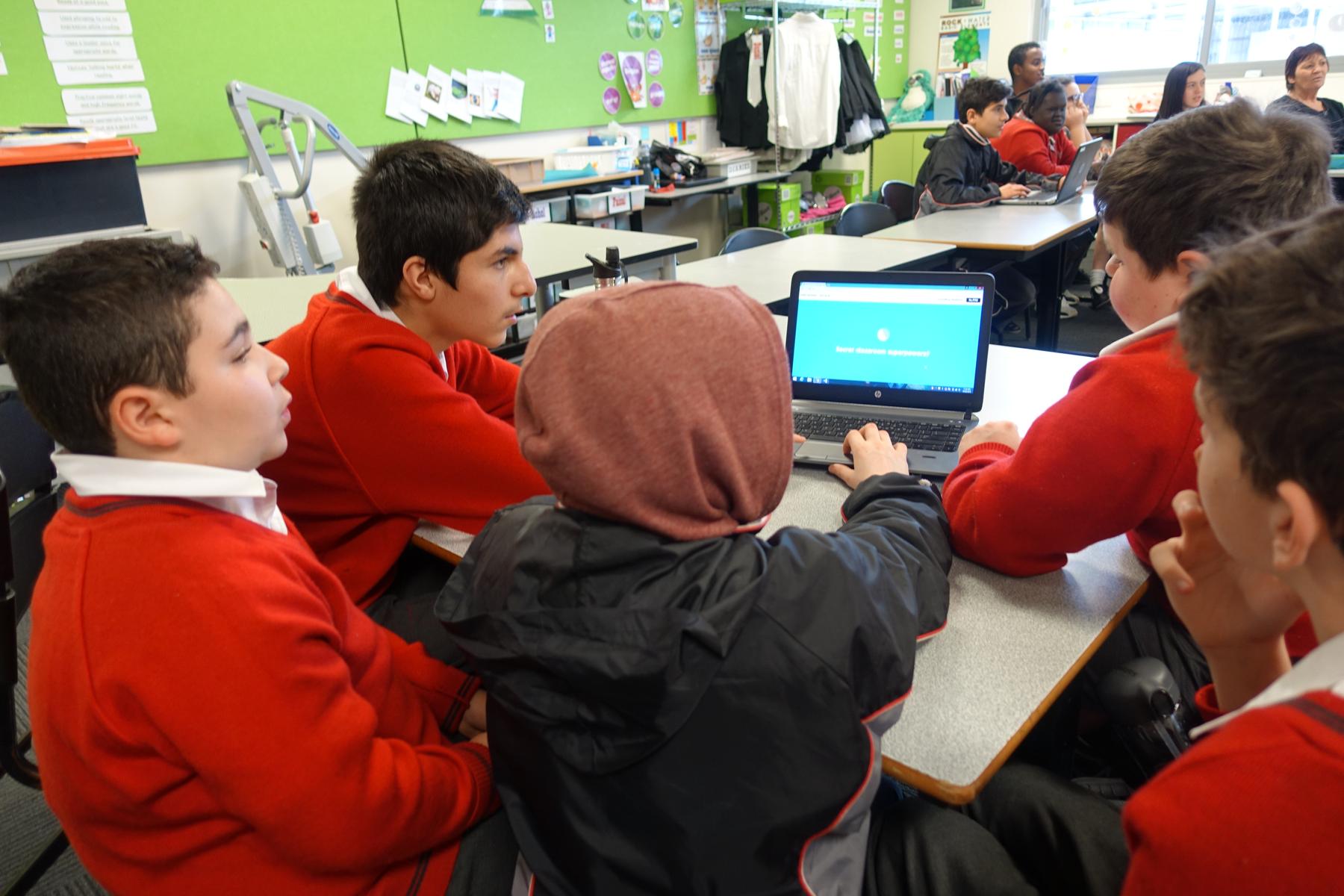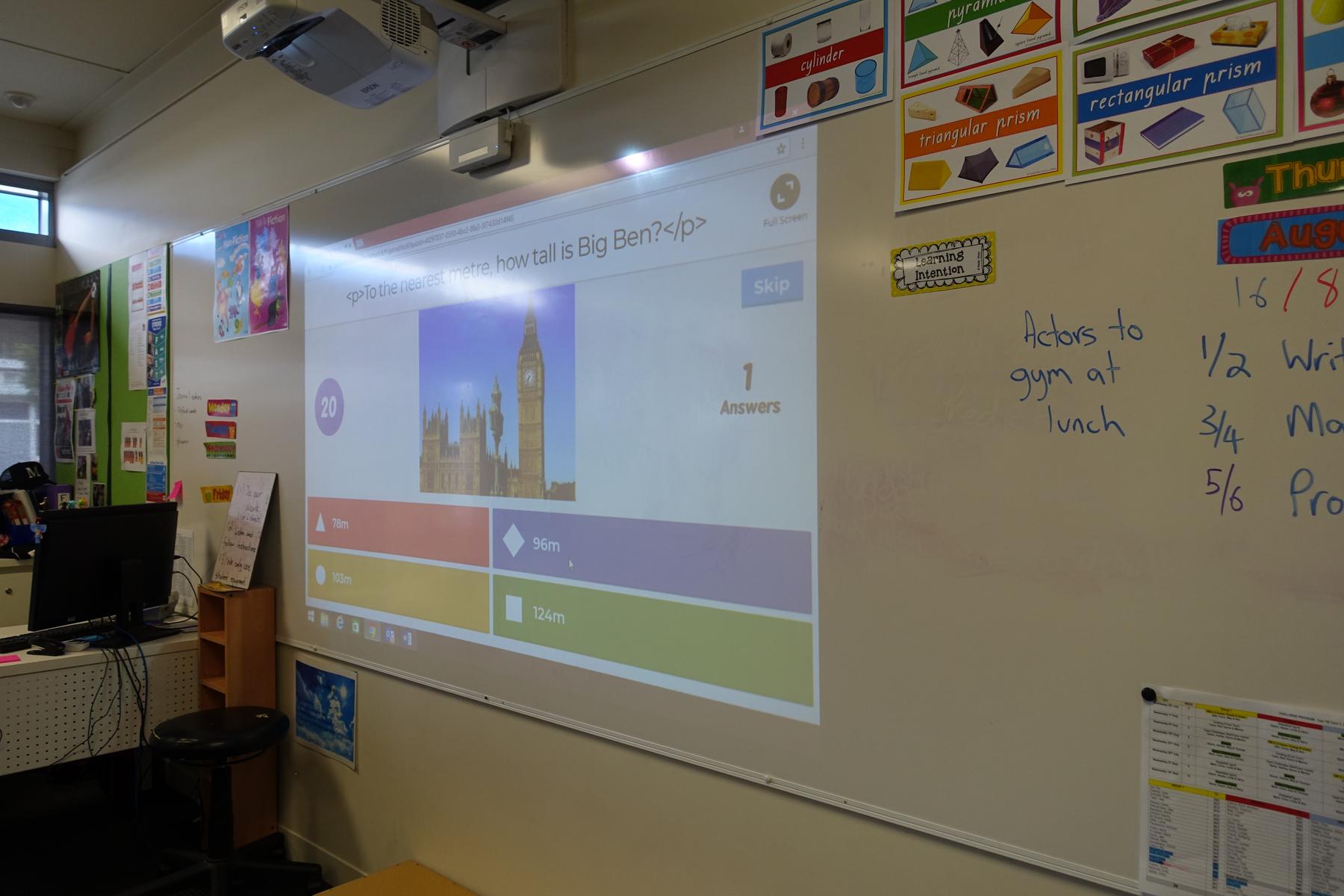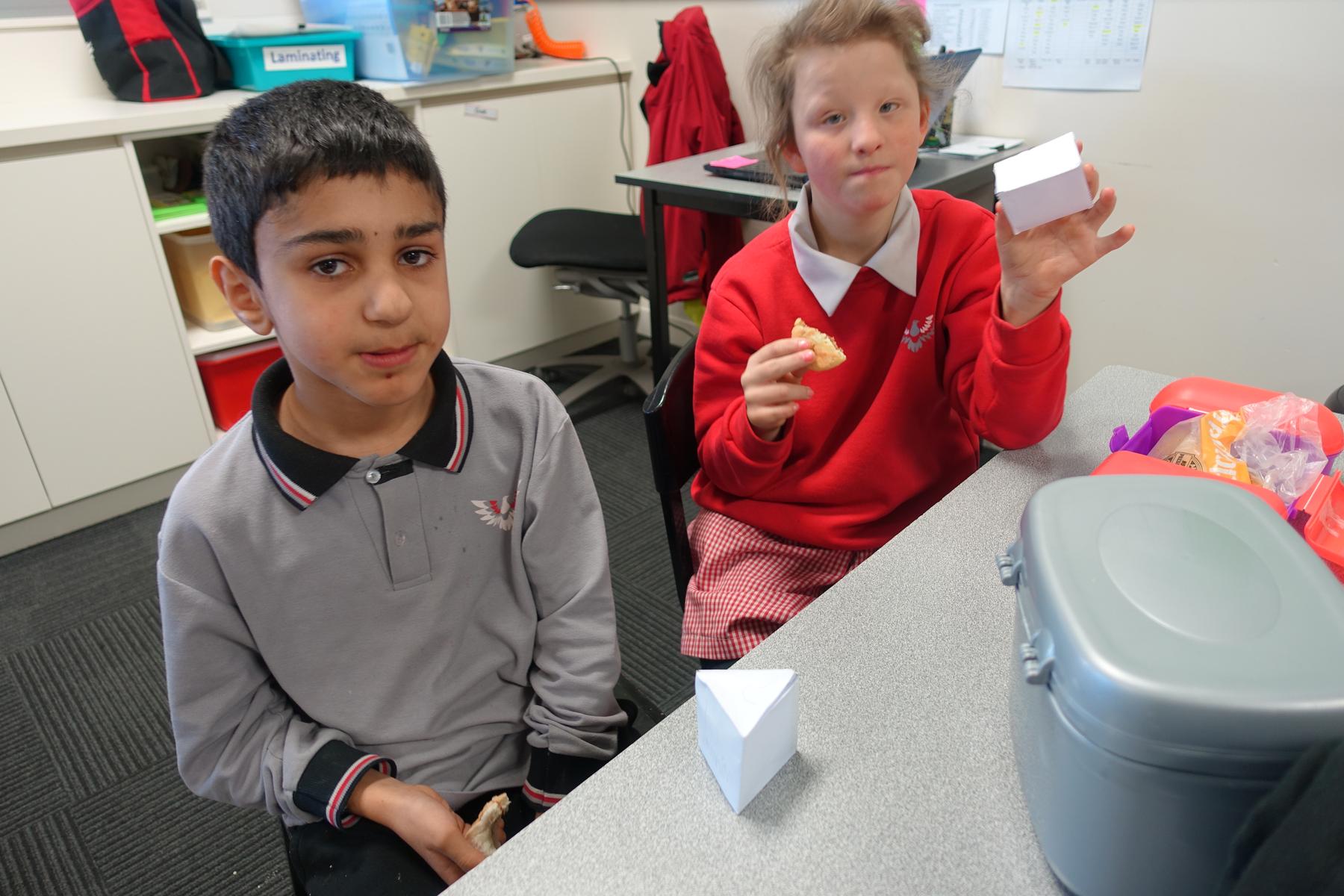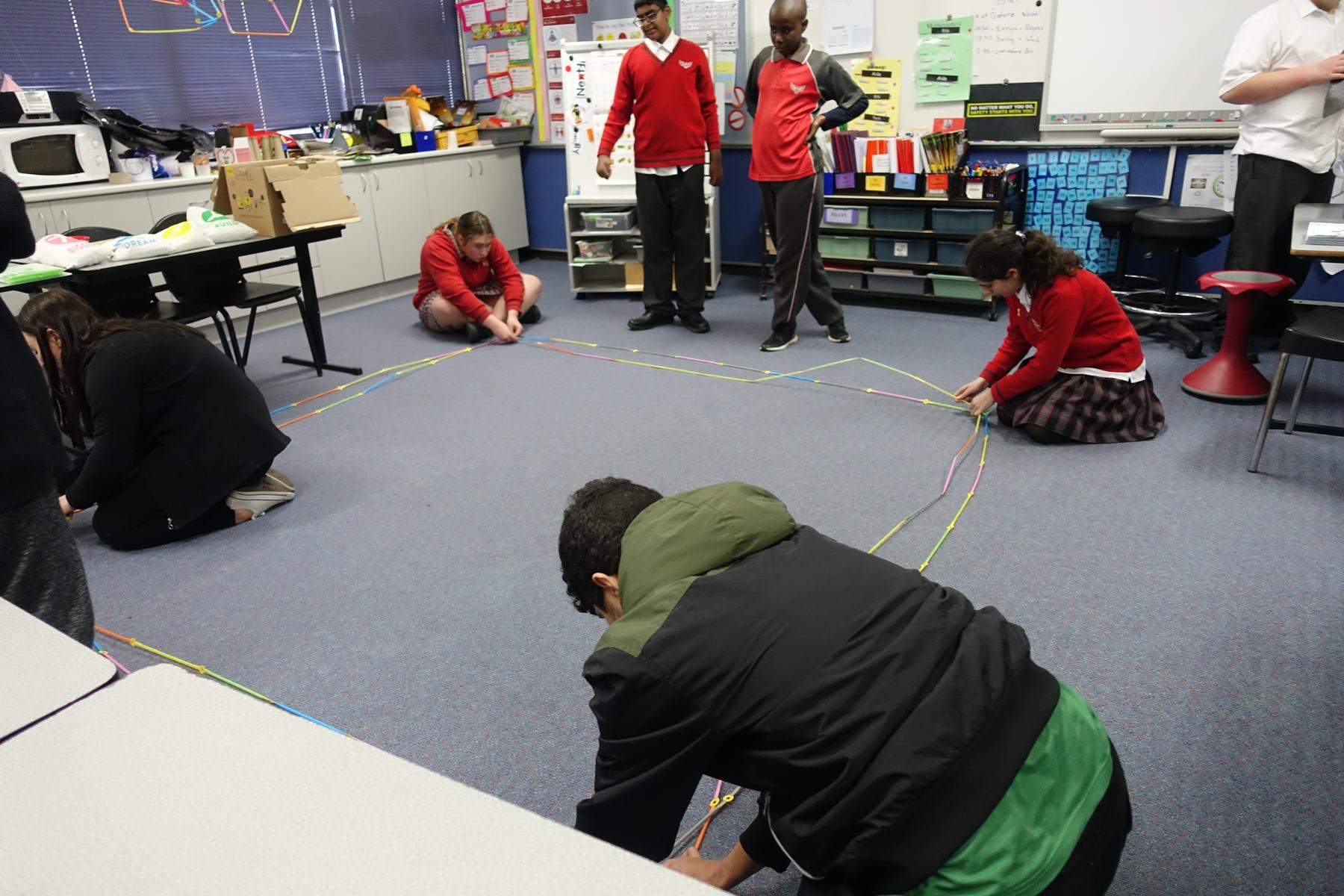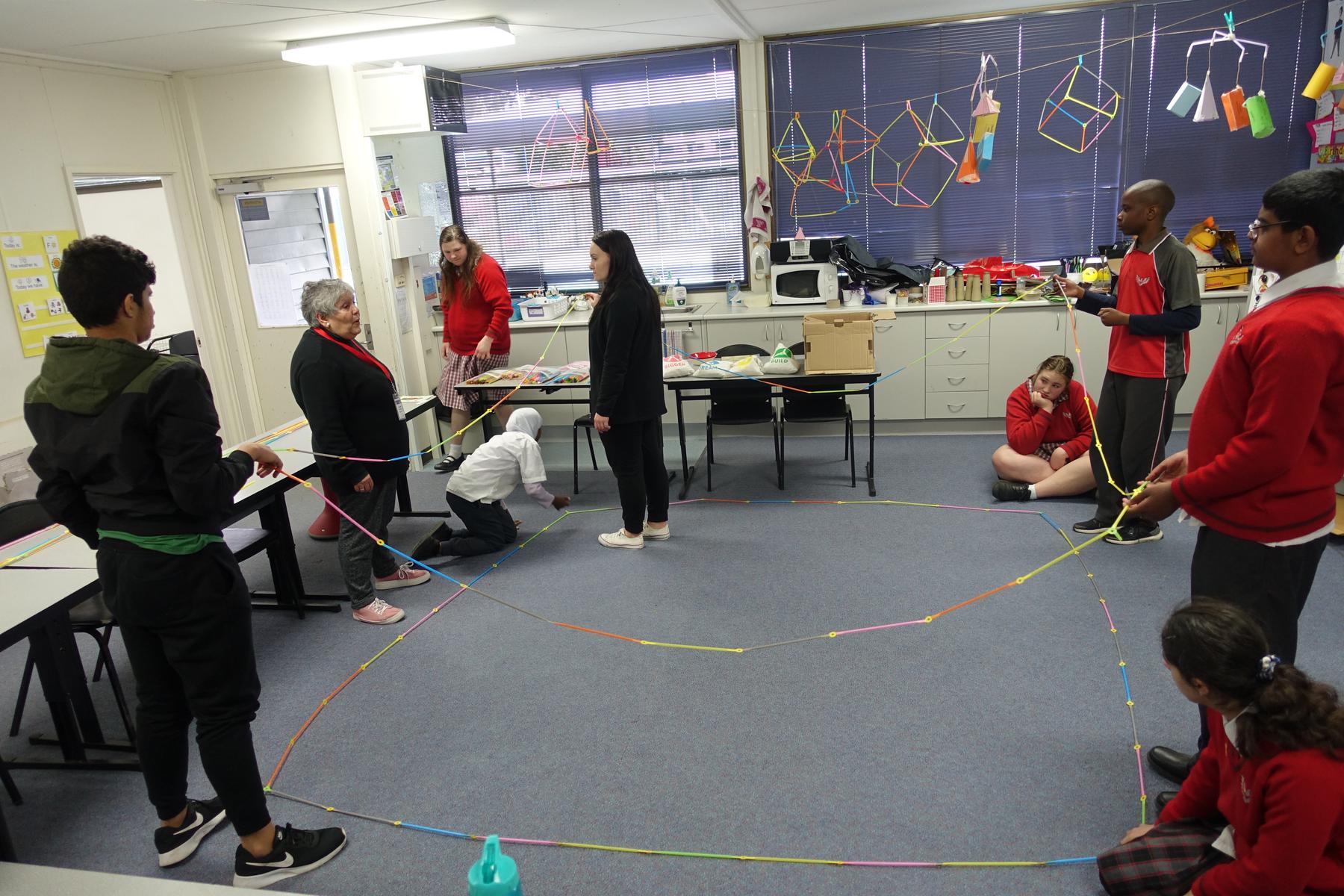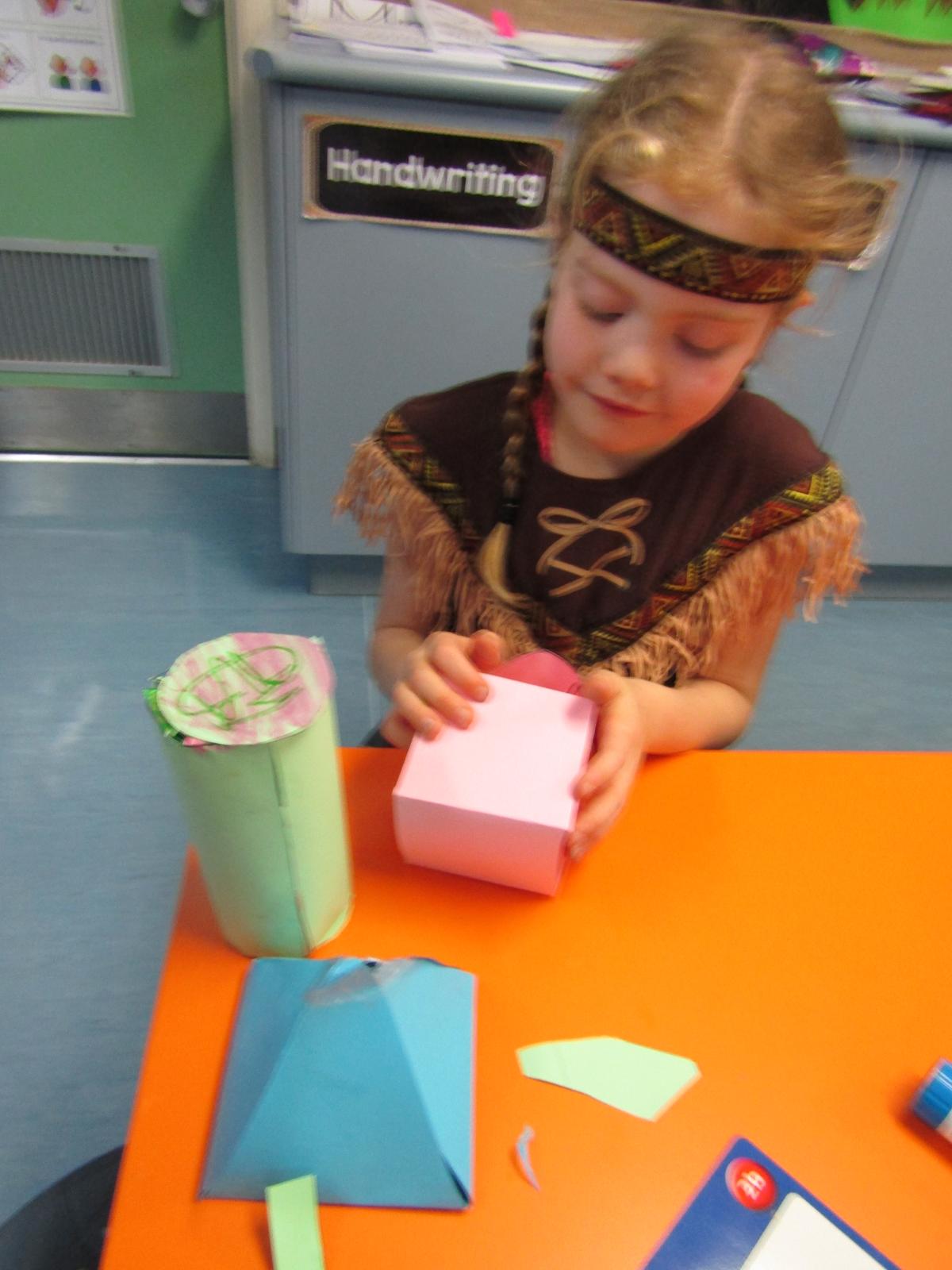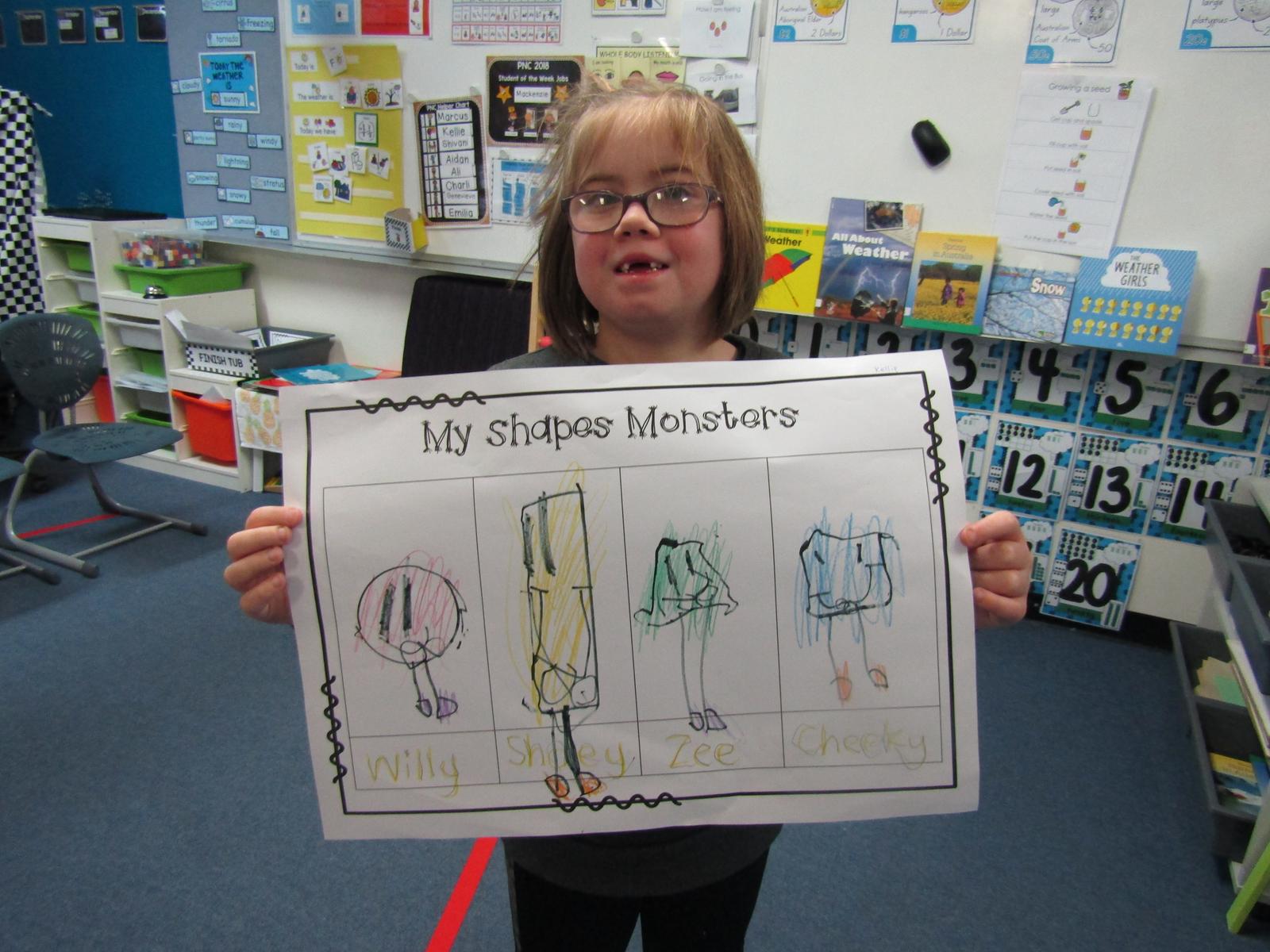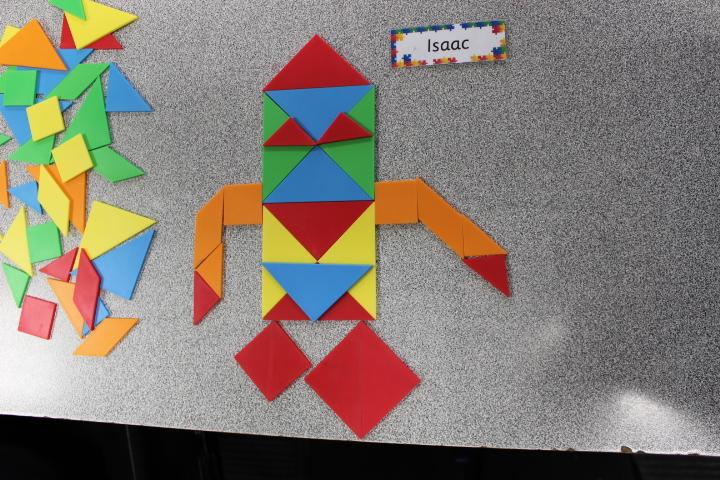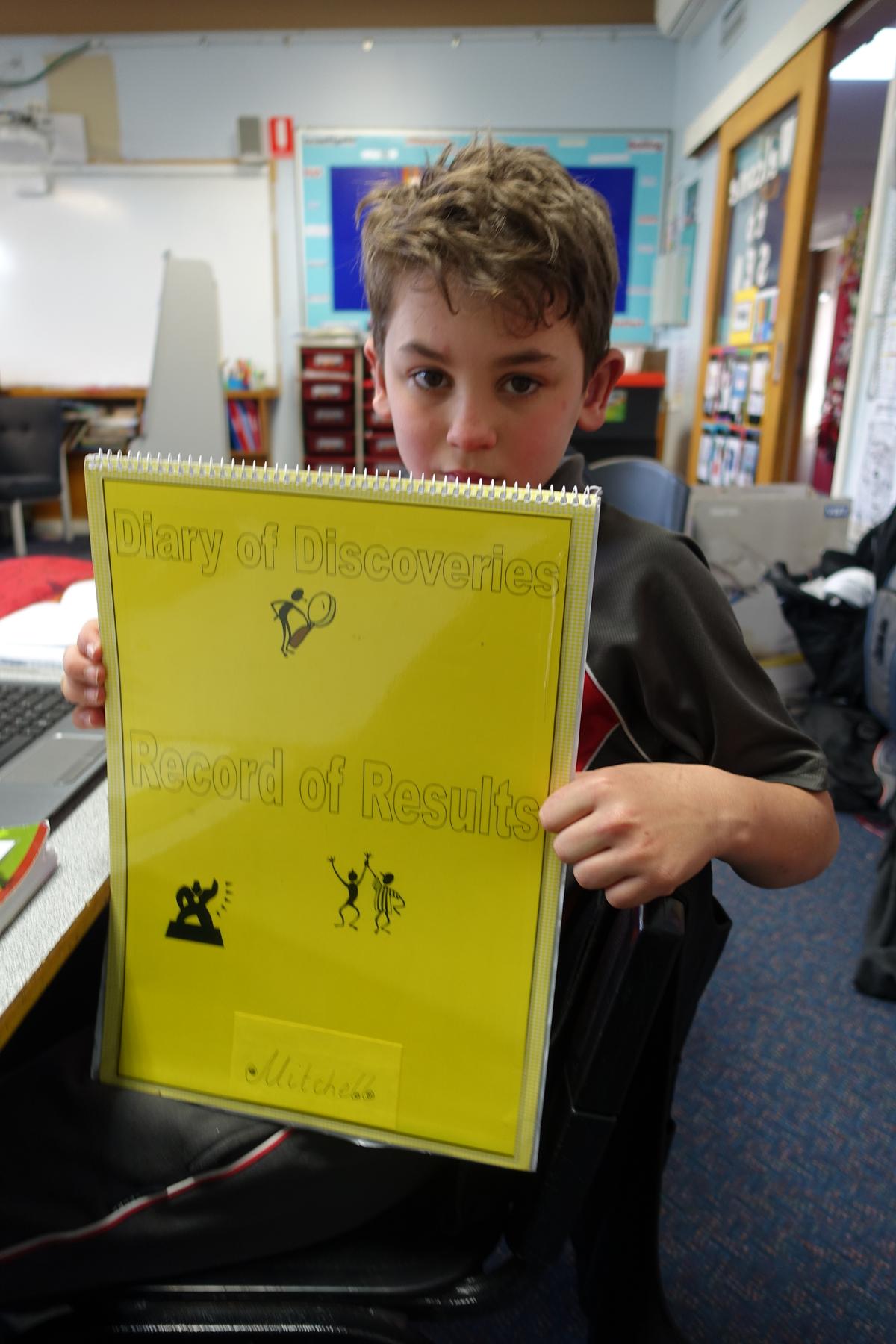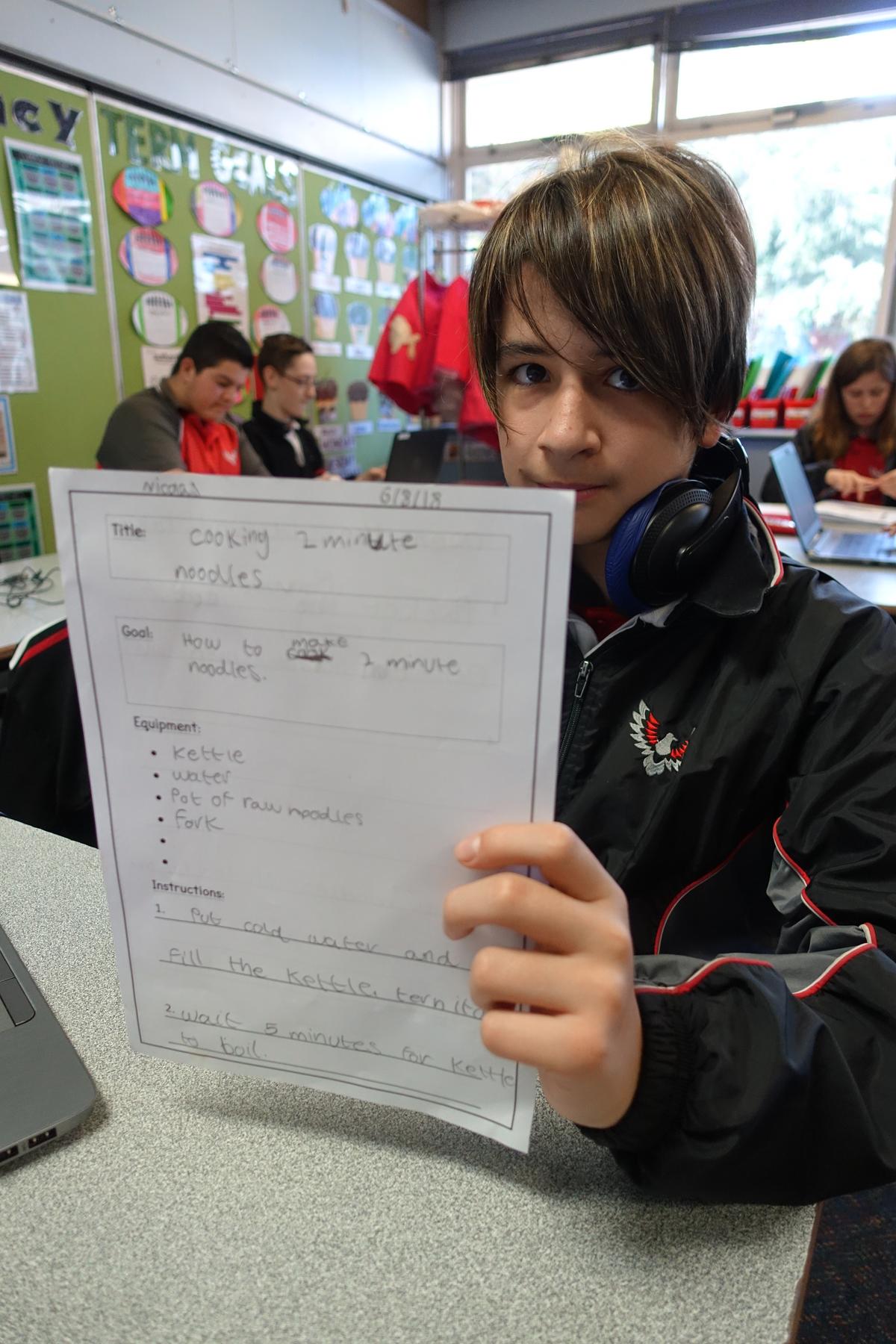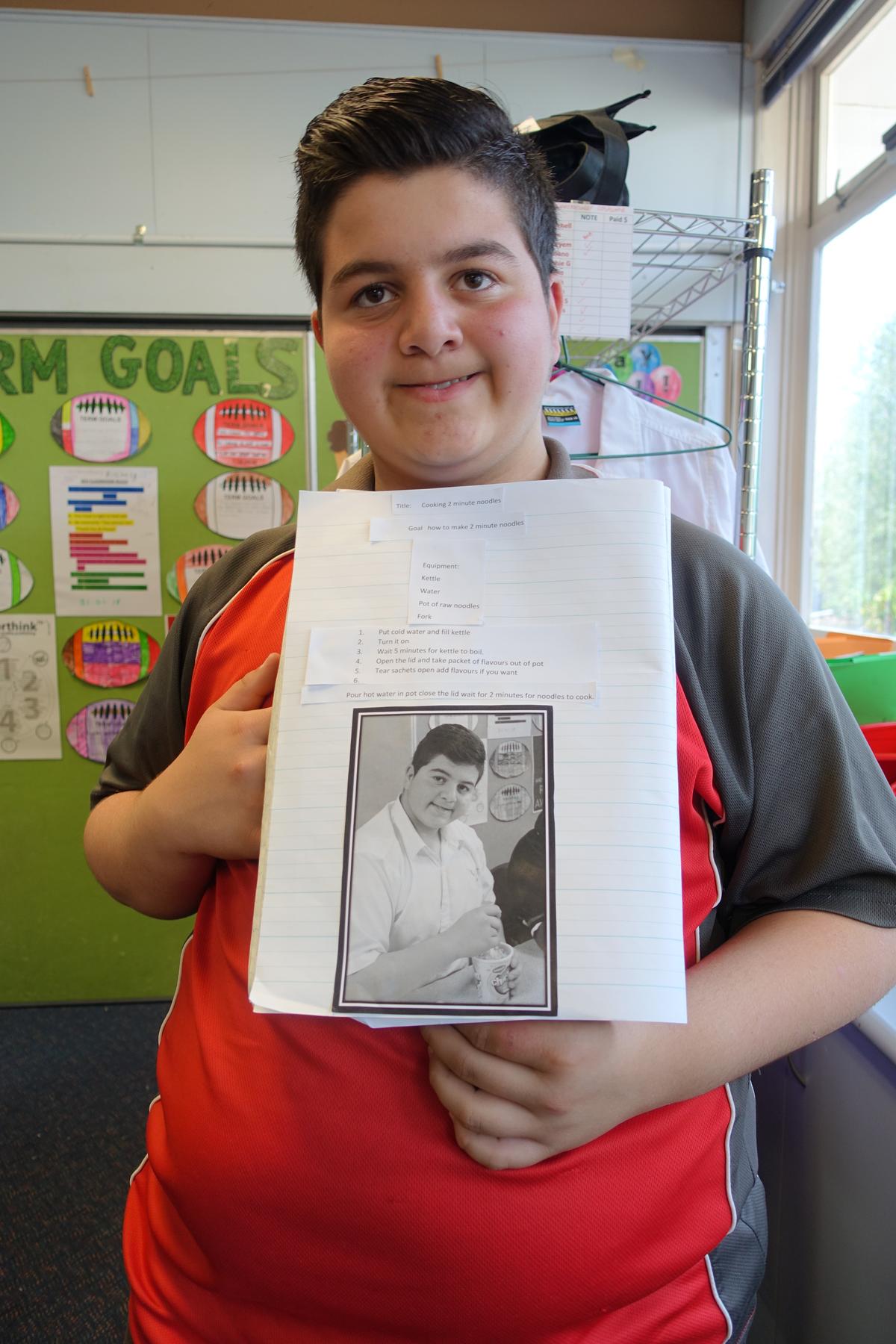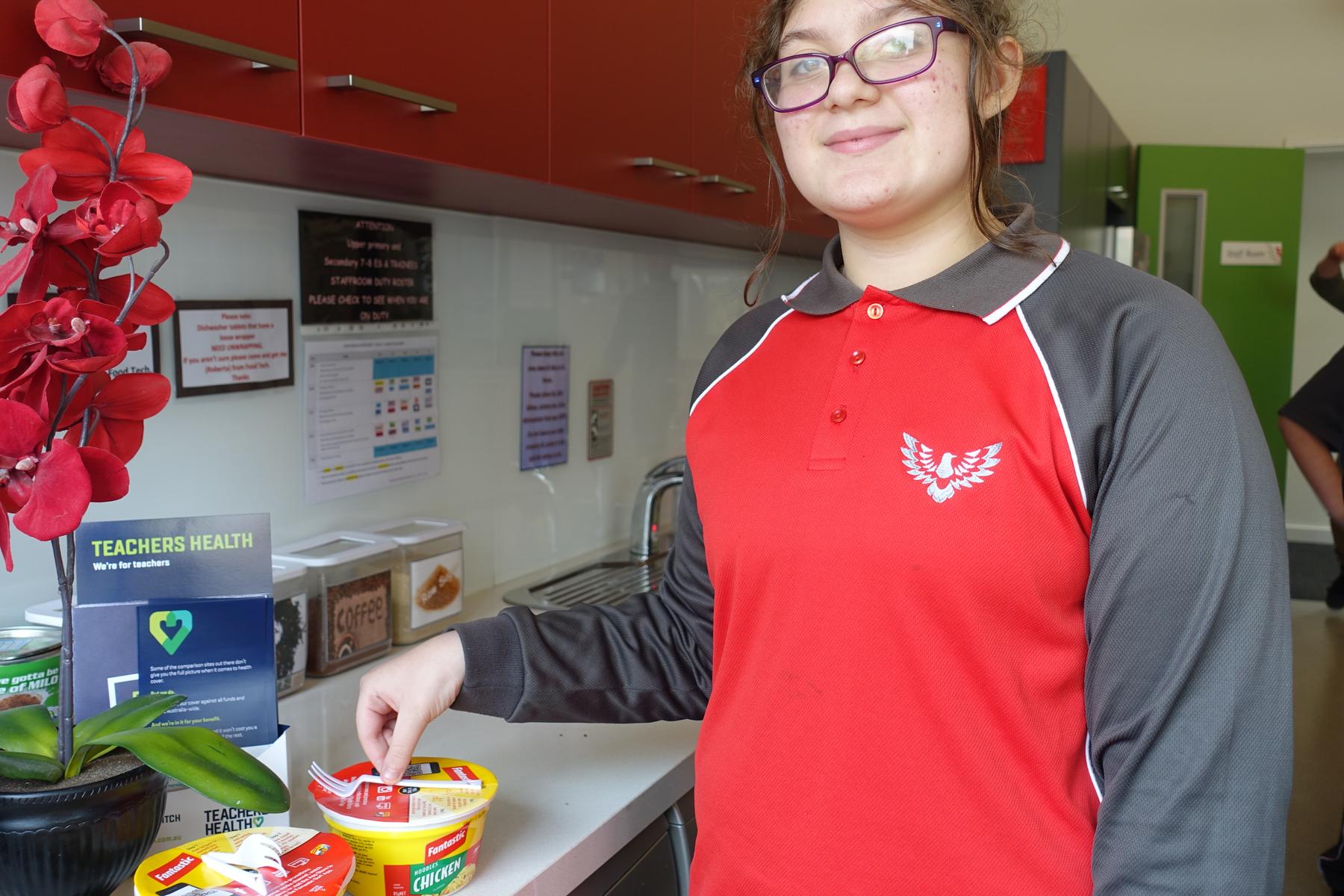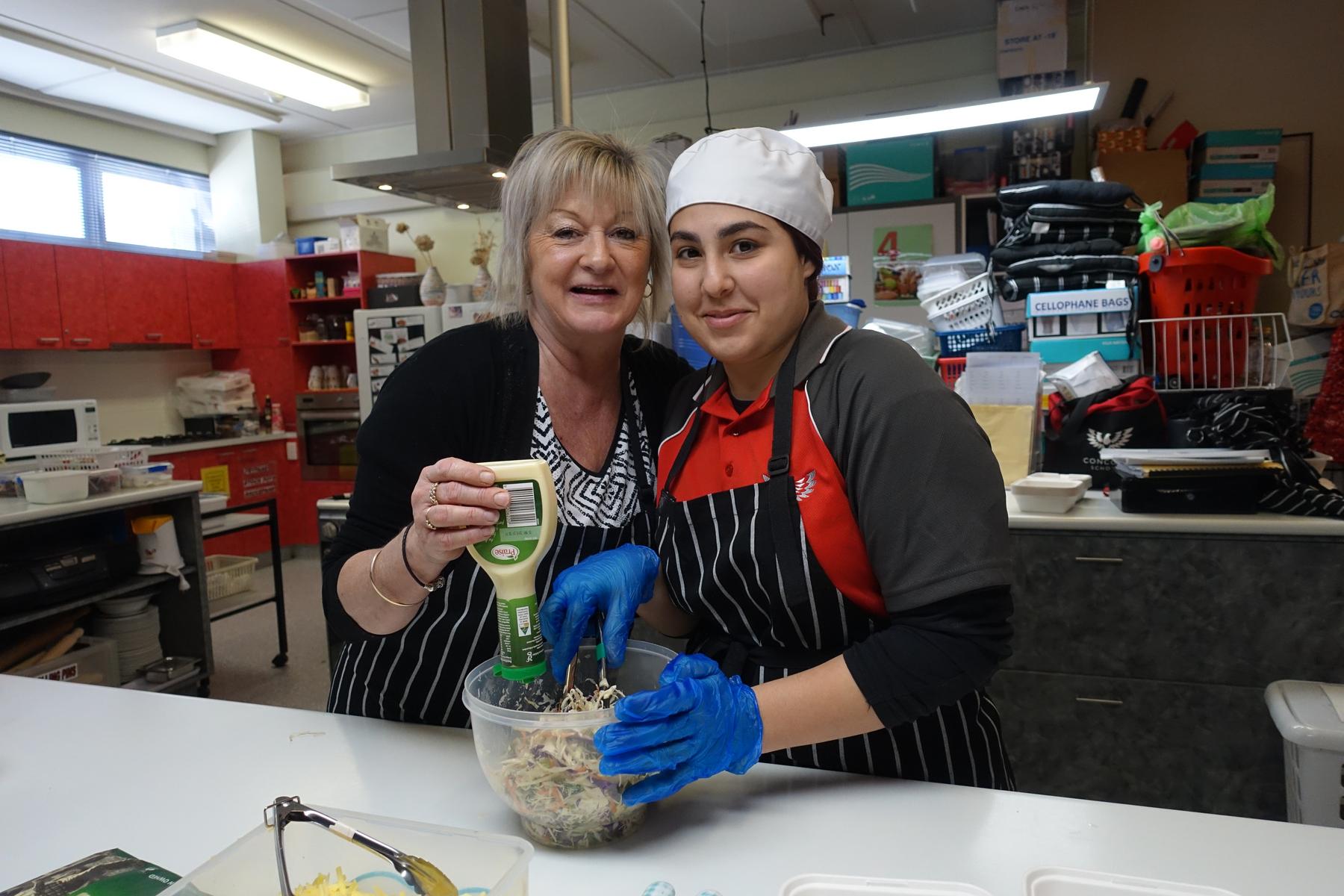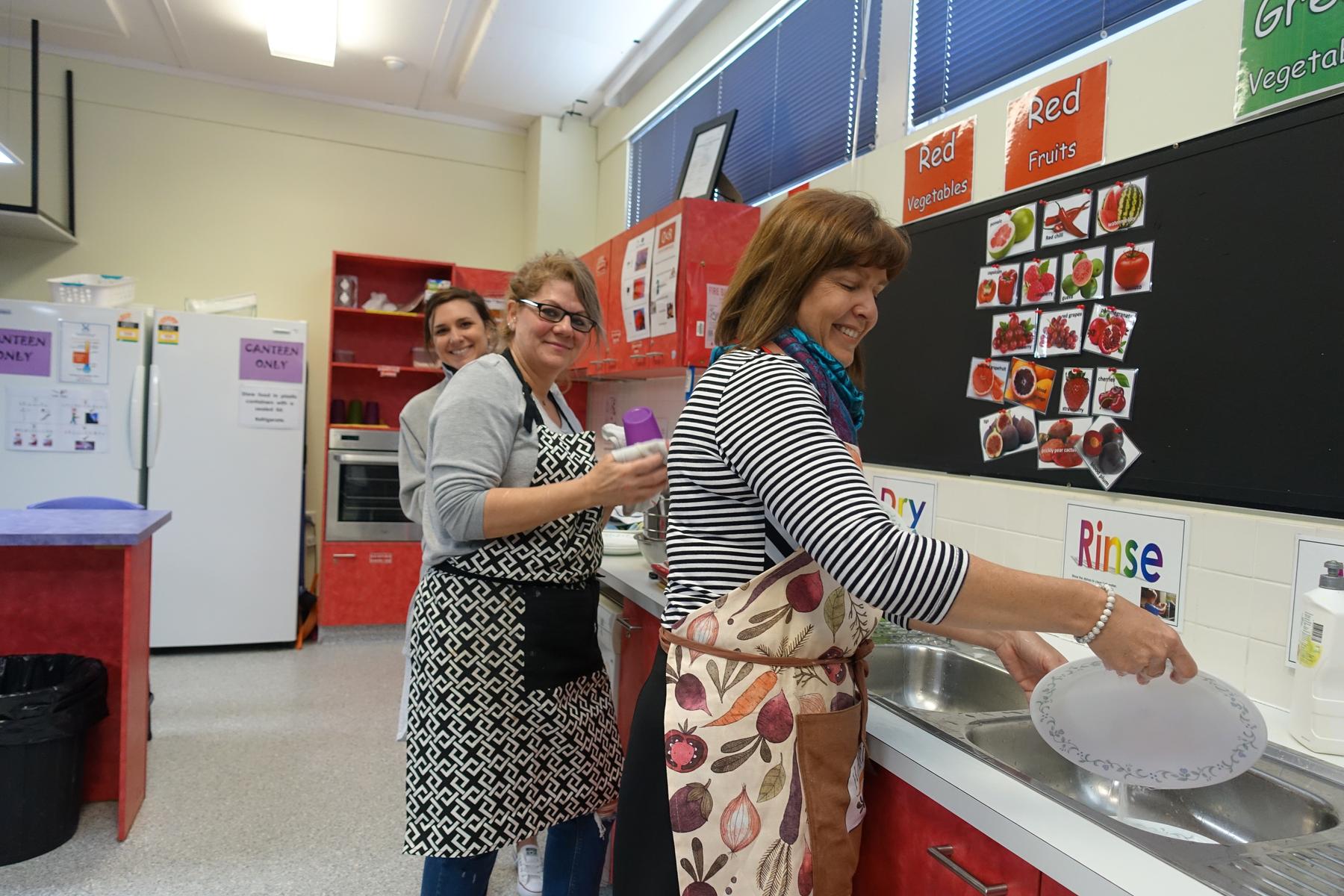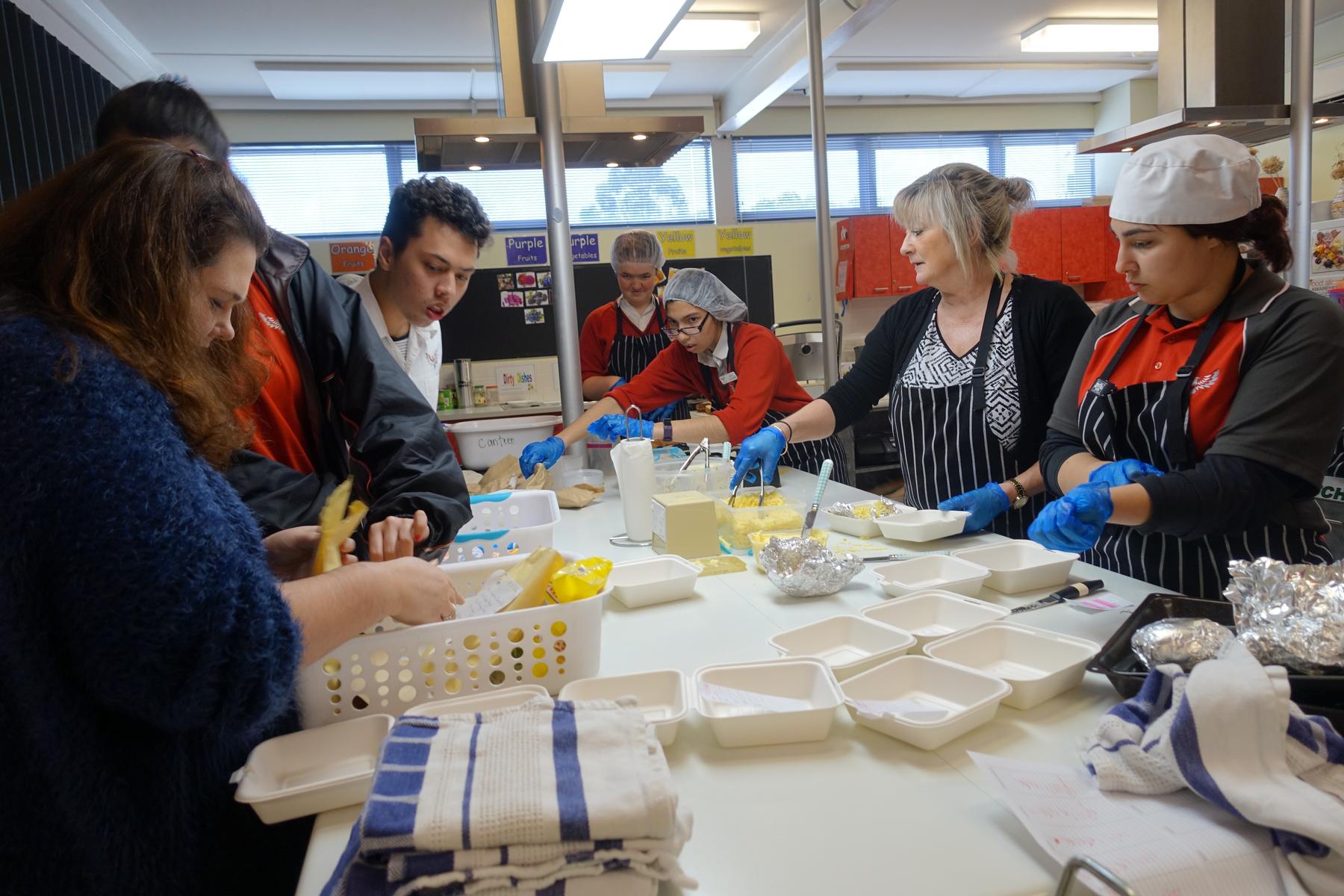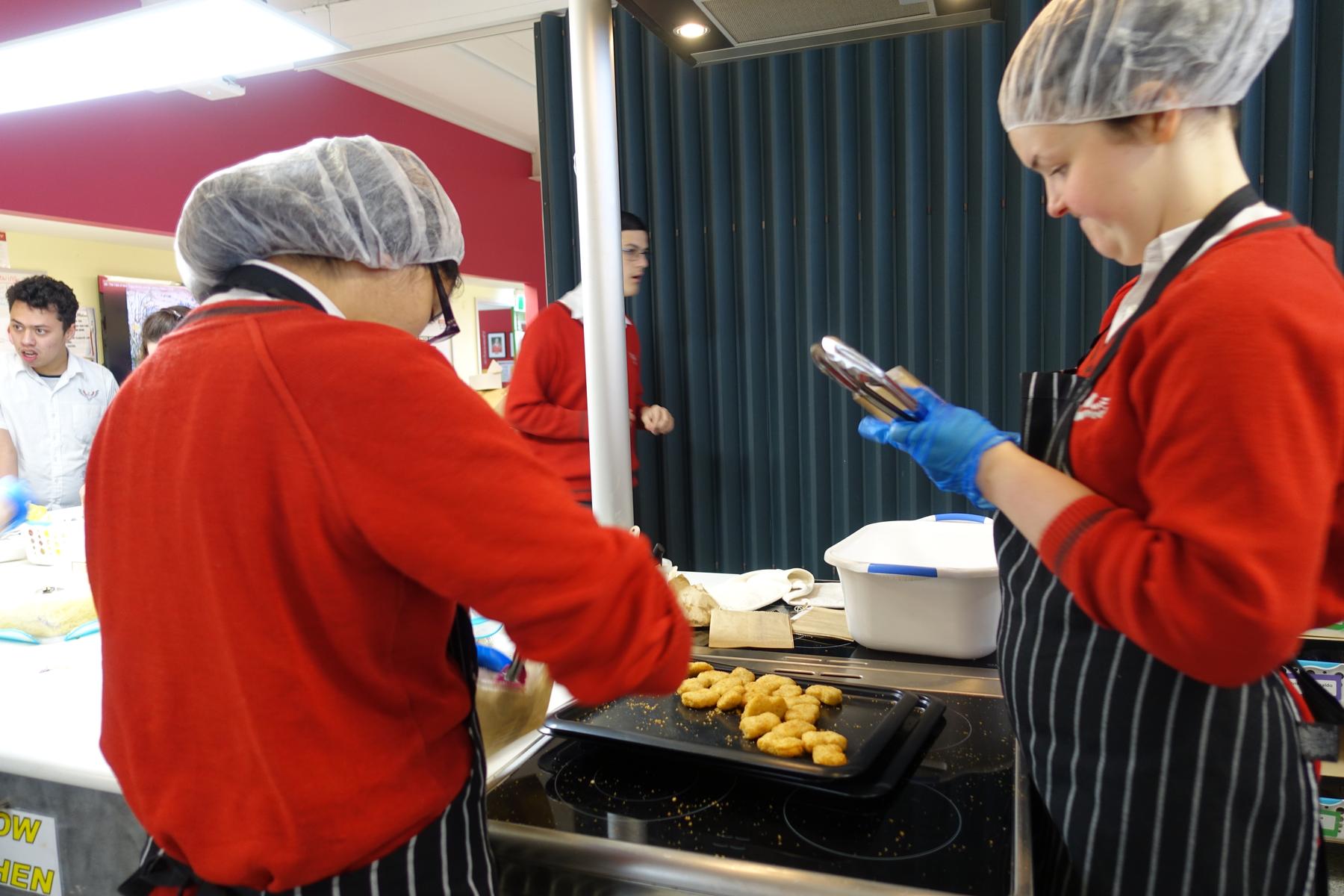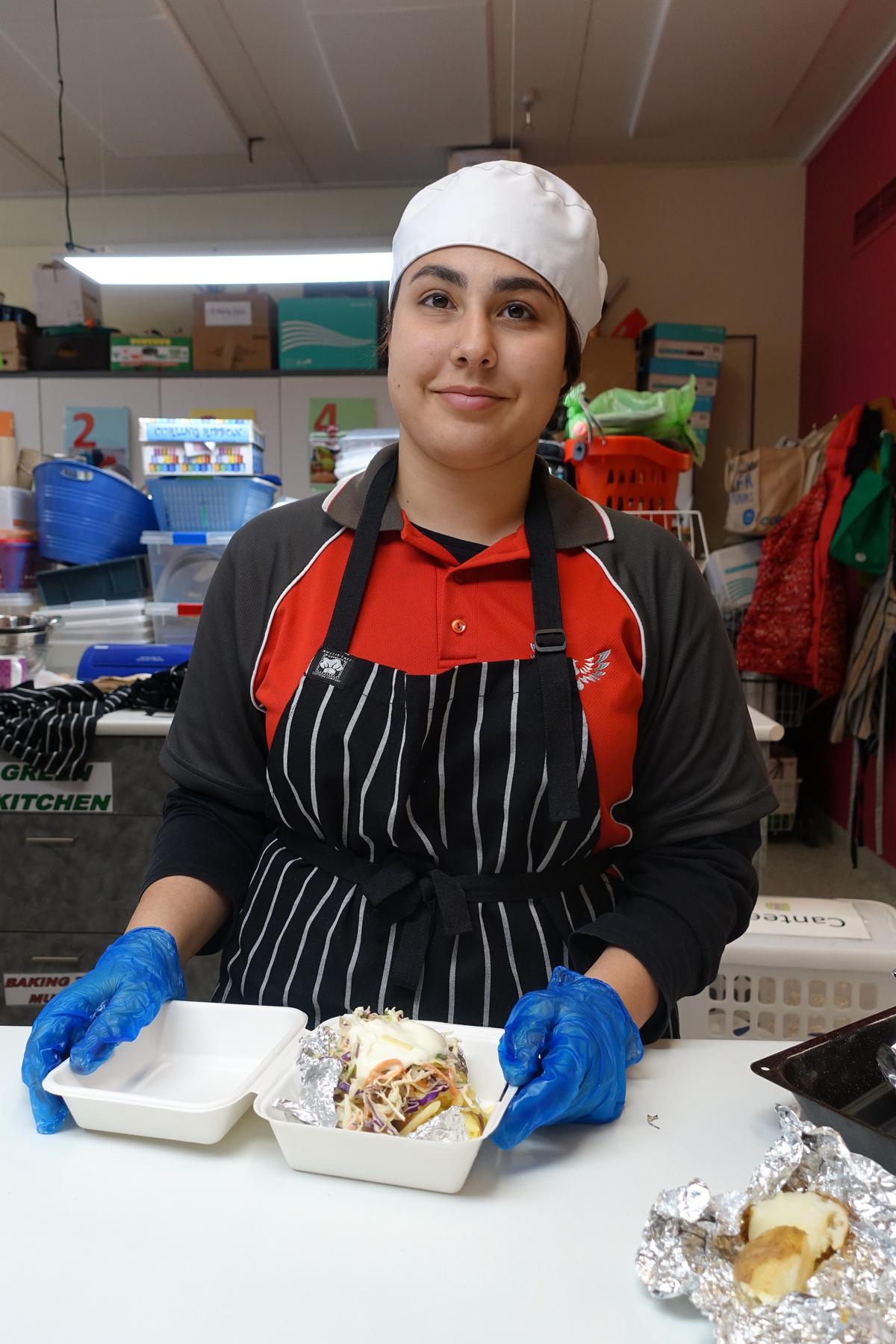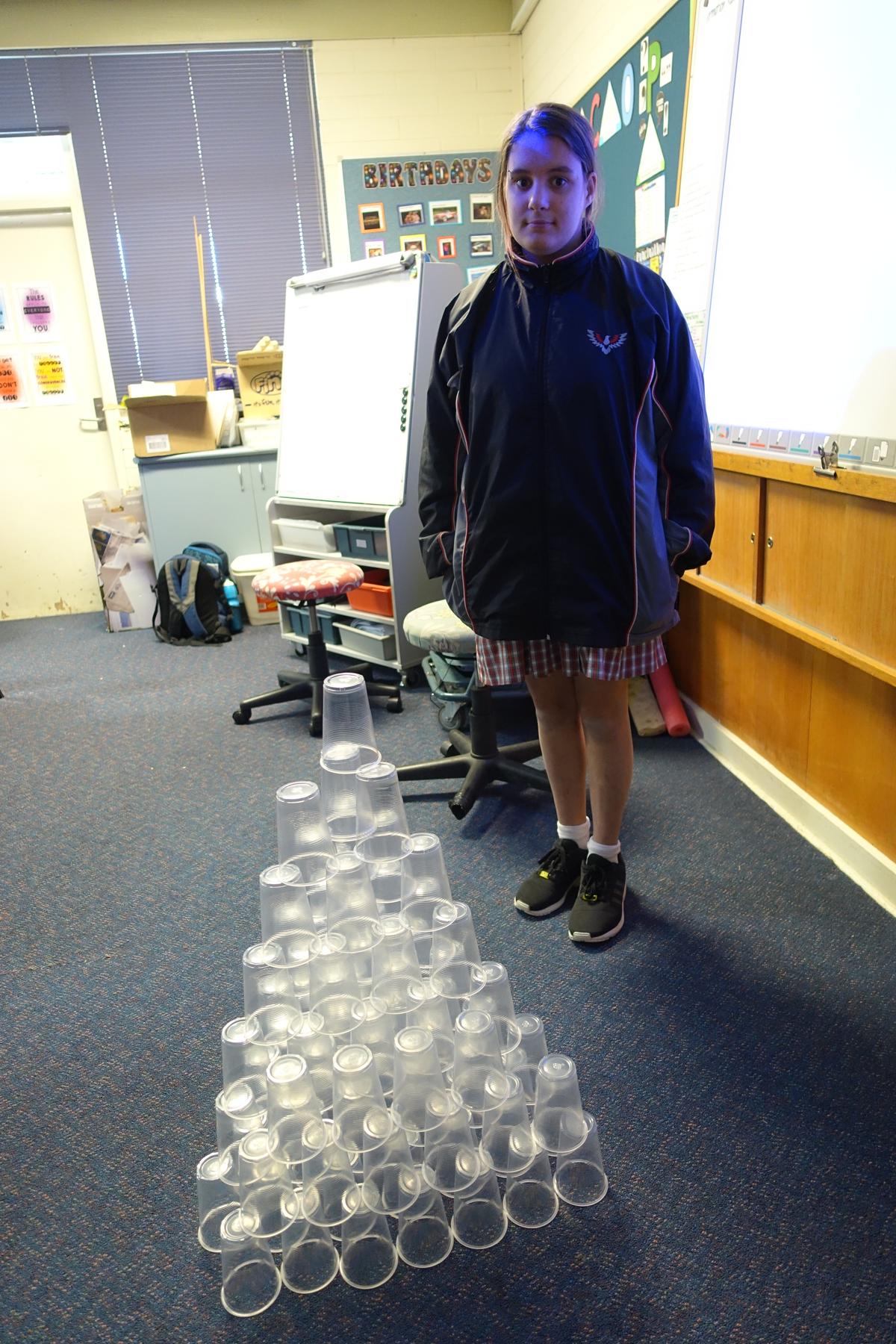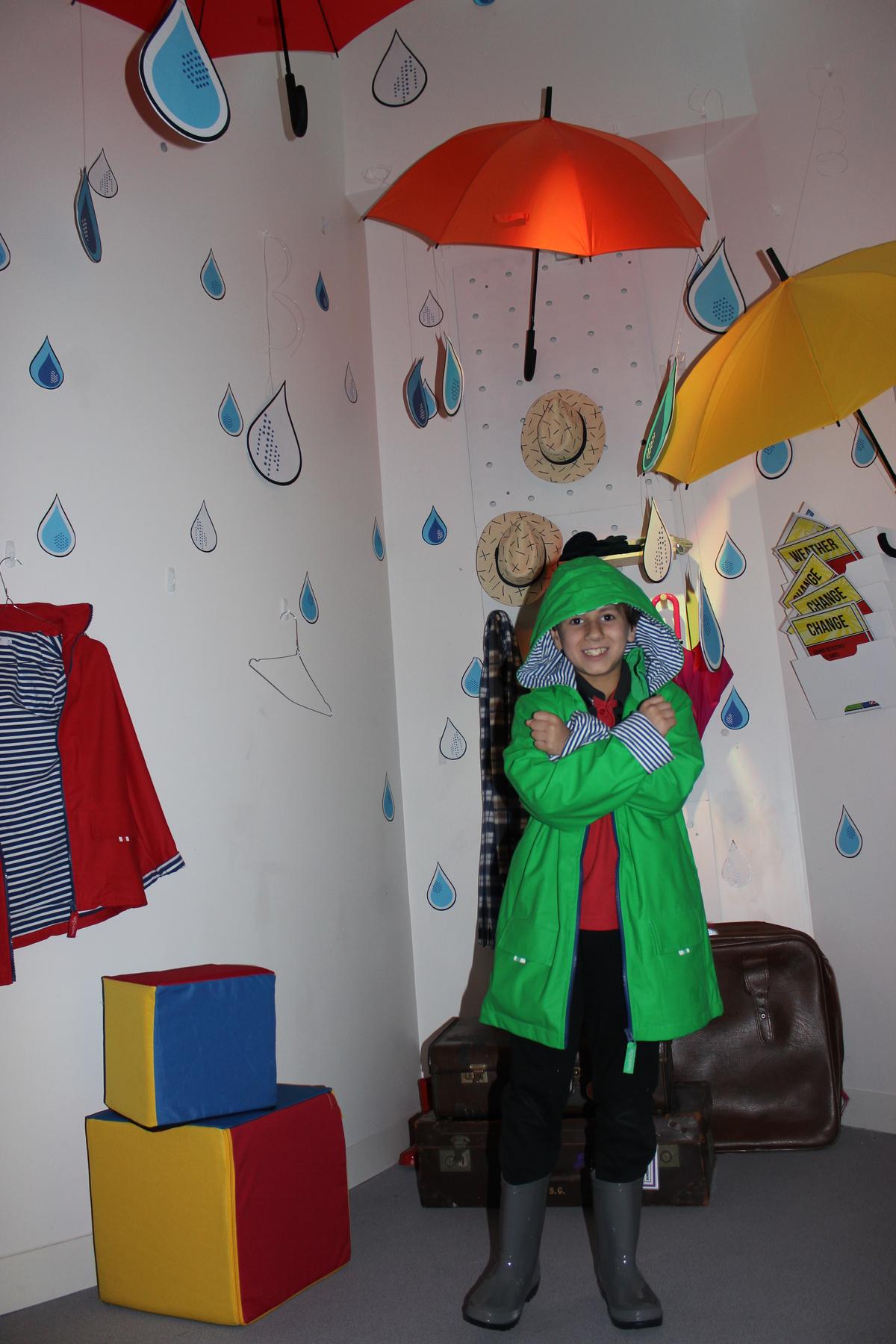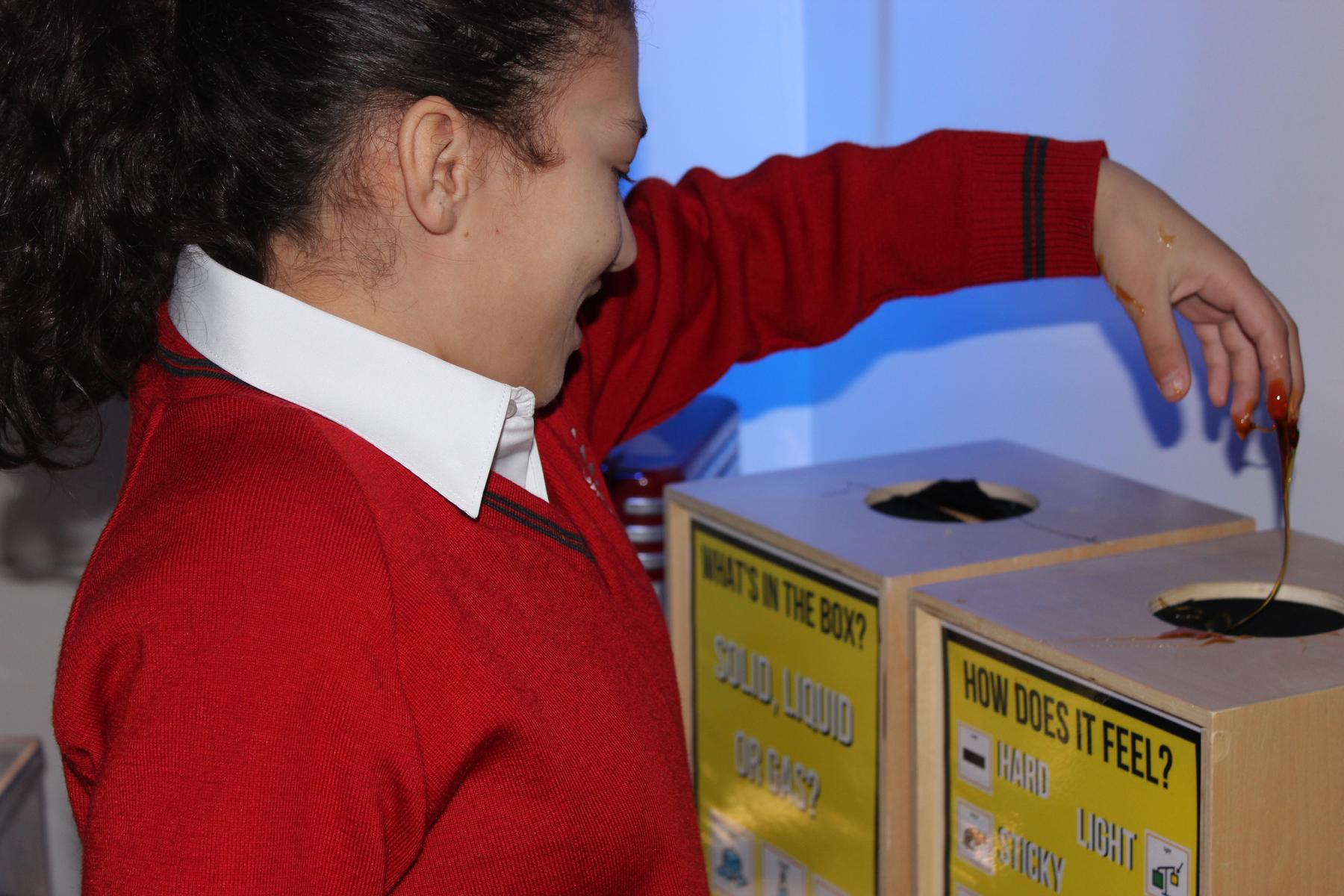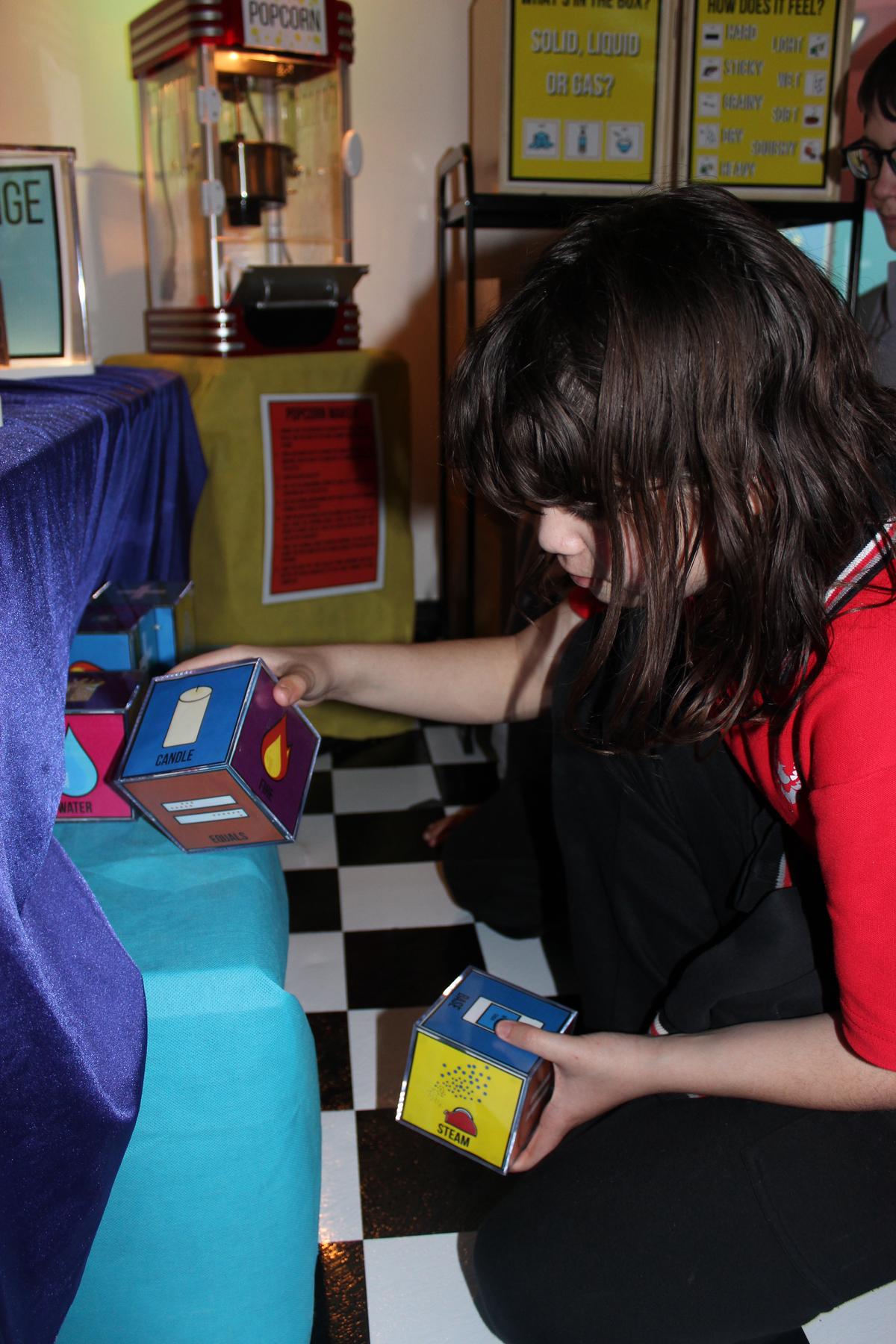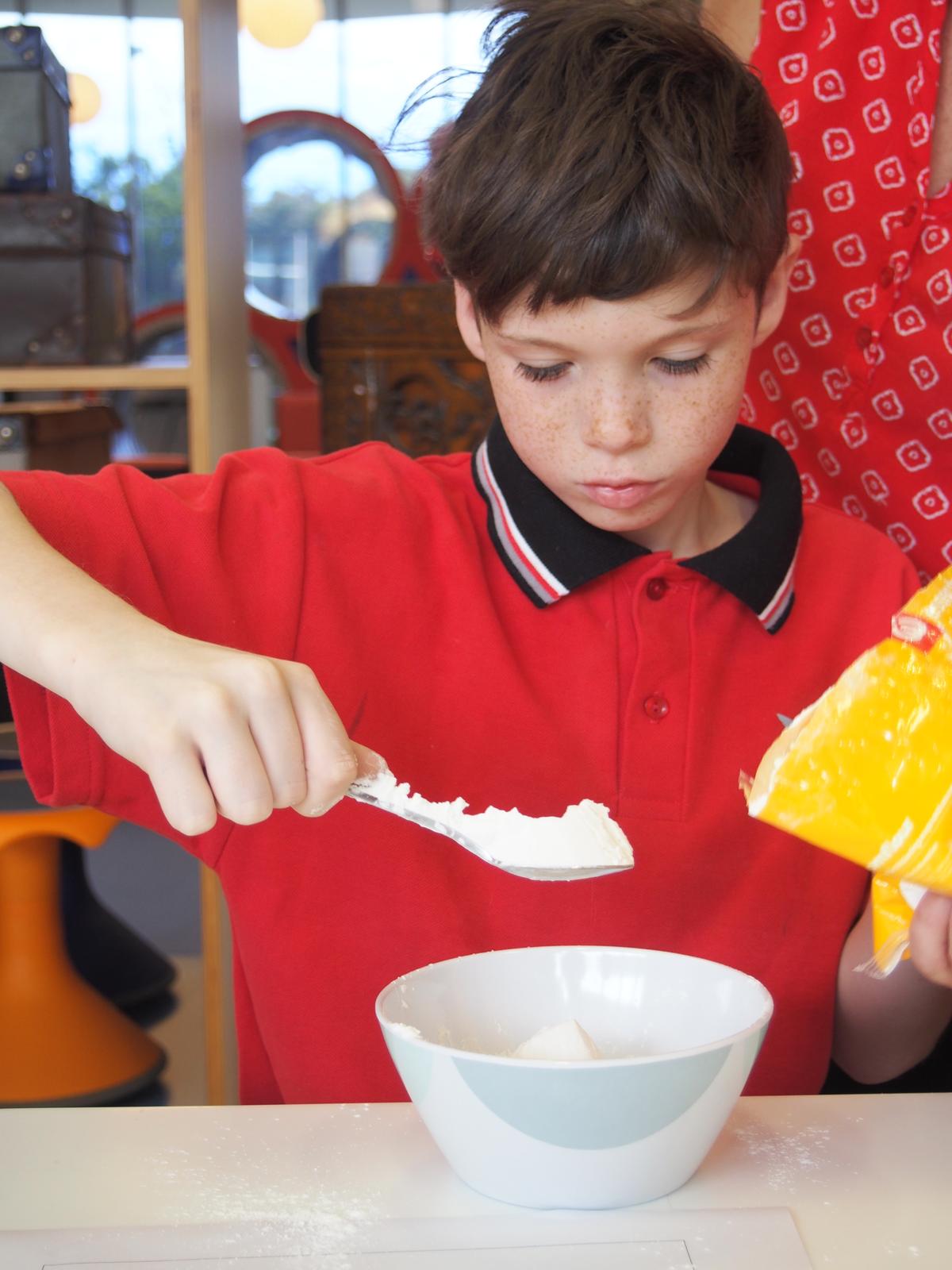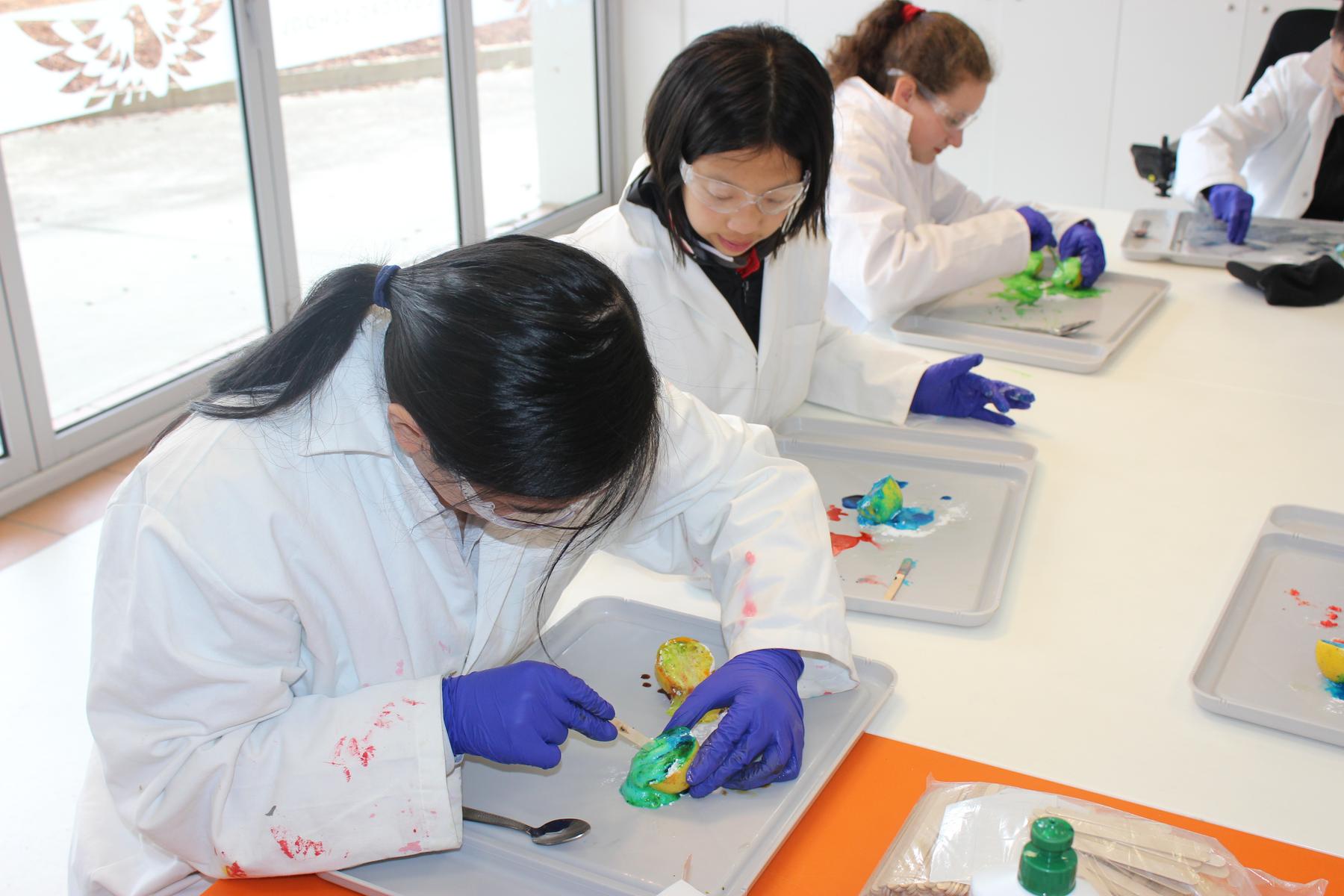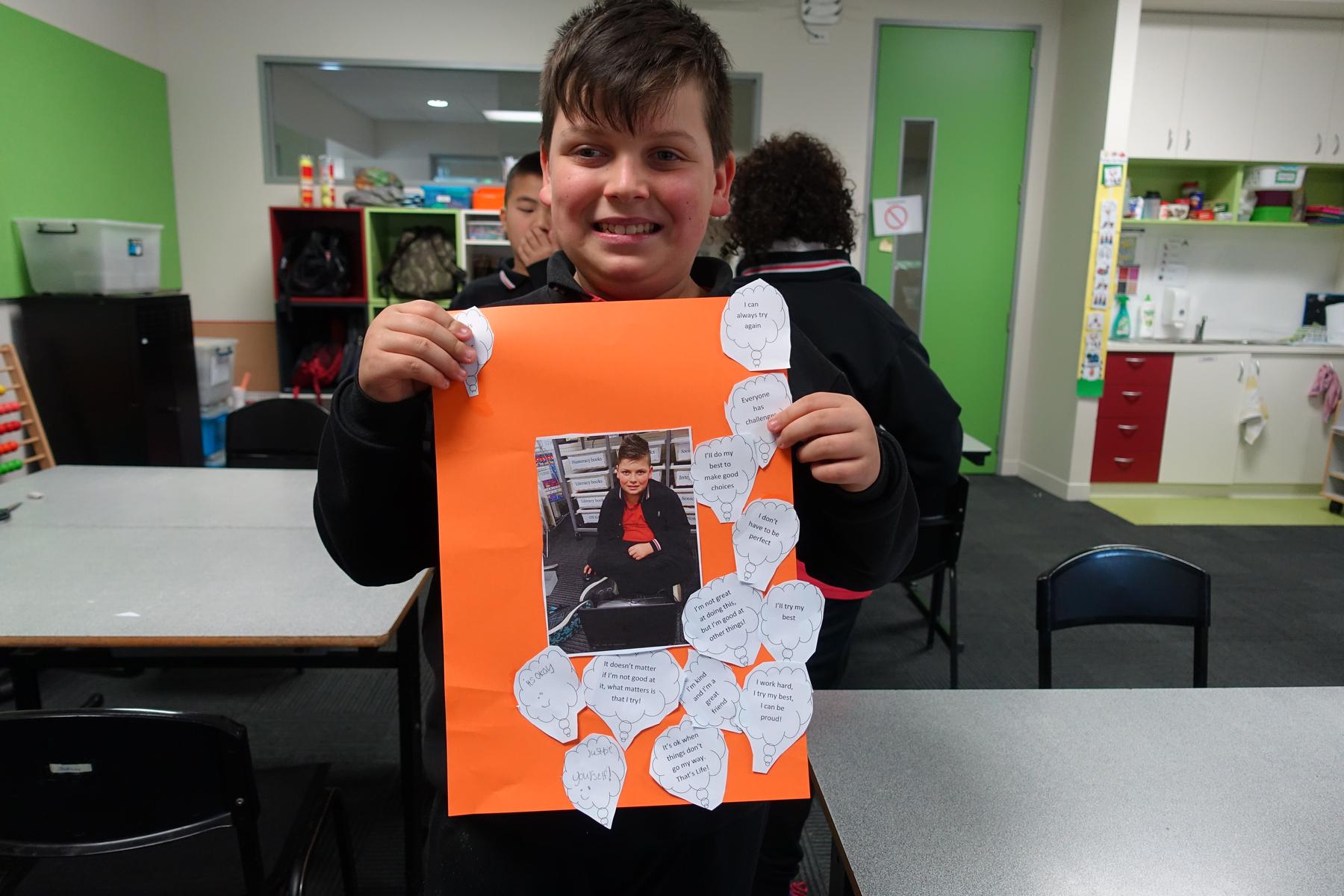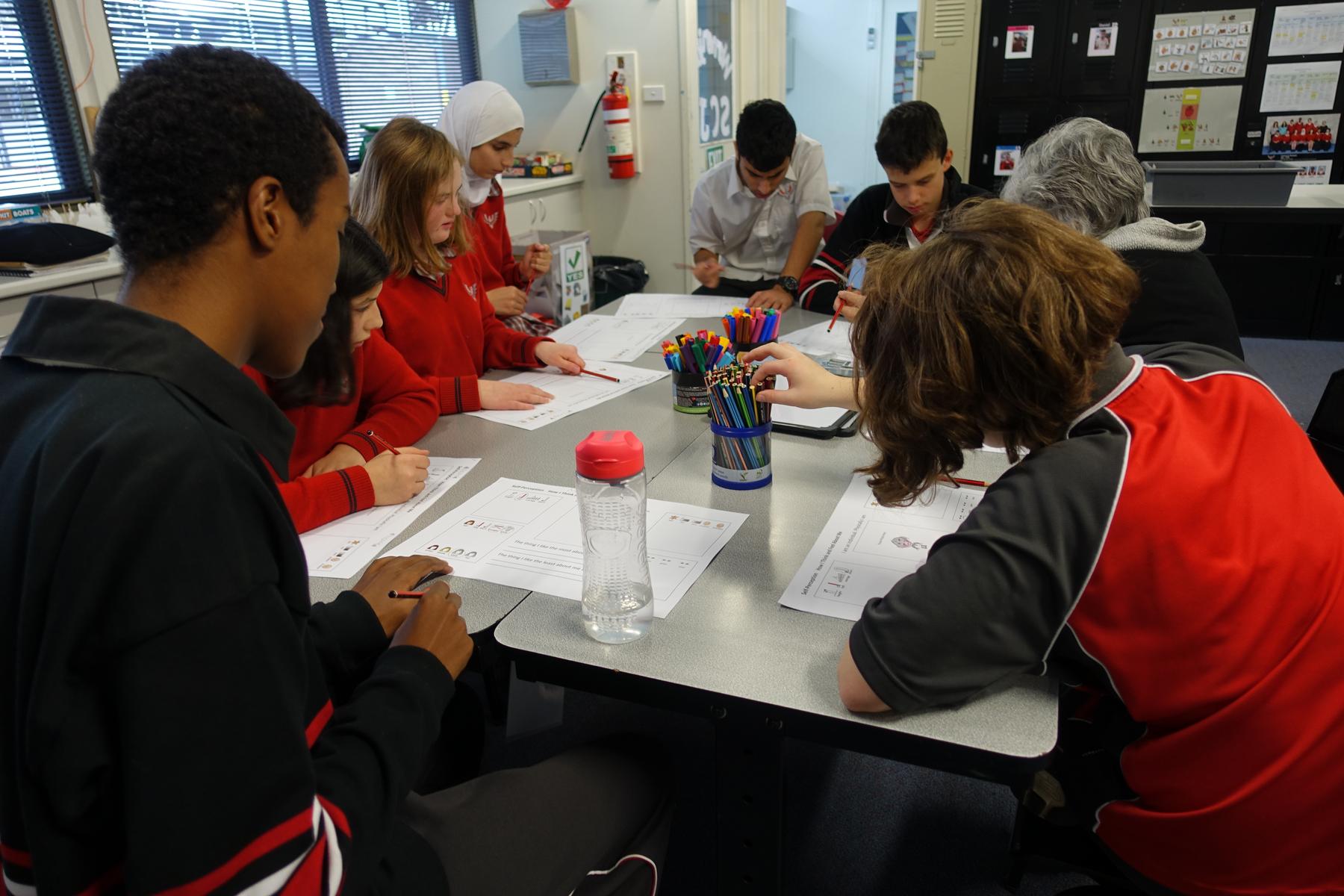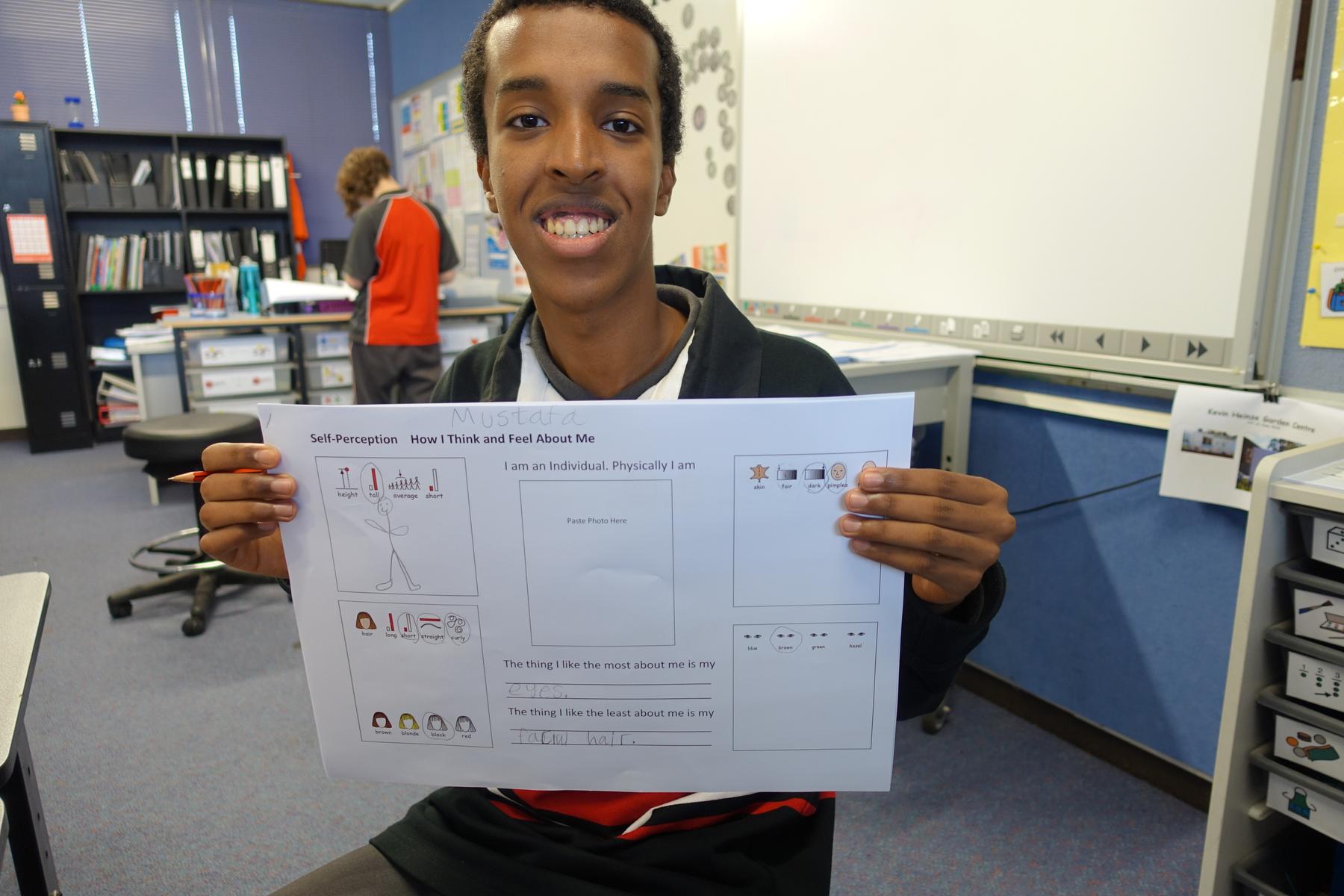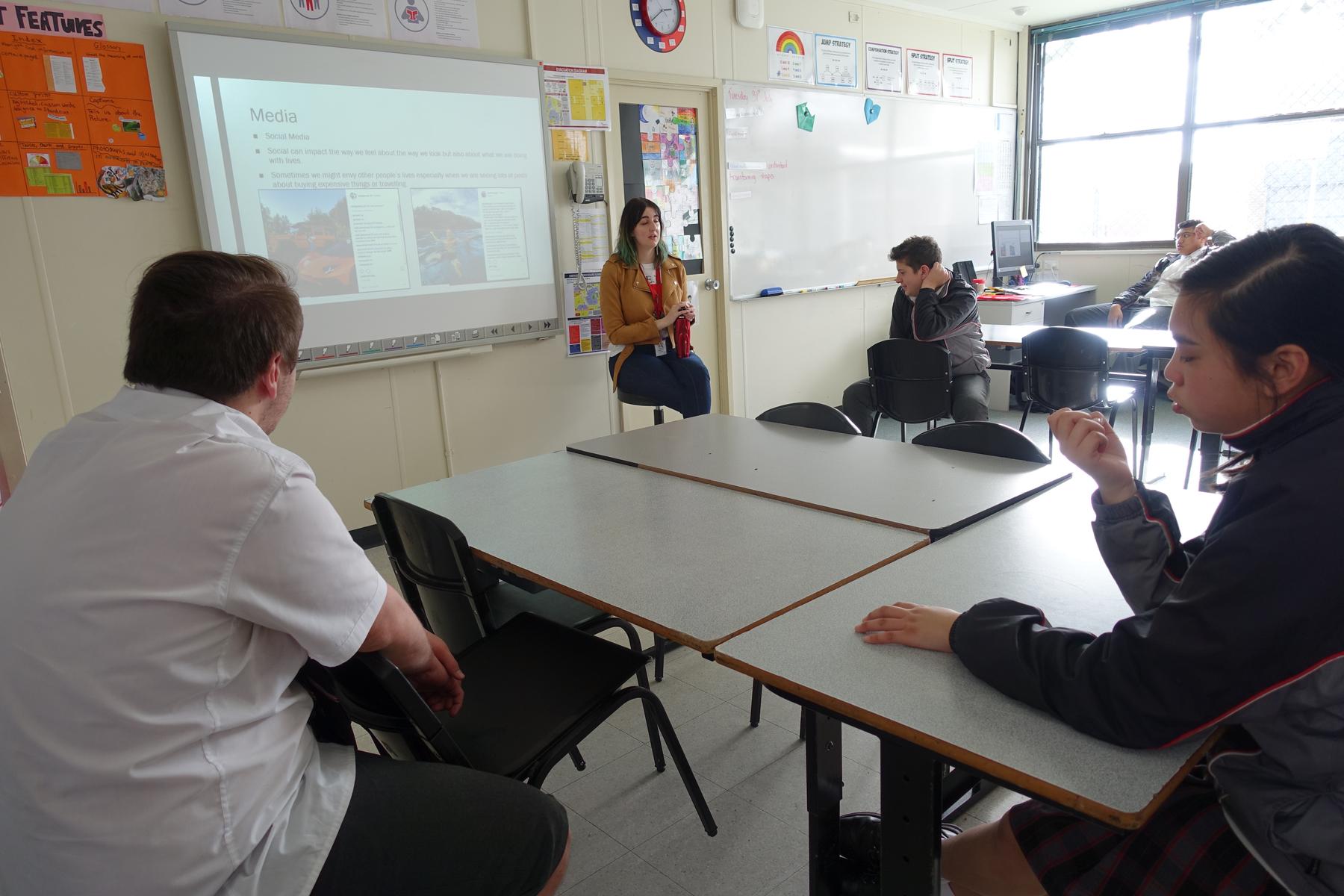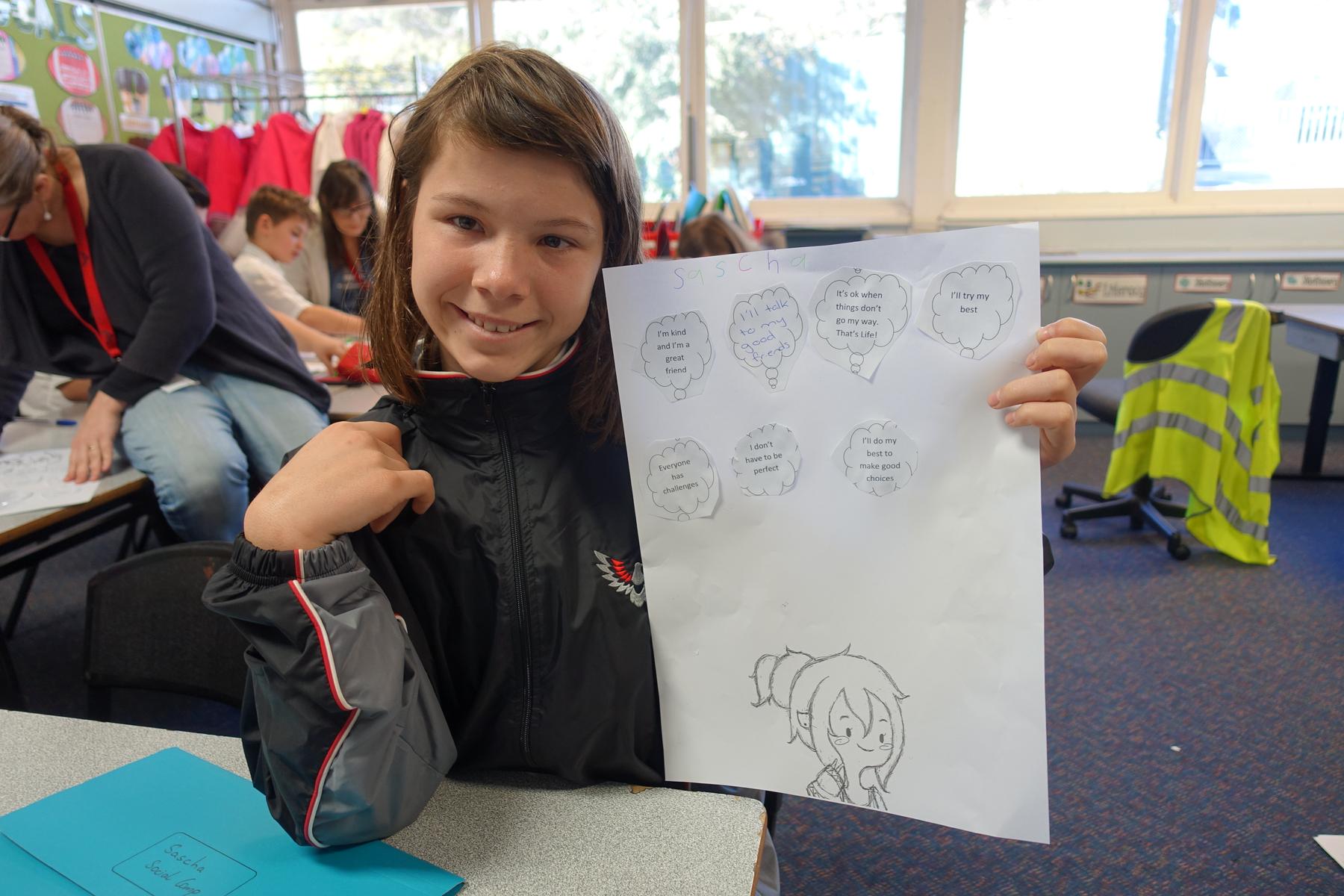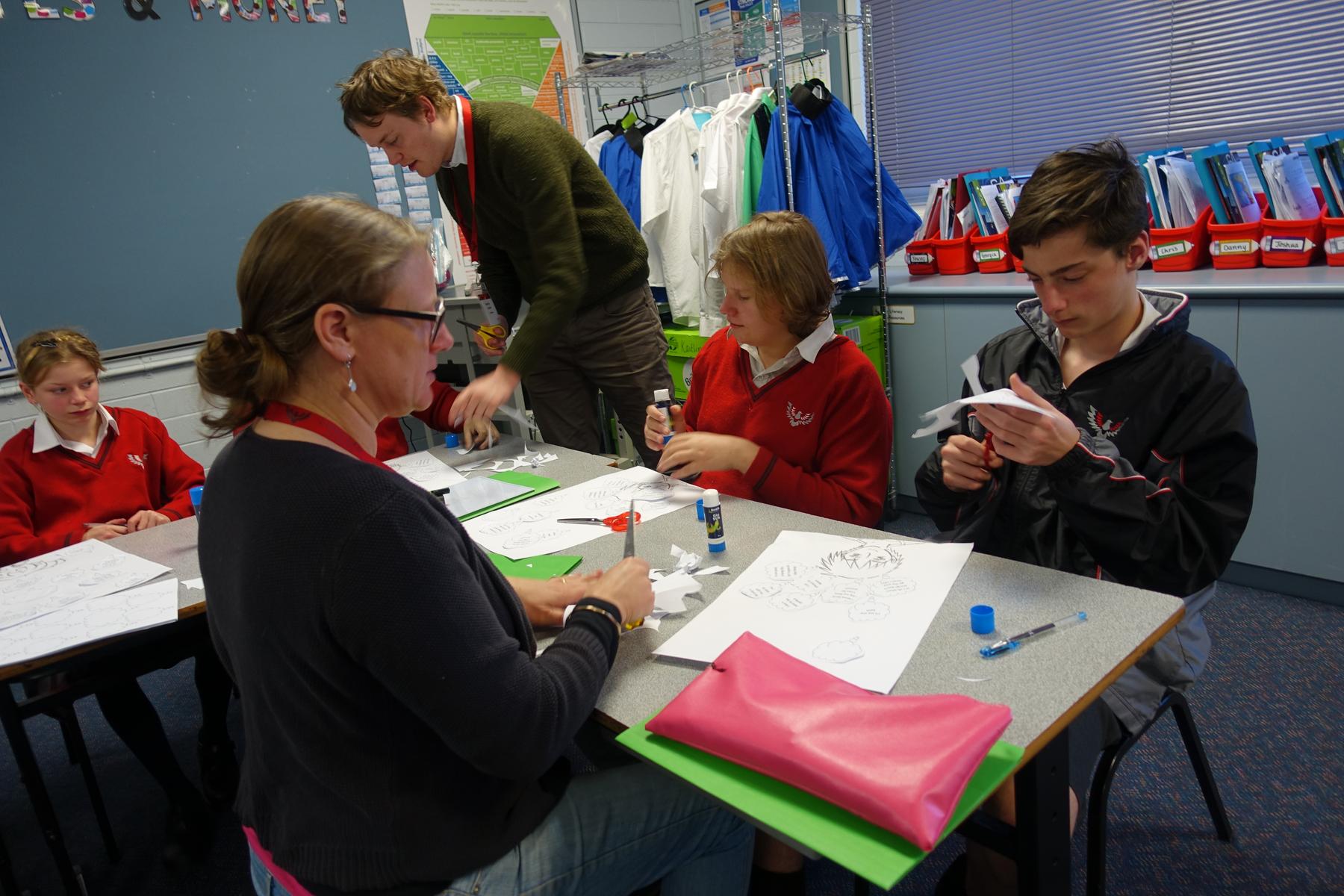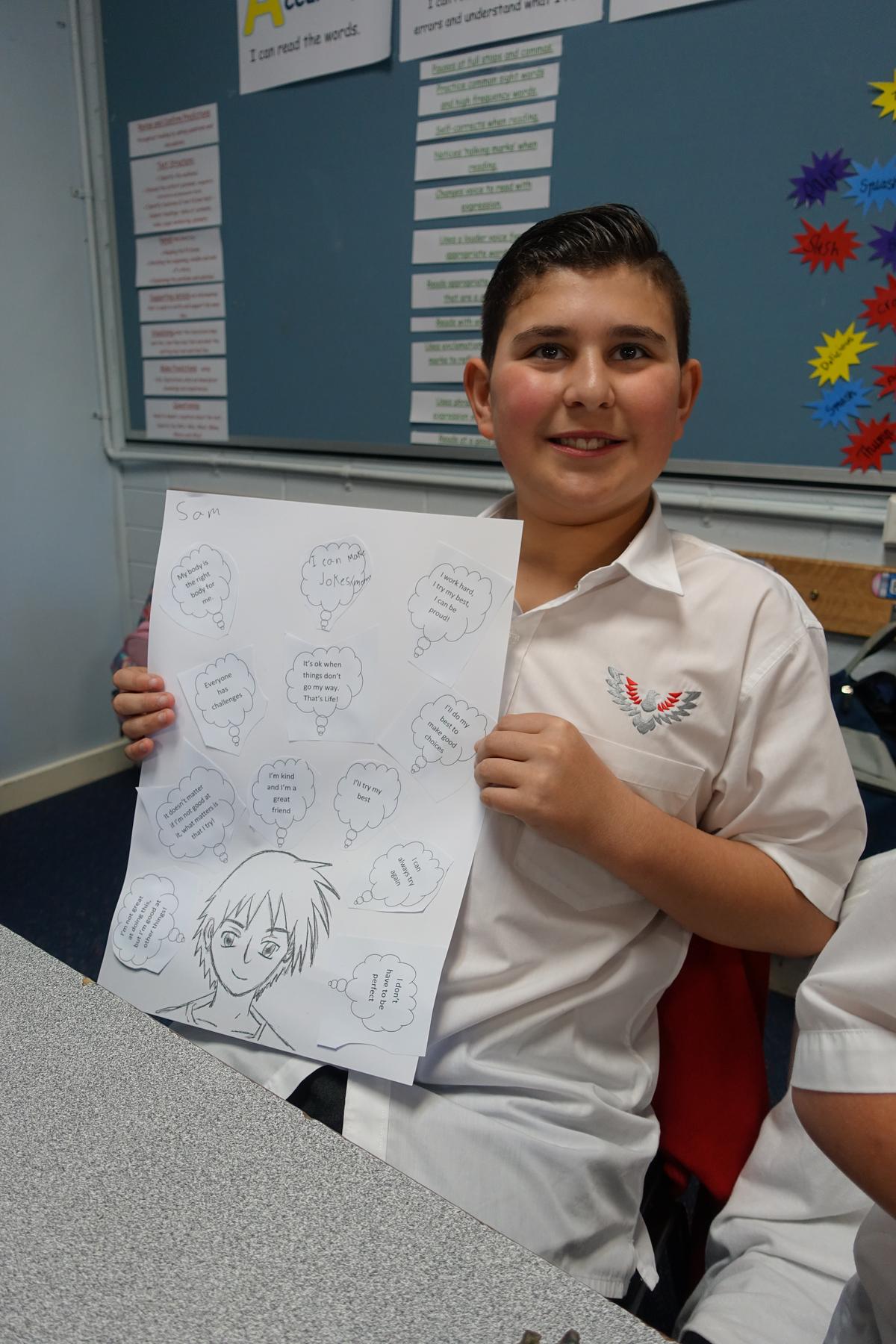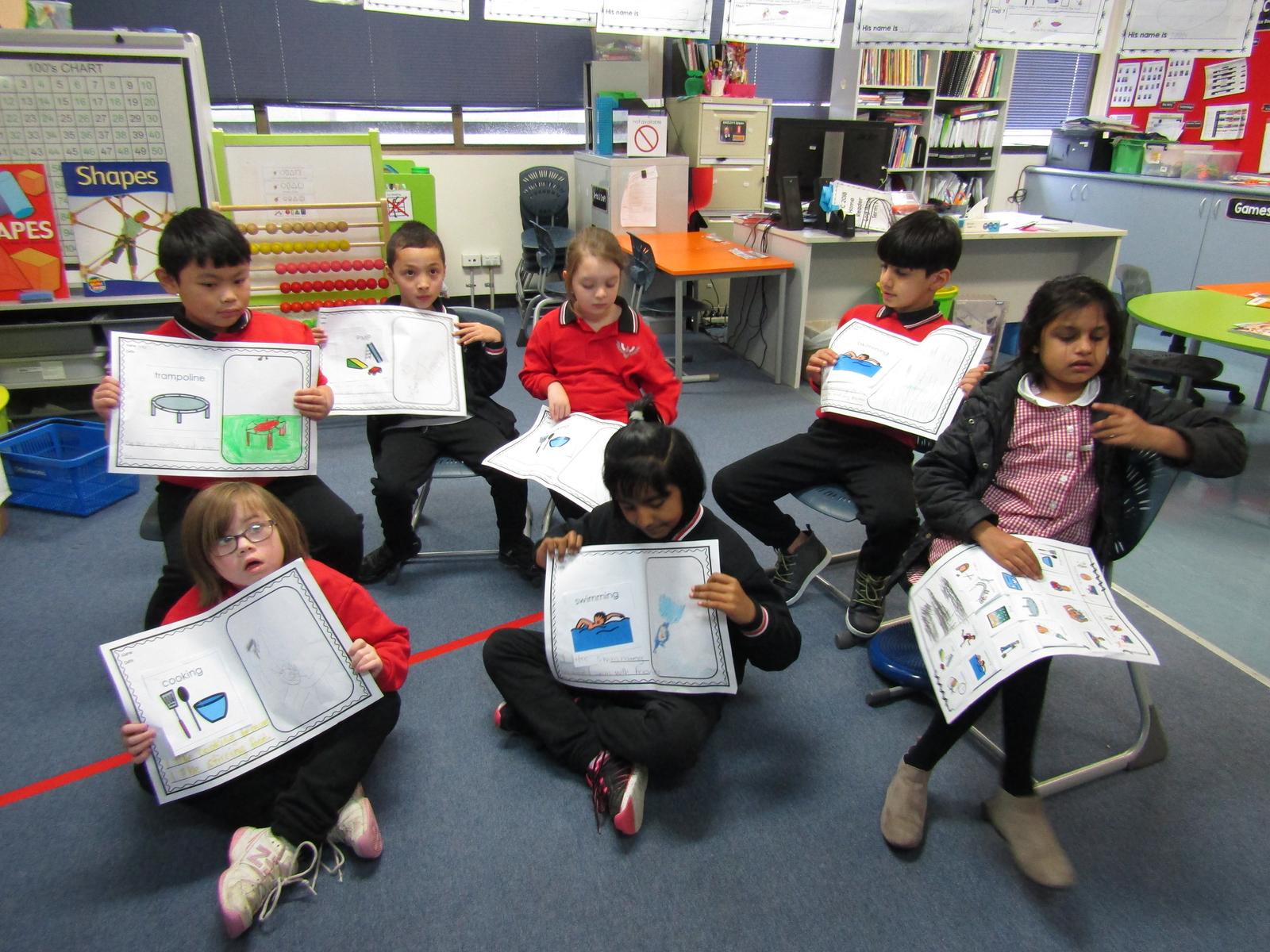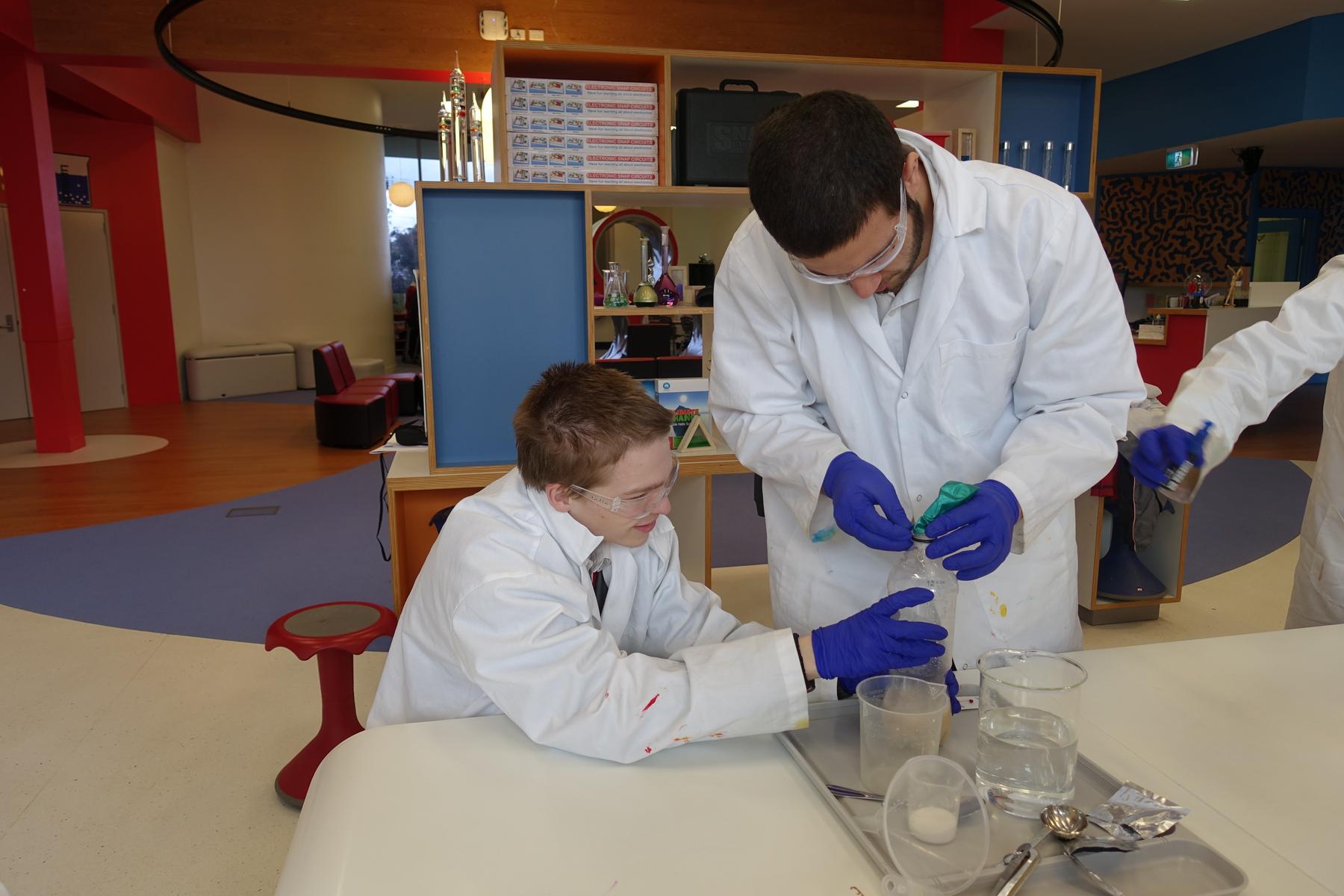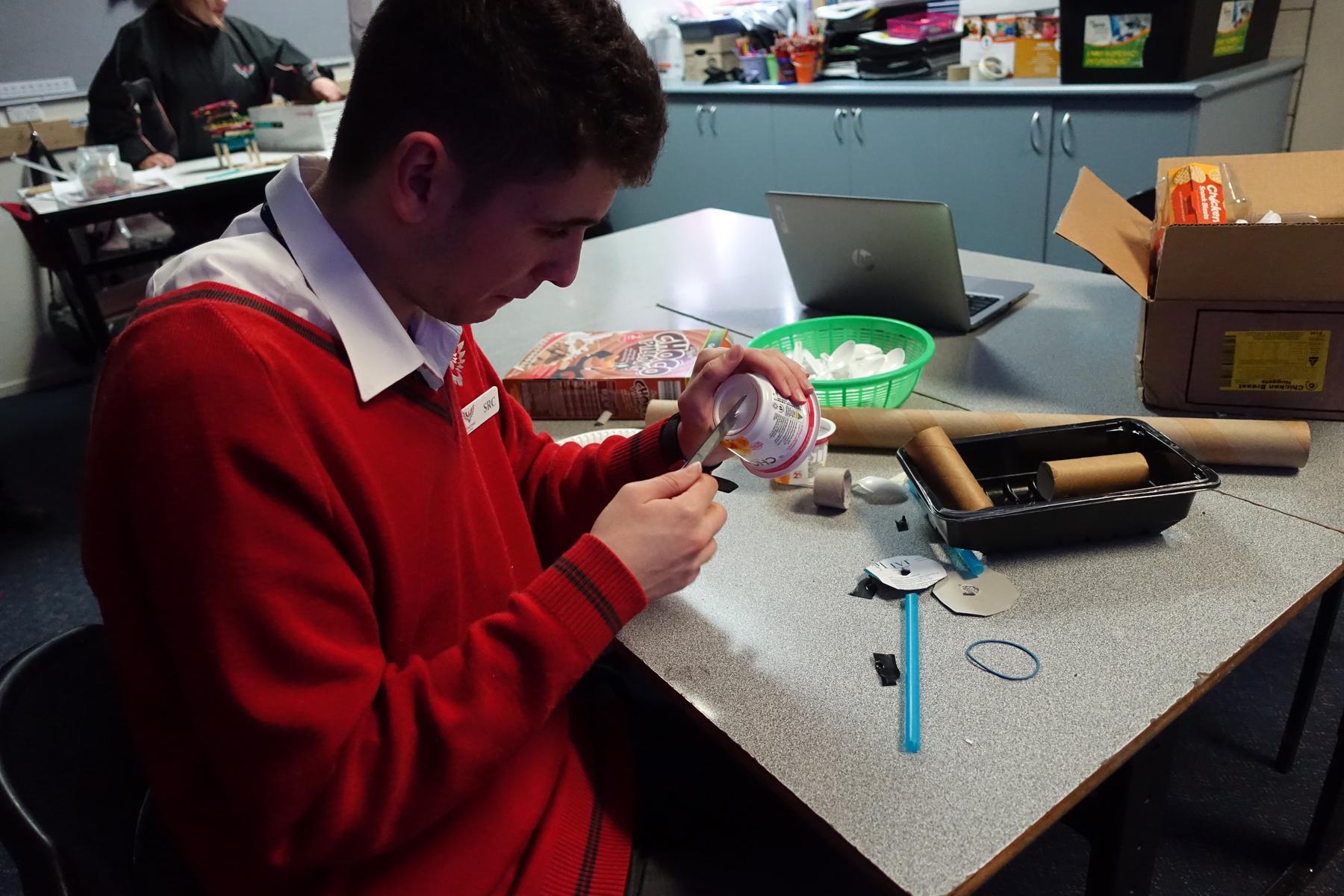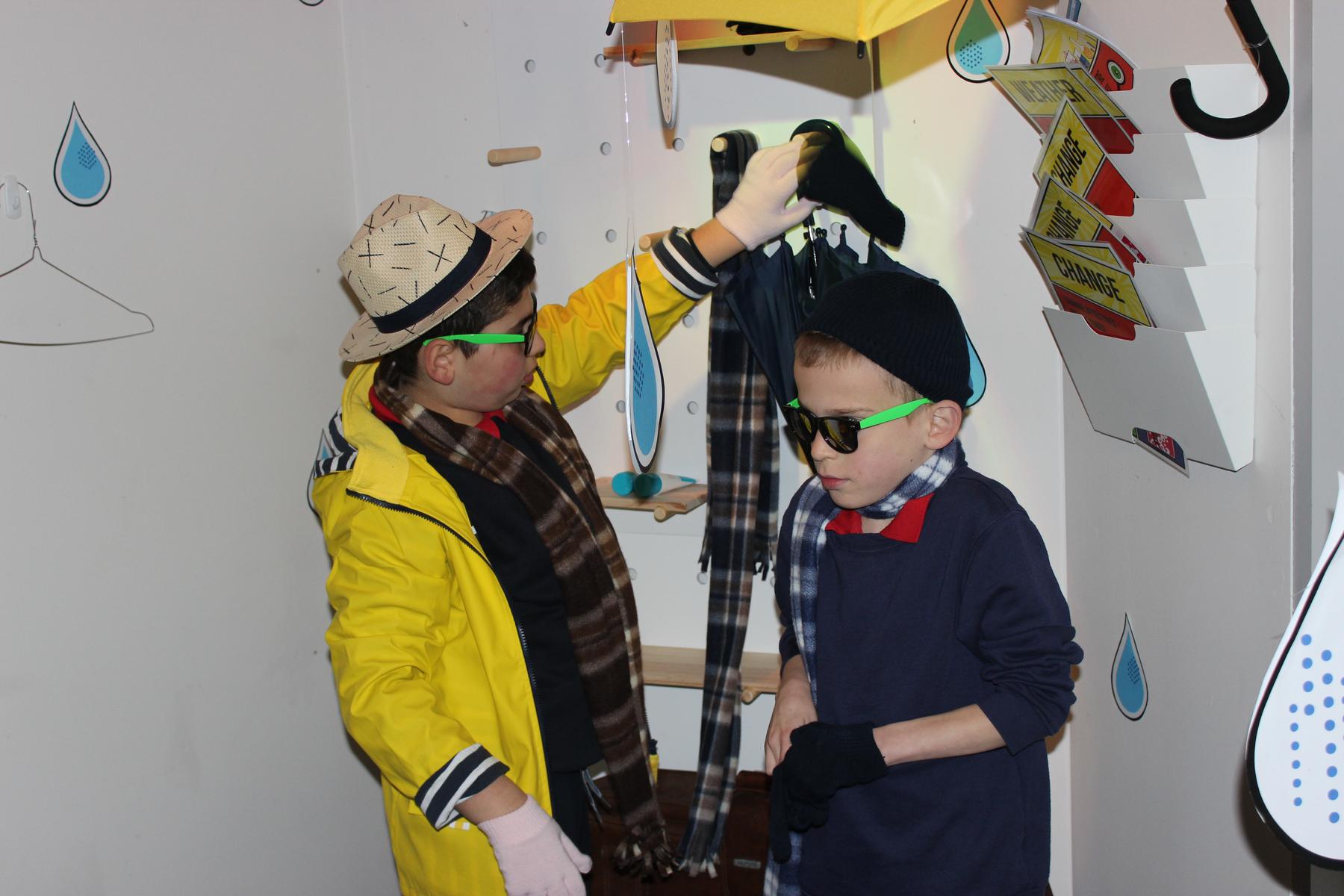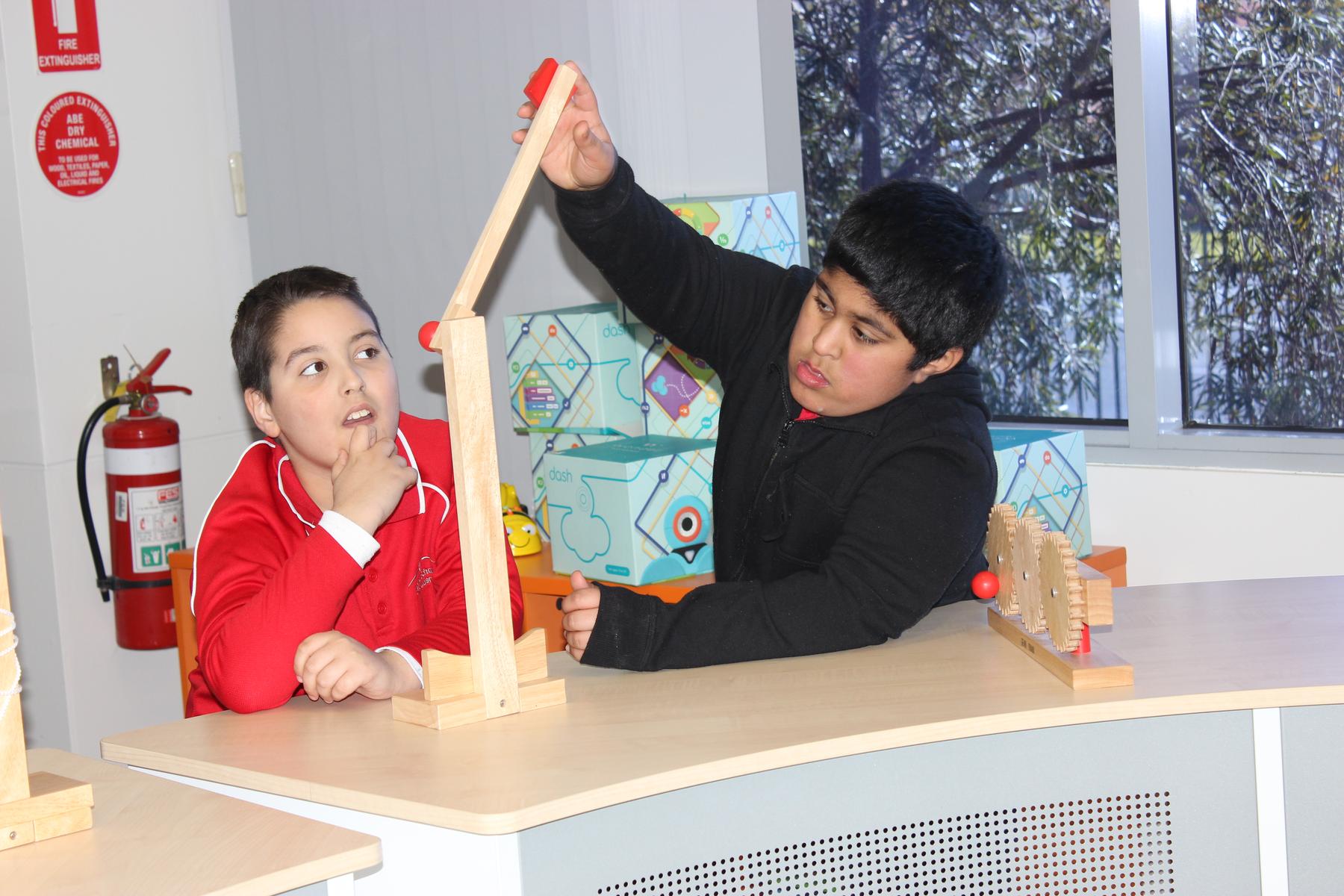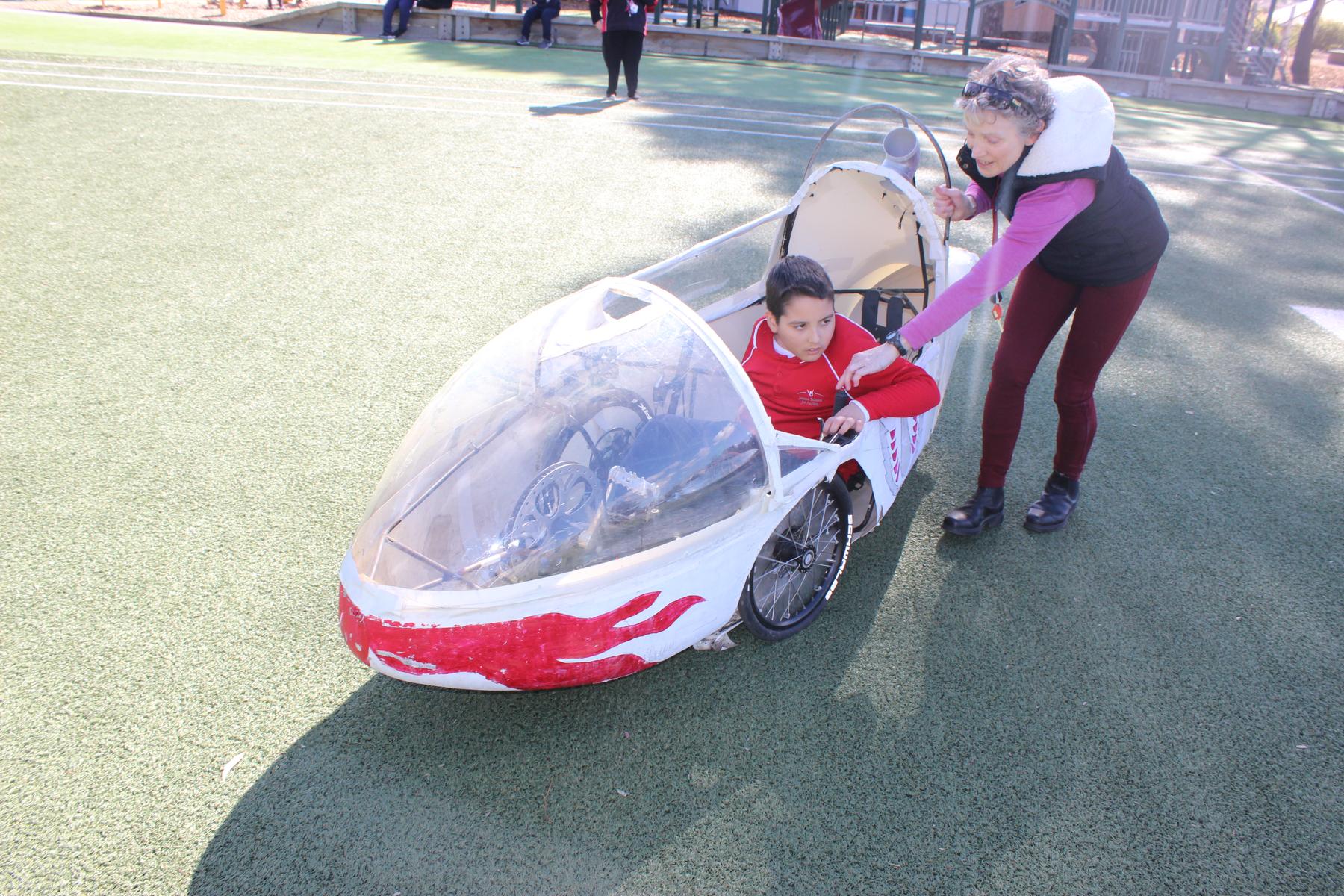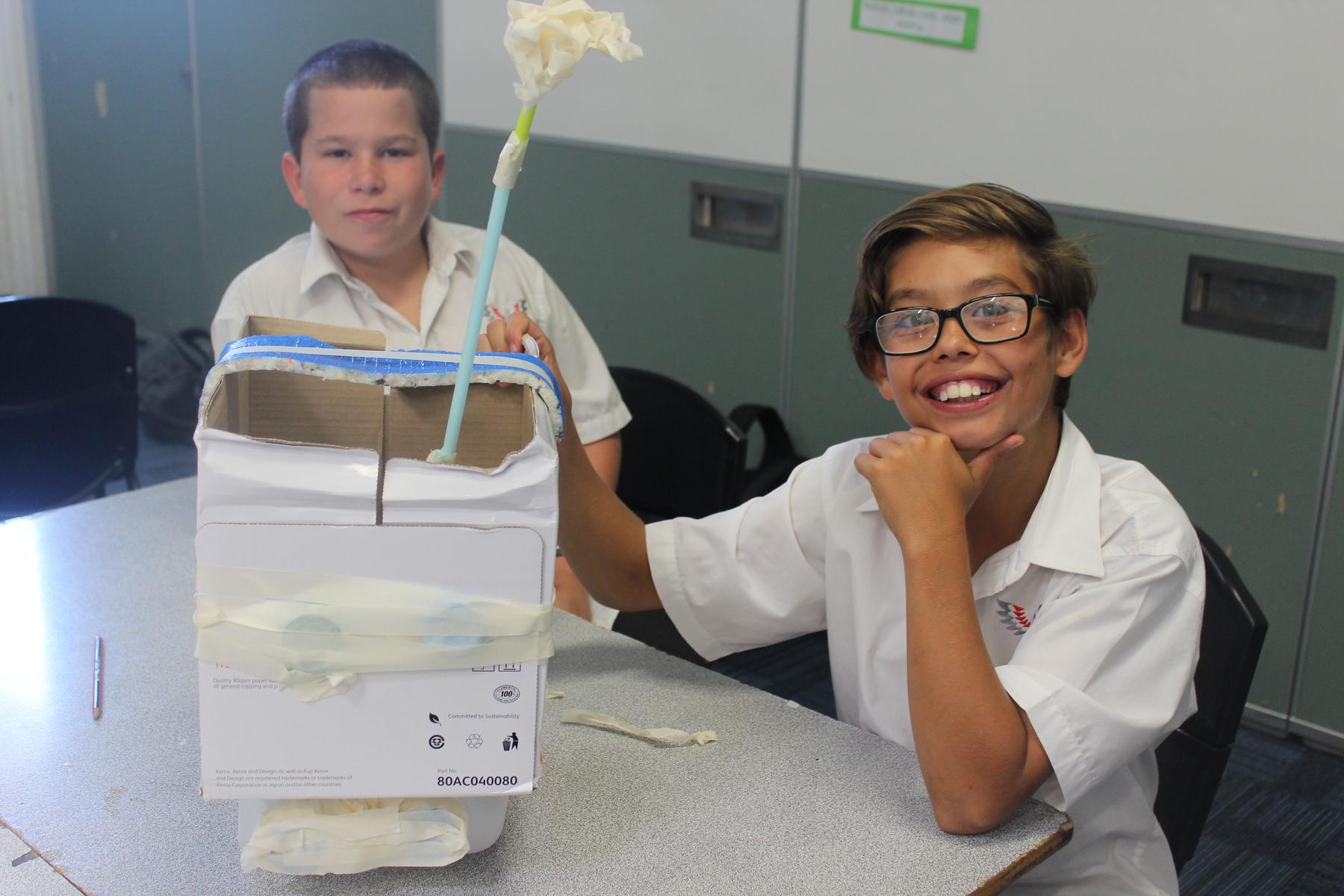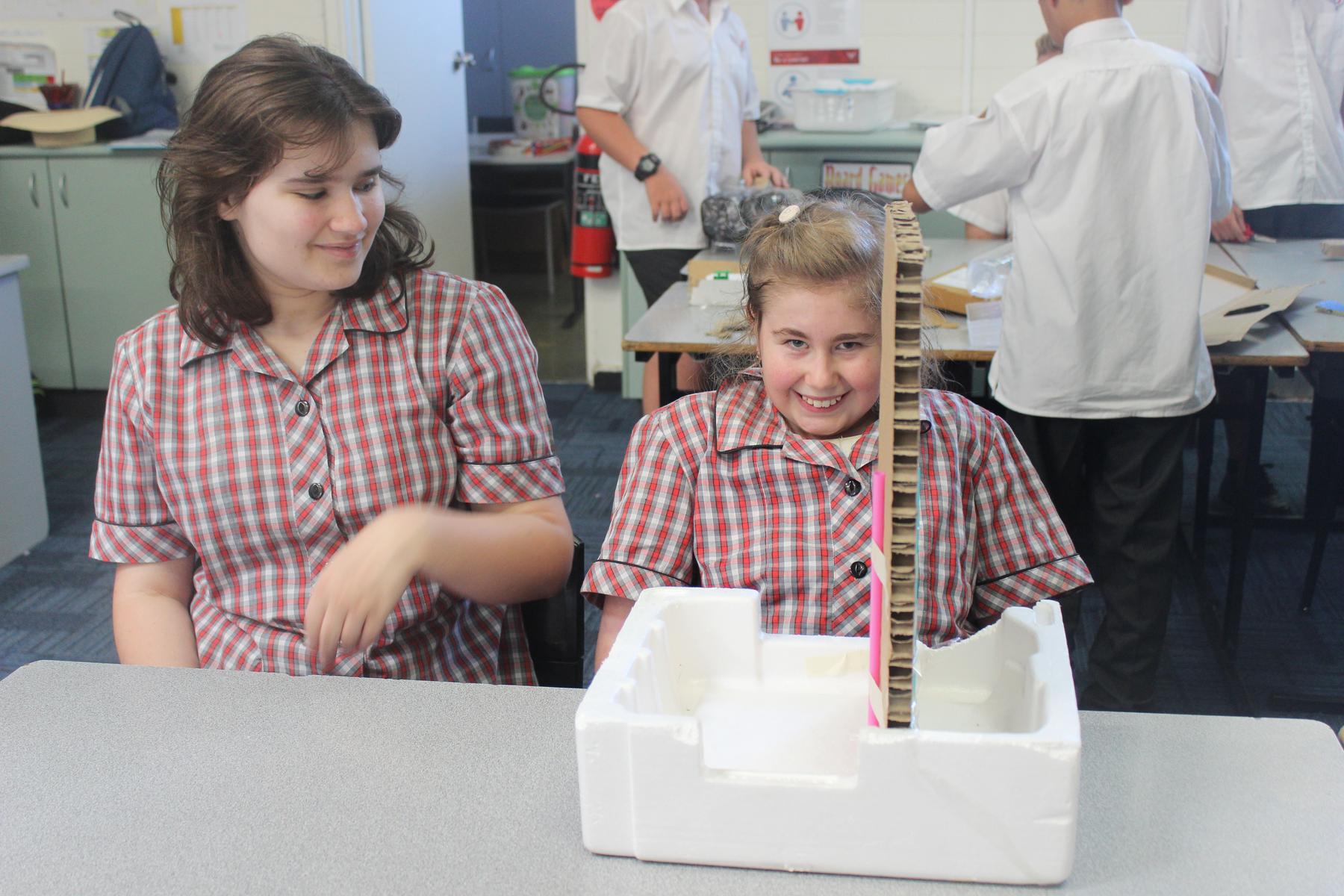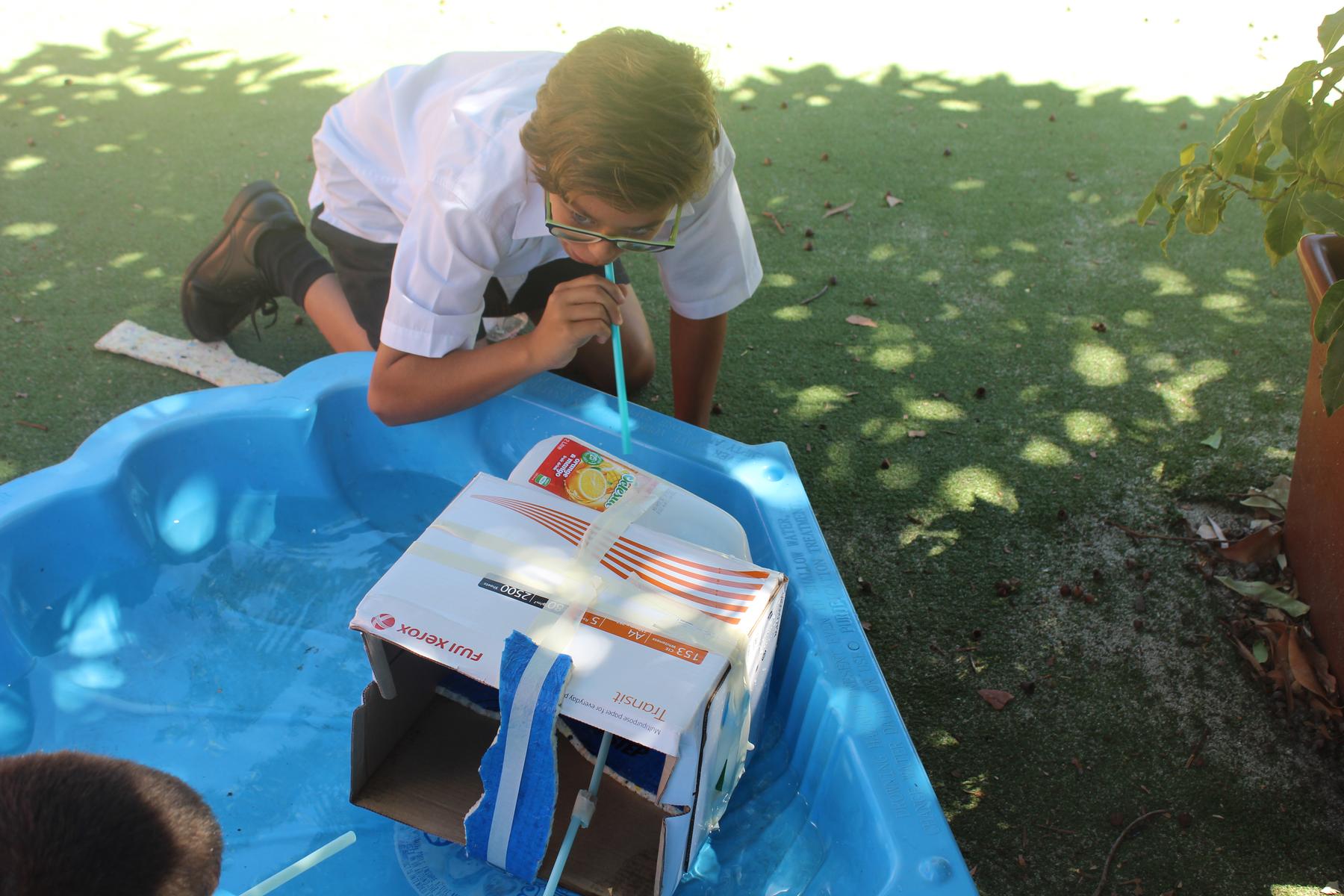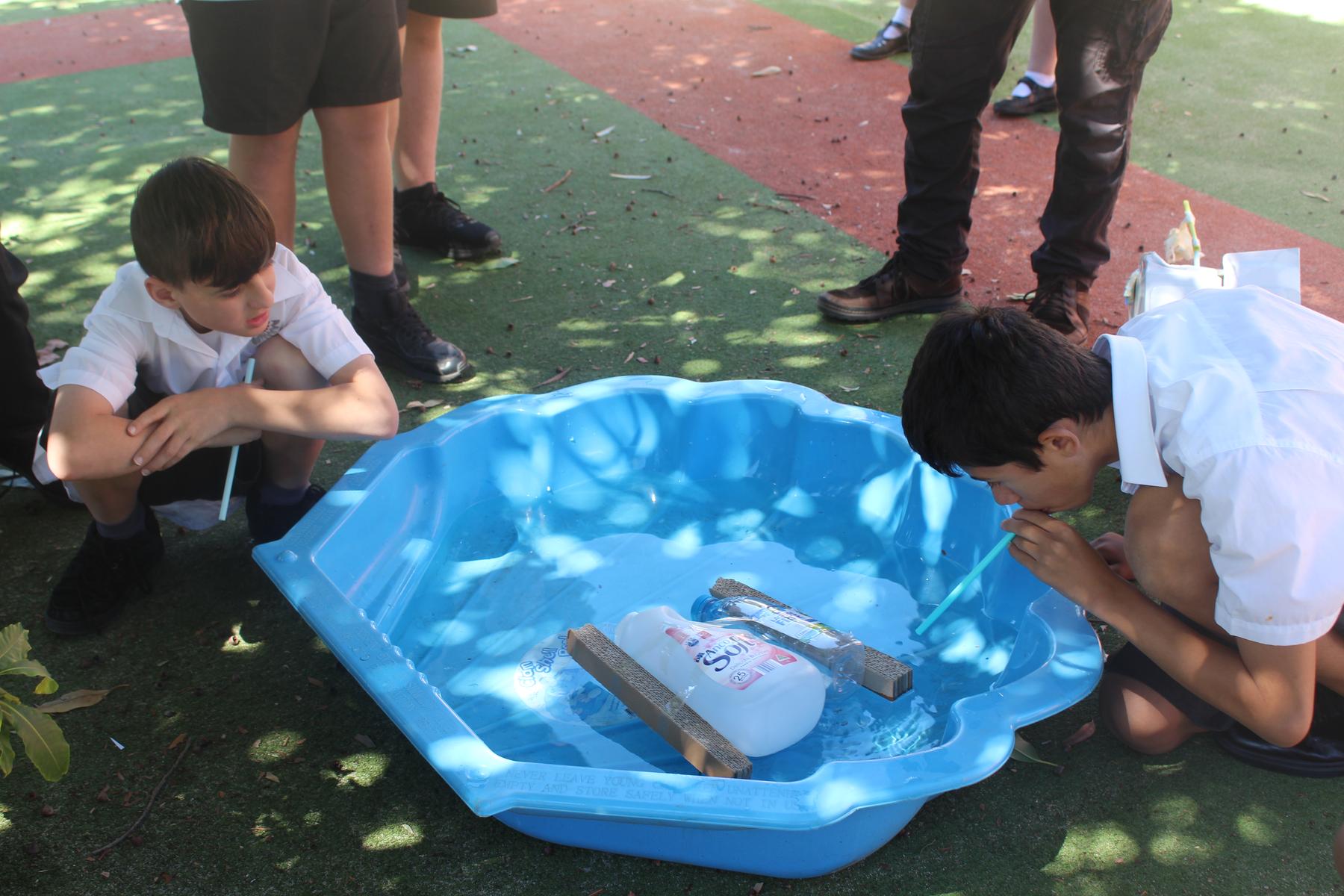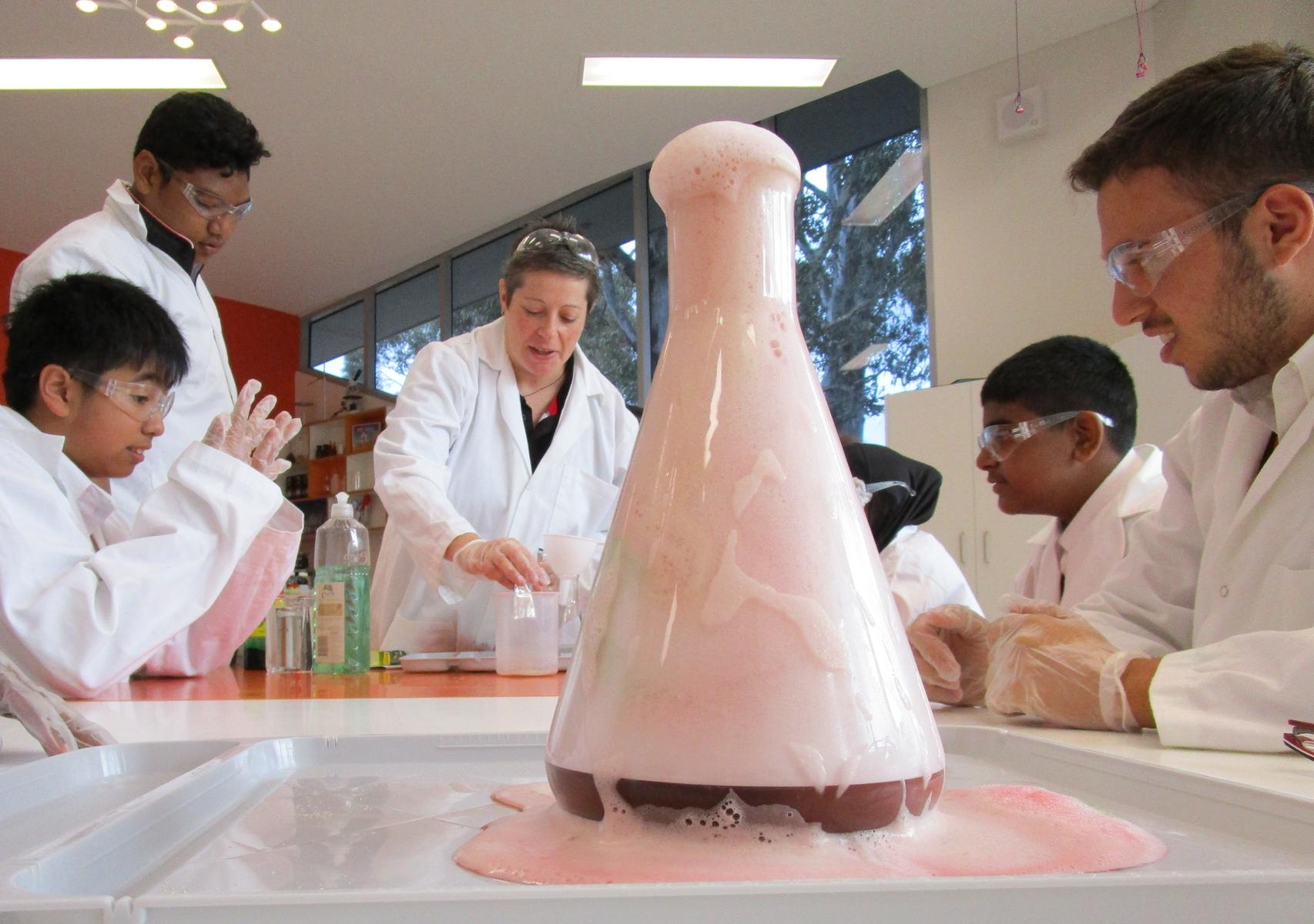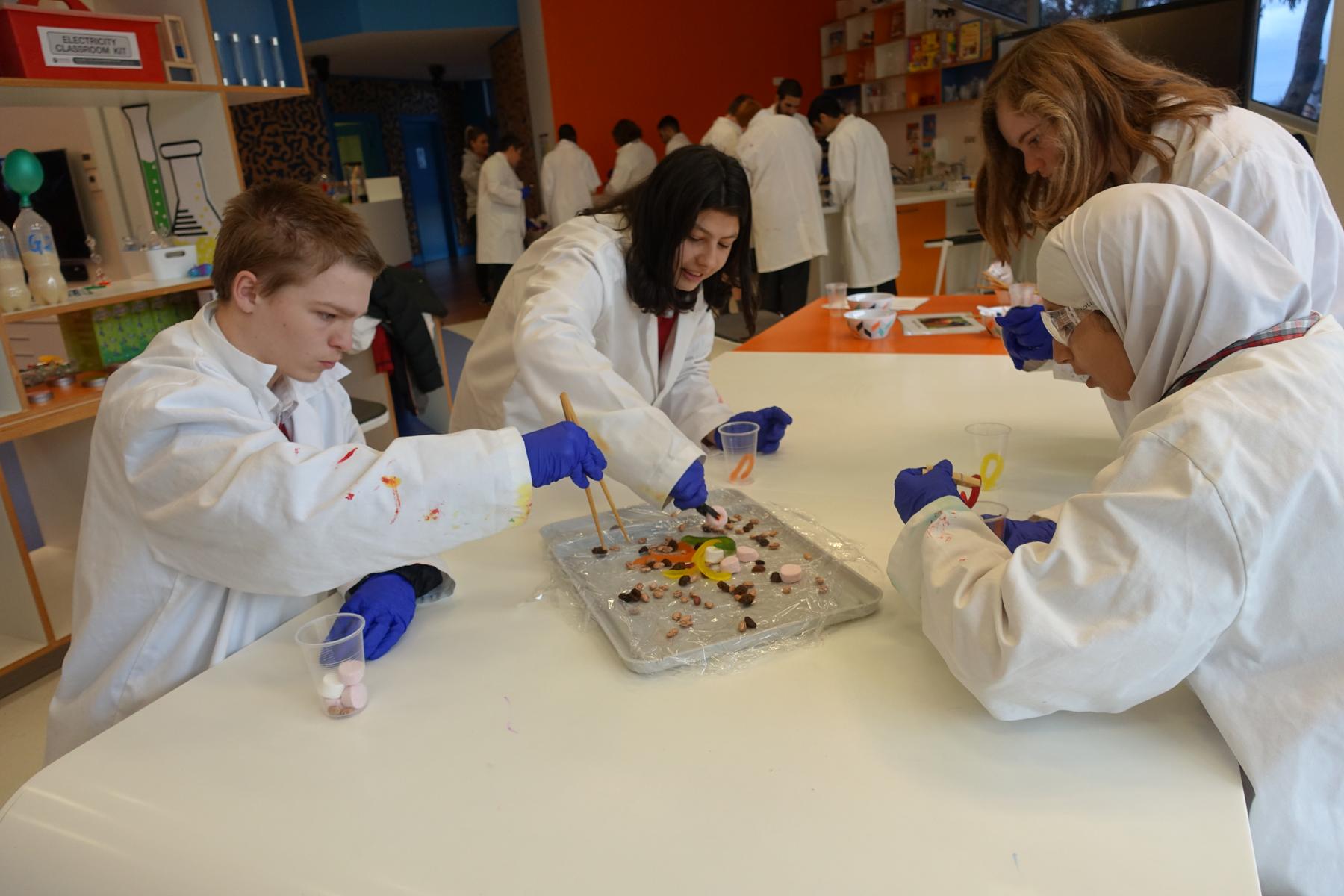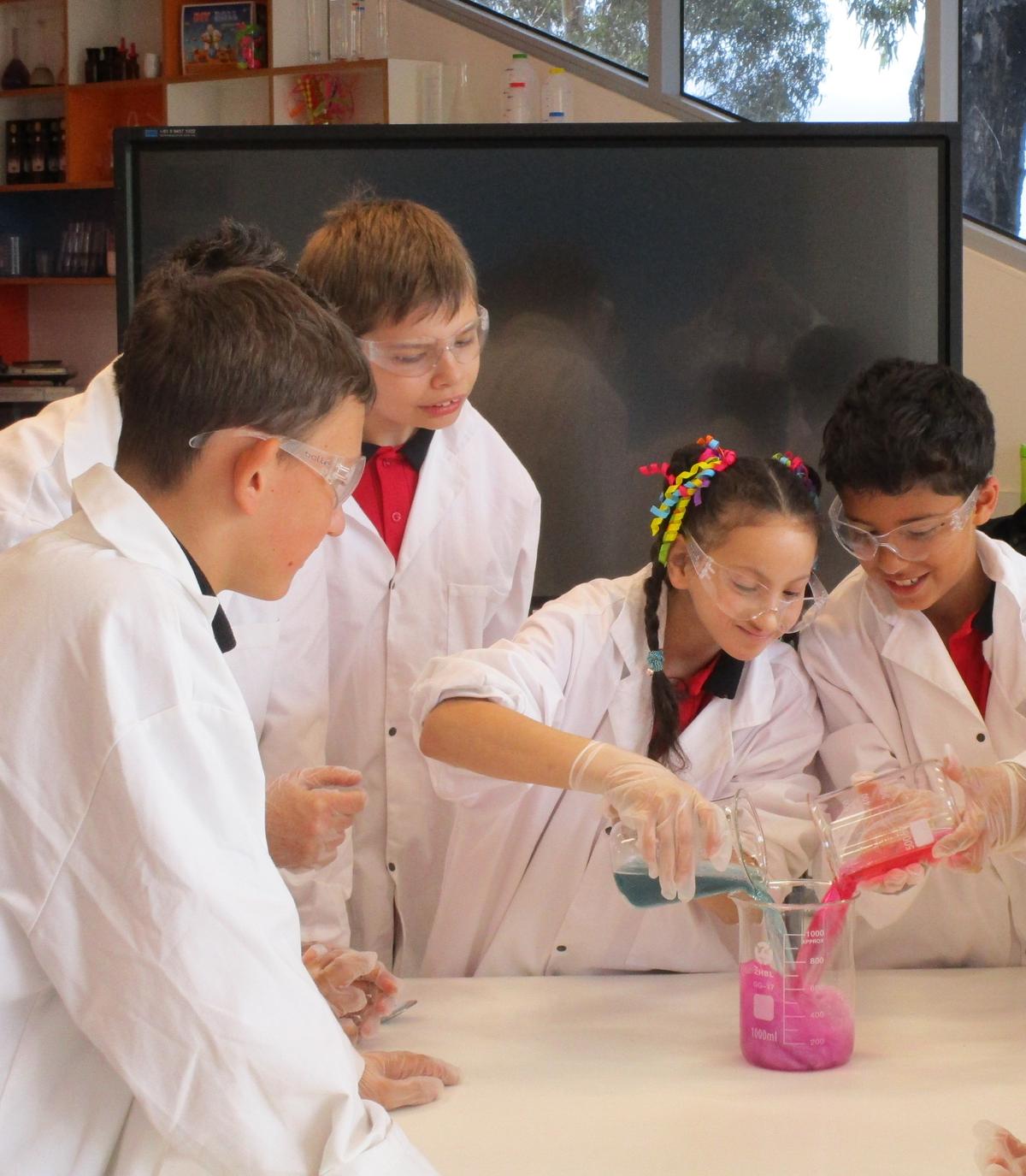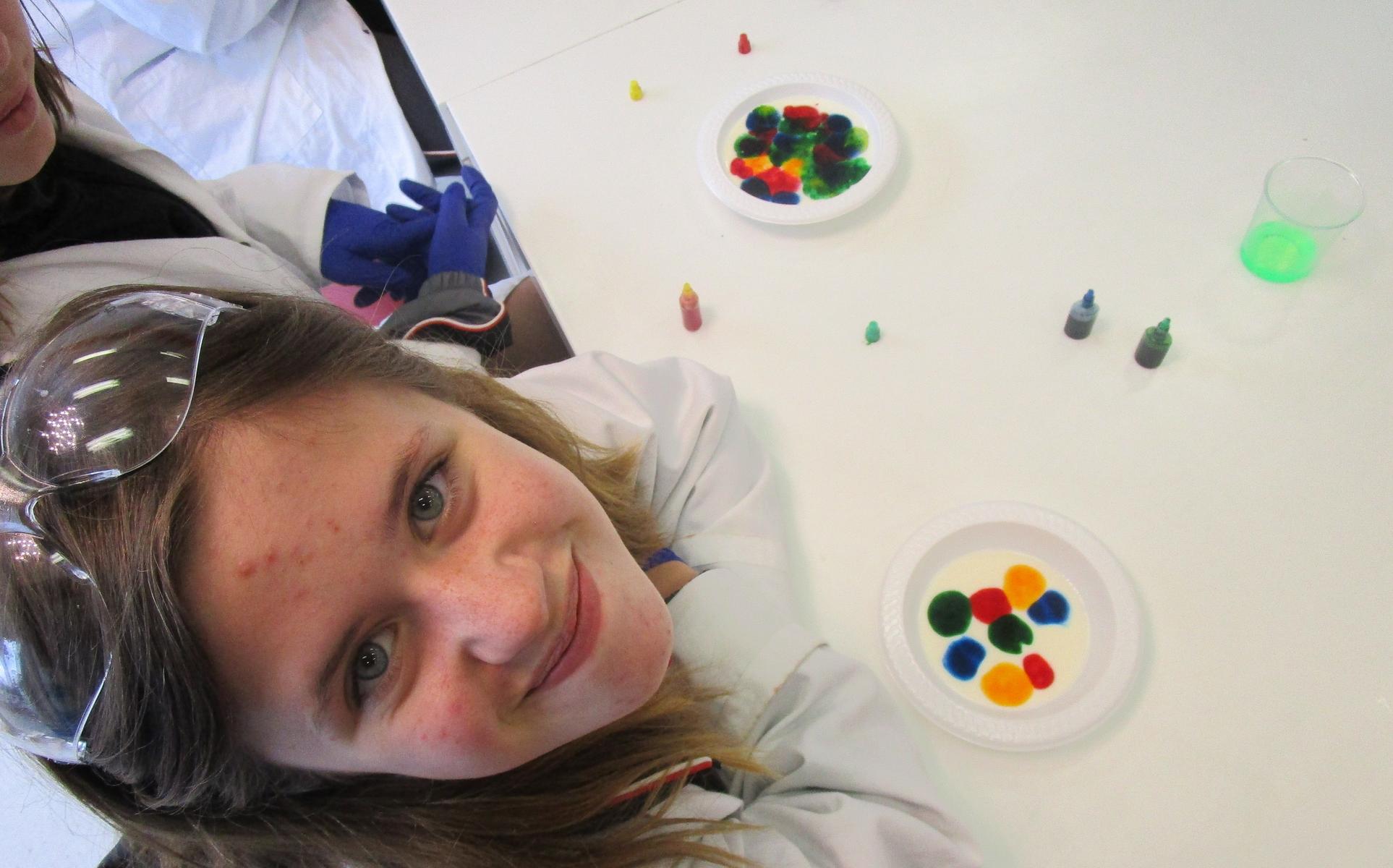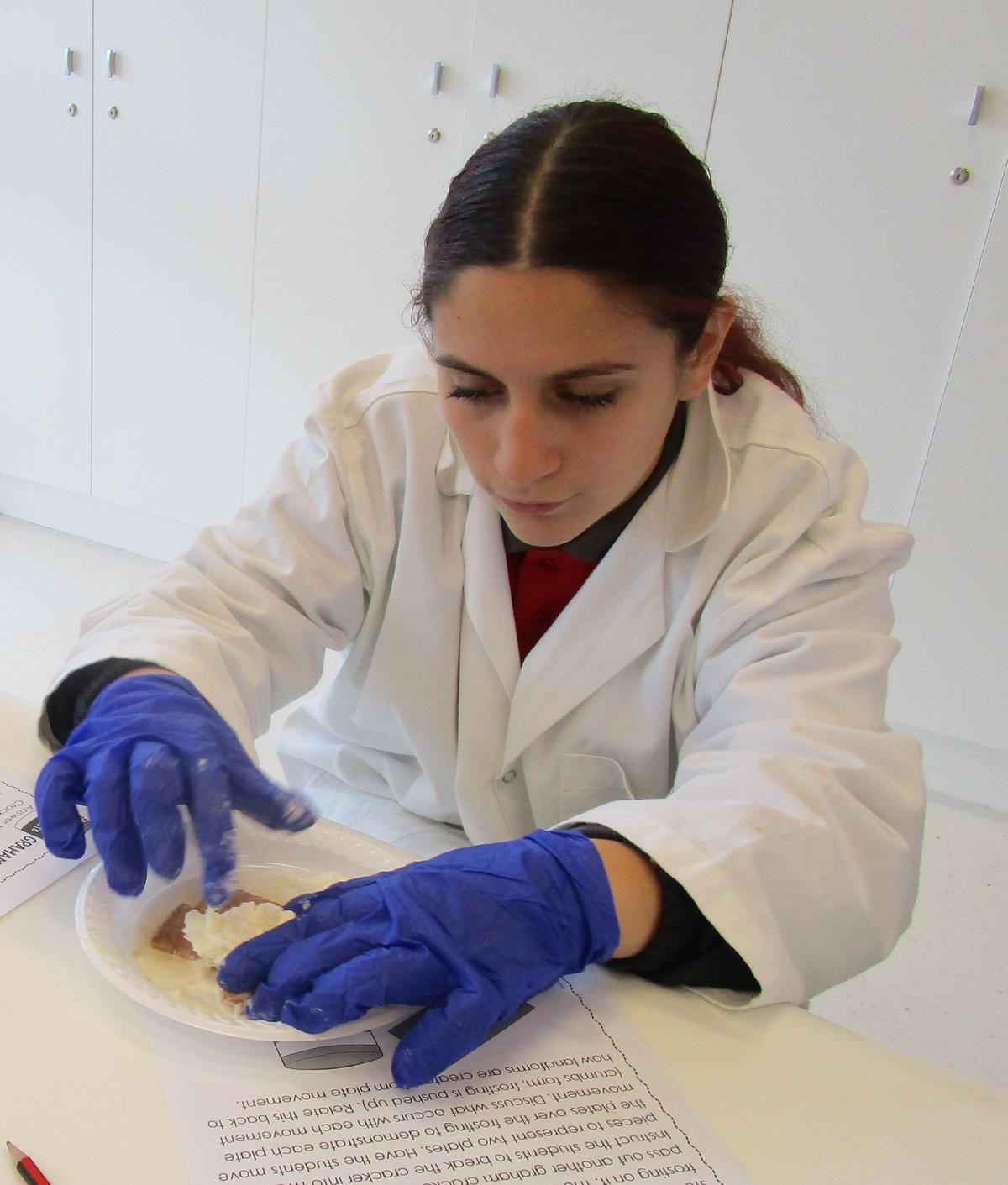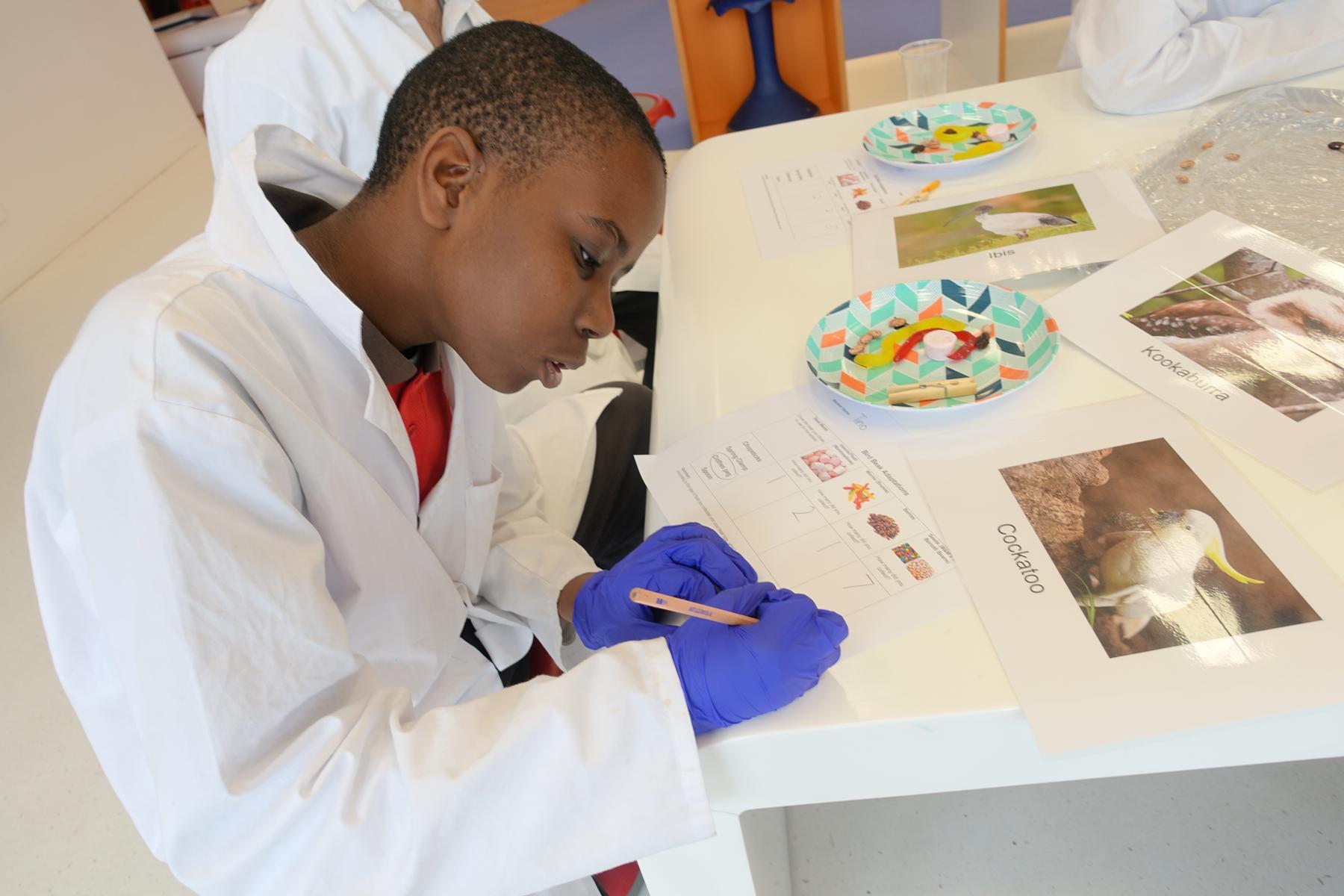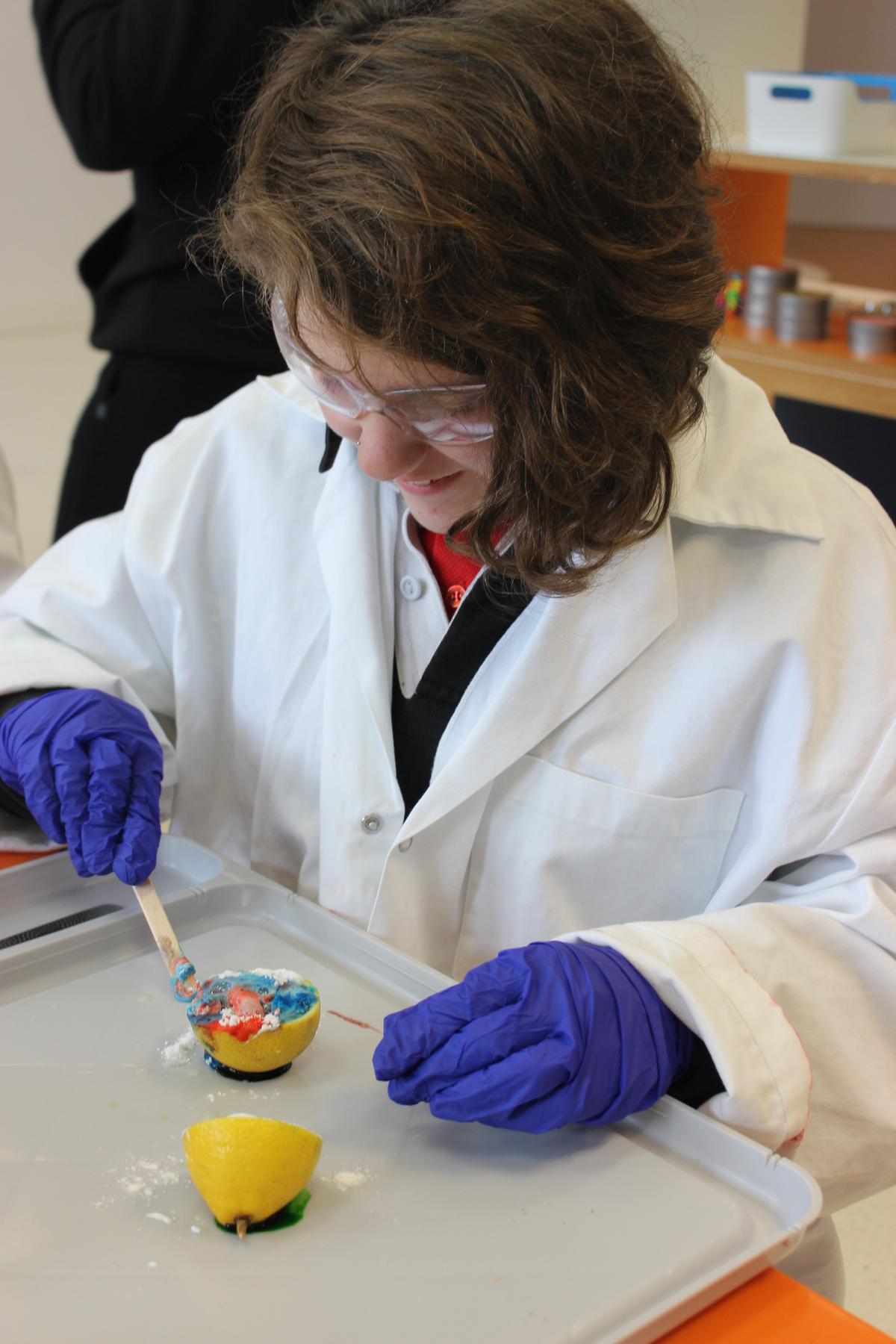Teaching and Learning
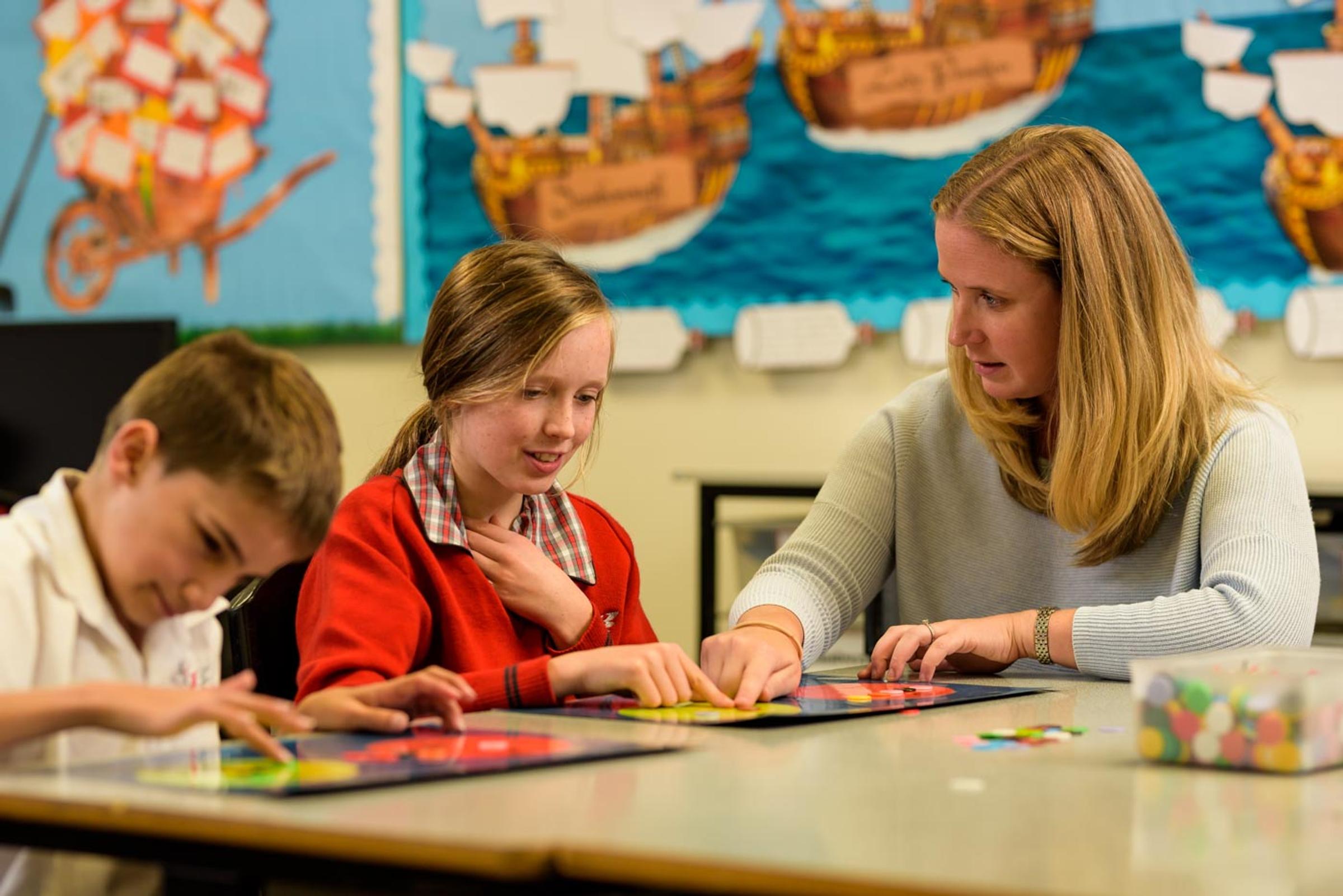
English- Writing
Students have enjoyed making and baking fluffy slime, pancakes, noodles popcorn and much more as they explored the features and structure of procedural writing. After an intense five weeks’ focus on procedural text all F-10 completed a common assessment procedural writing task. I’m pleased to report that most students were able to demonstrate effective procedural structures and language features in their writing. Early writers experienced a simple procedure and identified the materials they needed. Other students sequenced pictures and/or picture sentences. More confident writers used a template and wrote three or more sequenced procedures using their own words. More advanced writers wrote the goal and materials, drew and labelled pictures or diagrams, completed four or more procedural/chronological steps having action verbs, connective language and adverbs to qualify the verbs. e.g. ‘butter the golden toast evenly…’
The assessment tasks varied in content across the sections to reflect the age and needs of the students. All students experienced a familiar process and drew on their prior knowledge to write their procedure. Primary students completed a basic food preparation procedure, Secondary 7-10 students constructed procedures linked to their Integrated Units on heating and melting or the transfer of chemical and electric energy. Whilst VCAL students created procedures related to their current Work Related Skills.
All classes have now completed work on procedural texts and Primary students will focus on descriptive writing in the coming weeks, whilst Secondary students will focus on explanatory text.
The purpose of descriptive writing is to describe a person, place or thing in such a way that a picture is formed in the reader's mind. There are many examples of descriptive writing, they occur in factual reports, personal and imaginative writing and poetry. Primary students will begin developing their descriptive skills through a focus on oracy skills linked to language experiences.
For example:
- dipping into a feely bag and describing familiar objects and textures.
- taking objects out of a mystery box and matching the object with descriptive words
- blind-folded tasting- describing the taste, texture, temperature of food or liquid
- moving through an obstacle course and describing the movements over the course (e.g. down a dark tunnel, around a soft beanbag, over a tall stool)
- viewing a video or photo and selecting or expressing an adjective to describe an object, experience and/or event.
Over the next few weeks Primary students will engage in many integrated and language learning experiences where they will build their sensory observation and descriptive language using visual prompts. Amongst other activities, they will match pictures of objects and people with various properties and attributes. Teachers will model responding to and writing descriptive text, they will co-construct text and guide students to write descriptive words, phrases and sentences related to their interests and to their language experiences. You can help your child with their descriptive language by engaging them in activities at home and asking them questions such as: What does it look like? What does it smell like? What does it taste like? What does it feel like? What does it do? Tell me about it? Can you describe what you see?
The purpose of explanatory text is to account for why things are as they are or how/why something occurs. There are different types of explanation; some describe natural sequential phenomenon, others link cause and effect and many refer to mechanical, biological, behavioural or technical processes. Although common examples of this text refer to factual or informational writing, it has a place in imaginative or creative writng such as poetry. Often explanatory structure contains a title, introduction, description and conclusion. There may also be a series of events that relate to time or cause or both and there is usually visual text such as diagrams, pics and flow charts to enhance the written text.
Key language features include:
- present tense
- third person
- connectives to show time; then, after, several weeks later etc.
- technical vocab
The initial focus will be building students’ prior knowledge of explanations and help them inquire into the structure and organisational features of explanation.
Students will:
- create Wordles and/or posters using key terms/vocabulary
- add key terms and vocab to the VCOP wall or language anchor chart
- explore a range of explanatory text to identify types, layouts and features
- compare explanatory and procedural text using a graphic organiser e.g. Venn Diagram
- identify the author’s purpose
Later in the term students will use graphic organisers to develop shared explanatory texts. They will often use content from their integrated unit research or experiences to practise their explanatory writing skills.
In teacher groups they will be guided to:-
- research,
- organise information
- plan and draft using appropriate vocabulary
- create suitable visual texts and
- revise, edit and publish a completed explanatory text.
Towards the end of the term many students will independently plan, draft, edit and publish their own explanatory text related to the Integrated Unit or to personal research.
Reading and Viewing
Primary students are focussed on developing their phonological awareness, phonemic awareness, phonics and word knowledge for the next four weeks. Phonological awareness is the ability to hear, identify and manipulate the sounds of spoken language. Phonemic awareness is the ability to identify, think about, and work with the individual sounds (phonemes) in spoken words.
Phonics is basically the relationship between speech sounds (phonemes) and their symbols or letter patterns (graphemes). When reading, children need to "break the code" of written language, as well as comprehend texts. Awareness and recall of these sound-letter patterns is important to the development of both reading and spelling.
Across the campuses students have been exposed to many learning activities to build on their knowledge of letter/sounds relationships and expand their bank of sight words:
- recognising environmental sounds
- exploring rhyme and rhythm e.g. repeating rhyming words
- hearing the sounds in spoken language through chants, rhymes, nonsense words, and poetry.
- recognising and ordering letters in their name
- name sorting
- recognising the difference between letters and numbers
- recognising the difference between upper and lowercase letters
- Identifying sounds associated with the beginning letter of words
- blending sounds to make consonant-vowel-consonant words – h/at hat
- two letter initial consonant blends e.g.: fl, cl sl
- playing sound lotto where you listen and recall objects with the same sound
- reading and spelling high frequency words
Secondary students have moved to Word Knowledge over the next 2 weeks. Many classes have explored plural words, synonyms, antonyms, homonyms and homophones (such as their and there), contractions, and have practised efficiently using a dictionary and making word sequences using alliteration.
Mathematics
Classes have just finished their money programs and move onto Multiplication and Division.
The focus on money using relevant place value concepts and addition, subtraction, multiplication and division processes has laid a good foundation for the focus on Multiplication and Division.
Multiplication and division are related arithmetic operations and arise out of everyday experiences. For example, if every member of a family of 7 people eats 5 biscuits, we can calculate 7 × 5 to work out how many biscuits are eaten altogether or we can count by ‘fives’, counting one group of five for each person. In many situations children will use their hands for multiples of five. For whole numbers, multiplication is equivalent to repeated addition and is often introduced using repeated addition activities. It is important, though that children see multiplication as much more than repeated addition.
Students make the first step into the multiplicative world by using concrete objects to act out grouping and sharing situations. Their strategy to solve multiplicative problems is often to make the groups with concrete objects such as counters and ‘count all’. For division situations young children may physically share objects. The need for formal strategies comes later, usually because larger numbers are involved, and once the child has acquired some mental strategies for addition and subtraction. For multiplication, the ability to break numbers apart in flexible ways is even more important than in addition or subtraction. However there are some useful foundations necessary for multiplication and division of whole numbers: Firstly some experience with forwards and backwards skip-counting. Secondly some experience doubling and halving small numbers.
A learning progression for multiplication and division includes the following skills:
- Make ‘groups, ‘lots’ and groups of ‘one’ and can indicate which collection has more than the other.
- Distribute objects to each person in a group until there are no objects left.
- Indicate when groups of less than 10 objects are the same or different in number and that two collections have the ‘same’ quantity by matching items one to one
- Use verbal action stories to model equal groups of objects.
- Relate the initial repeated addition conception to grouping objects into equal sized groups. e.g. 4 marbles in each bag. 2 bags. How many marbles altogether? 2 fours are 8 (to 10)
- Relate the initial repeated addition conception to grouping objects into equal sizes to 20
- Use groups of like materials to develop awareness of multiplication as repeated addition using arrays to model problem situations.
- Describe and calculate simple multiplication as repeated addition (e.g. 3X5 = 5+5+5) Use counters in arrays to match the problem situation. Describe arrays in terms of rows and number in each row.
- Recognise and use the commutative property of multiplication e.g. 3x4 is the same as 4x3 or in array form
- Use symbols to represent arrays for multiplication by single digits.
- Automatic recall of multiplication facts when multiplying by 2, 5 and 10 (3 second fluency)
- Solve word problems by using number sentences involving multiplication.
- Automatic recall of multiplication facts when multiplying by using doubling, double-doubling double and 1 more and building on known facts
- Multiply 2 digit to multi digit numbers using the formal algorithm and recording
- Multiply whole numbers and decimal numbers using the formal algorithm
Initial activities to develop these skills will include:
- Building on prior knowledge by finding out what students know
- Looking at real examples of multiplication in pavement patterns, egg cartons, chocolate blocks, cake tins, boxes of matches etc.
- Making anchor charts, portfolios or using Maths Journals to build vocabulary, strategies and skills
- Practising skip counting
- Engaging in action stories where students share or group material in practical situations so everyone has the same amount
- Making equal groups with counters, blocks, paper clips, icy pole sticks etc.
and discussing/recording the number of groups, the size of each group and the total.
- Sharing sets of objects, such as packets of sweets, equally between a small group of people using one-to-one correspondence
- Demonstrating repeated addition when solving simple everyday problems
- Identifying mental strategies that will help with multiplication and division e.g. doubling, halving
- Model number stories in multiple ways showing repeated addition, skip counting, number lines, area models and arrays
- Playing board games using grouping and sharing processes
- Solving problems using task cards and explaining how they worked out the answer.
- Using digital technology such as Ipad apps and Mathletics to practise skills
Measurement and Geometry
This week classes wound up their teaching of Shape and moved onto learning about Length. This unit will be taught over the next five weeks. Students will learn about the key understandings in length.
They will:
- compare two objects and use appropriate language to compare length
- use direct and indirect comparisons to decide which is longer, and explain their reasoning in everyday language such as longer, shorter etc.
- measure and compare the lengths of pairs of objects using uniform informal units
- estimate and measure length using informal units
- understanding that in order to compare objects, the unit of measurement must be the same size
- measure, order and compare objects using familiar metric units of length
Students in the early stages will learn what ‘long’ and ‘short’ means by comparing objects. Next students will learn how to order 3 objects by measuring them against each other. They will be explicitly taught to use suitable language such as same, long, short, tall and taller. After that students will use a range of uniform informal units such as icy pole sticks, blocks and paper clips to estimate and then determine which objects are longer. They are taught how to measure accurately, knowing where to start measuring, leaving no gaps between uniform units and learning where to finish measuring. They also taught to compare lengths using uniform hand spans, fingers and pieces of string. They learn to make judgements about the appropriateness of some informal units for measuring certain lengths e.g. using paper clips for books or small objects and string for longer lengths such as the width of the room. More skilled students recognise the importance of using common units of measurement. They are taught to recognise and use centimetres and metres to estimate and measure length. Students at this level may be given real life building project challenges to apply their skills and extend their measurement capabilities.
Over the next few weeks all students will build on their prior knowledge of length and will demonstrate and record their learning in multiple ways using hands on materials and multi-media. Many classes will create anchor charts and/or keep maths journals and/or portfolios to record their incremental learning on length, throughout this unit.
Integrated Studies
Students are immersing themselves fully in new and exciting Integrated Unit inquiries related to the Change theme.
Lower Primary students are investigating the Weather and how weather affects their lives.
They are using their senses to develop understandings and concepts about the weather.
Students have been busy:
- chanting rhymes and singing songs about the weather r
- observing the weather outside the classroom.
- Inventing and using weather symbols
- contributing to word walls with descriptive words
- tracking the weather in a weather journal.
As the unit progresses students will investigate particular types of weather and seasons. They will explore expected weather patterns and reflect on how that weather affects what we eat, wear and do.
Upper Primary students continued to "Spot the Difference" in Science. They are exploring change through the context of food and other materials including spaghetti, chocolate and popcorn. So far they have been:
- comparing the features of uncooked spaghetti: its smell, feel and appearance
- making 3D towers with uncooked spaghetti
- creating pictures of Sam the Spaghetti Man
- comparing popped corn and corn kernels
- observing chemical changes when you mix milk, dishwashing liquid and food dye together
- comparing hot and cold water and seeing what happens to icy poles left outside
- reflecting on reversible and non-reversible change
Secondary Yr. 7/8 students are exploring Heating and Melting in order to find out how solids or liquids are influenced by temperature. They are discovering how and why items from their everyday lives can change.
They have been doing some fun hands on activities and experiments such as:
- “commit and toss” game where their toss around their ideas about how heat is made
- cooking an egg to learn about how the heat is made and the states of change that happened with the water and egg.
- melting chocolate or dissolving sugar in hot or cold water to compare the effect
- ‘Ice Race’ experiment where students had to work out the best way to melt the ice block.
Over the next few weeks some classes will start researching a Heating and Melting Expo product for next term. Based on the students’ current interest and enthusiasm for this inquiry I’m guessing there will be some mouth water products for sale at this year’s Expo!
In Secondary 9/10 three classes are investigating Electricity and the other three classes re are delving into Changing State. The focus switches in Term 4 so that all students cover the key Change inquiry units. There has been lots of excitement in the Electricity sessions as students created static electricity using balloons and hair as well las combs and tissue paper. They are beginning to research different sources of energy and plan experiences to demonstrate different kinds of energy. Meanwhile, the Changing State groups have acted like mad scientists making oobleck and puzzling over reversible and irreversible change.
PreCAL classes initially kicked off their Leisure unit focusing on hobbies connected to cooking. Classes have applied their knowledge of procedural texts as they visited local shopping centres to buy ingredients to bring back to school and cook. They have both followed and created procedural text to get to the centres and to follow a recipe.
Over the past two weeks, Reverse Art Truck in Ringwood proved a great venue for Secondary 9/10 PreCAL students to choose items for a craft hobby focus. Students returned to school with a show bag of recycled items that they selected. Already I’ve been amazed by the creative designs students have created.
Secondary 7/8 PreCAL students have already made a head start with their craft hobby projects. Last week they made many attractively designed heat bags for the term 4, Year 7/8 Expo. This involved; shopping for the heat bags items, measuring and cutting the material for the bags, pouring the rice into the sewn bags and sewing up the corners. The bags are ready to go! Now they have started planning how to make and resource their next Expo product ‘scented soap.’ I want be there when they start making and packaging that unique craft project!
Last week I captured Year 12, SSS students busy at work running the Thursday school canteen. It was pleasing to see how well they worked together as a team to prepare the lunch orders for the entire school. These students are certainly getting a taste of the Hospitality industry. They demonstrated excellent food handling standards and were well aware of the OHS requirements for this kind of work.
The lunches were really first class! I certainly relished my baked potatoes and yoghurt order.
Social Competencies
Over the next two weeks students will build on their ‘working in teams ’skills before moving to Drug Education for the remainder of the term. A strong focus for ‘working in teams’ for all Primary students centres on developing daily social competencies with a partner or a team: turn taking, sharing, joining in, manners, winning/losing, helping and apologies. Already classes have practiced playing board games and outdoor games together in partners and/or groups. They’ve listened to each other, talked calmly, taken turns and followed the rules. Students have been supported to behave appropriately in a losing situation. Teachers have modelled and reinforced friendly self-talk to help students accept winning or losing in a game. Some fun games they have played included: Wink Murder, Handwriting Game, Marble Pass, Human Knot Game, Tunnel Ball and the Line-up Game. Some classes have worked as a team to plan a book they want to publish. I was amazed to see and hear some of the creative twists and turns students shared and piggy-backed on. Over the next few weeks students will collaborate to determine what their characters look like, they will agree on how to illustrate the book and will complete the pages together. Some classes plan to record students reading their narrative. I’m looking forward to hearing/viewing these very unique collaborative narratives.
Secondary classes are focussing on understanding what a team is and developing the skills to participate as a partner/team to achieve a goal. The Social Competencies teachers have created challenges that prompt students to engage in positive team work to achieve successful results.
Secondary 7/8 classes are demonstrating teamwork by forming groups to make an iMovie
incorporating the skills needed to be a good team member. All students are expected to help on the project. They need to take on a role and be responsible for script writing, acting, filming and/or narrating. Secondary 9/10 students are also working in teams. They plan to make a stop motion animation retelling a fairy-tale. Teachers will encourage students to discuss the roles during the shooting process (e.g. taking photos, moving the characters or directing the action). Students may be prompted to swap roles part way through and share expertise as needed.
Most of the Secondary11/12 classes have already started learning about what drugs are, which ones are legal or illegal, and how they impact physically and mentally on us. They have listed and sorted drugs into those that are stimulants, hallucinogenic and depressants. They have, also, looked at targeted videos on drug use and worked in pairs to write a myth or a fact about drugs. Many students have created posters that express what they know and think about drug use.
The content for Drug Education program varies depending on the student’s age and maturity. The order of the key understandings are:
- everything that enters one’s body has an effect
- the concept of the definition of a drug
- legal drugs and related issues
- illegal drugs and related issues
- laws regarding legal and illegal drug use
- the implications of drug use/abuse on the individual and society laws regarding legal and illegal drug use
Primary students will explore the different substances that enter the body and investigate the safety of certain drugs. Secondary students will explore substances that help your body function and those that change the way your body works. They will discover the emotional and physical changes that can occur in your body when taking drugs. Strategies to keep safe will be covered by both Primary and Secondary students. Older students will investigate legal and illegal drugs, the laws regarding drug use and the implications on individuals and society.
Spotlight on Science and Technology
Science Elective
Operating out of the Discovery Centre in 2018, Secondary7/8 and Secondary 9/10 students have enthusiastically participated in a new hands on science class as part of the Specialist Elective program. Incorporating aspects of S.T.E.A.M, all science groups have the opportunity to participate in a range of guided investigations linked to specific content areas, catering for a variety of learning styles and ability levels. Student voice has been incorporated into each program, with students contributing their ideas and feedback to help make the program both engaging and relevant to their interests. At the beginning of each term, all classes have been required to undertake a science safety session and students sign a safety agreement before commencing practical activities.
All Secondary 7/8 classes are participating in the Extraordinary Experiments elective. Students are participating in a range of hands on chemical and physical science experiments including; Science Safety, Mad Mixtures, Amazing Milk, Sticky Ice, Exploding Volcanoes, Balloon Rockets, Fountain Air Pressure Trick, Make Water Float and Sink, Pepper Swim Away, Crazy Putty, Slime, Blowing up a Balloon with a Chemical Reaction, Bath Bombs and Lava in a Cup.
Secondary 9/10 students have chosen between four units of study; Chemistry Chaos, Earth: The Active Planet, Becoming a Scientist and Wildlife Warriors. The most popular practical activities so far have included; Testing household acids and bases using a red cabbage indicator, Endothermic and Exothermic Reactions, making a model of the Earth, making dinosaur fossils, Biscuit Plate Tectonics, Erupting Lemons, Micro Powerhouse, Popsicle Stick Catapults, Fingerprint Forensics and Film Canister Rockets.
Construction Elective
During Construction classes this year, students are exposed to a variety of hands on construction activities and materials. These vary between open-ended tasks utilising recyclable materials, modelling clay and plasticine, to build and test their own designs. They also use more structured engaging materials such as Strawbees and Argo Architect.
Argo Architect activity cards allow students to follow a design, applying creative thinking, problem solving and fine motor skills. Students learn how to connect straws to each other using a connect and lock system when using the Strawbees Construction Kit. Strawbees Construction kit activities provide students with hands-one learning challenges.
Students are enjoying making boats, building bridges and building the tallest structures they can. They have had the opportunity to brainstorm and design ideas as a class. They then build and test their designs, redesigning them where necessary. Students are supported to work effectively in teams, pairs and individually.
It great seeing students fully engaged in problem solving in our Construction classes. I have had the opportunity to observe many students constructing an array of unique designs in this elective.
Science and Technology Visitors
Last week a group of eight Primary students from Jacana visited our Discovery Centre. They were doing an Integrated Unit on ‘Forces and Motion’ and organised a visit to immerse themselves in the topic. Ashley Butler organised a range of hands-on experiences that really engaged our visitors. They worked with the Little Architect construction material and operated the wooden ‘Forces and Motion’ models. They also explored lots of stimulating learning spaces in the Sensory and MILE Room. Ashley and Helen treated the class to a nifty ride in the Human Powered Vehicle on the Concord oval. Some of the students could barely reach the pedals but they all had a red-hot go! As they were leaving Ashley gave them a few discs with photos of the experience and one of the teachers enthusiastically remarked “They will all sleep well on the bus home, after this excitement!
Helen Edmonds
Acting Assistant Principal
